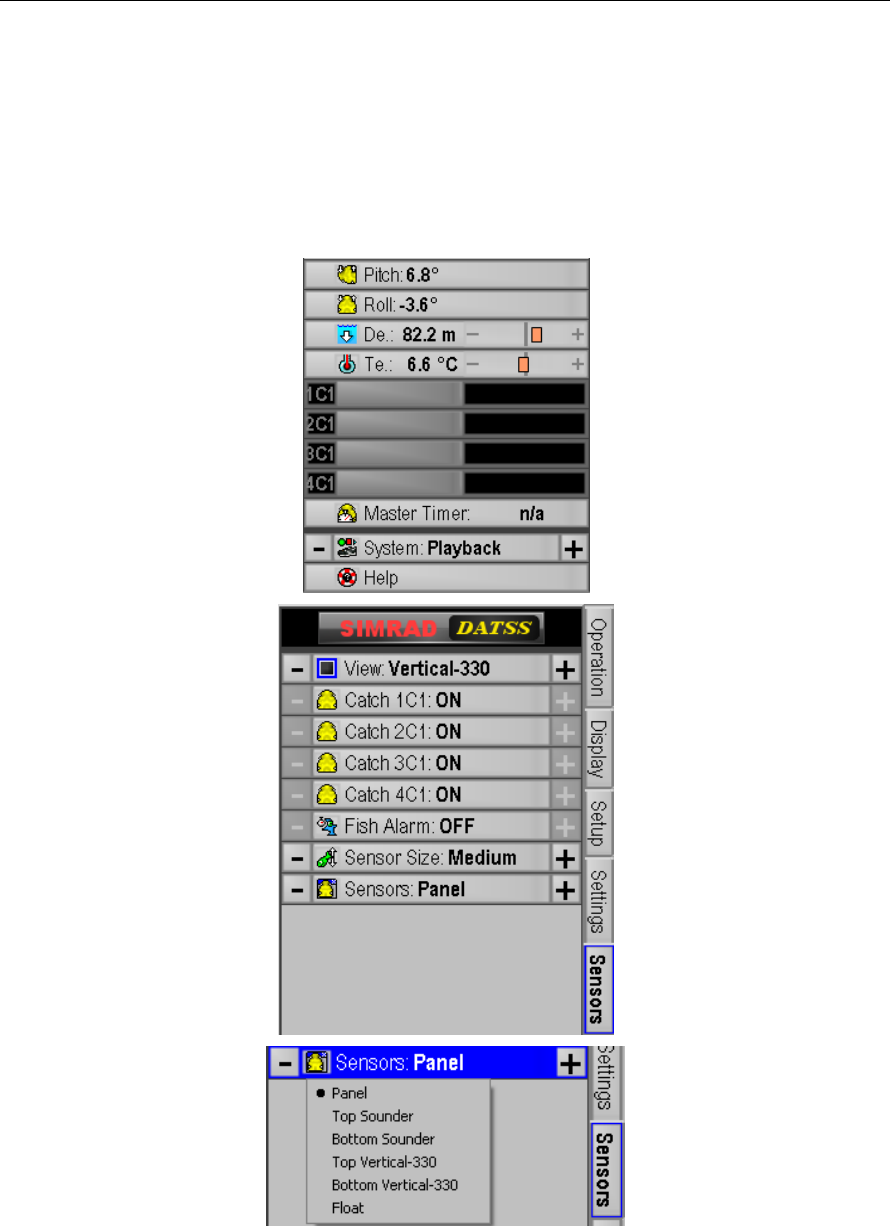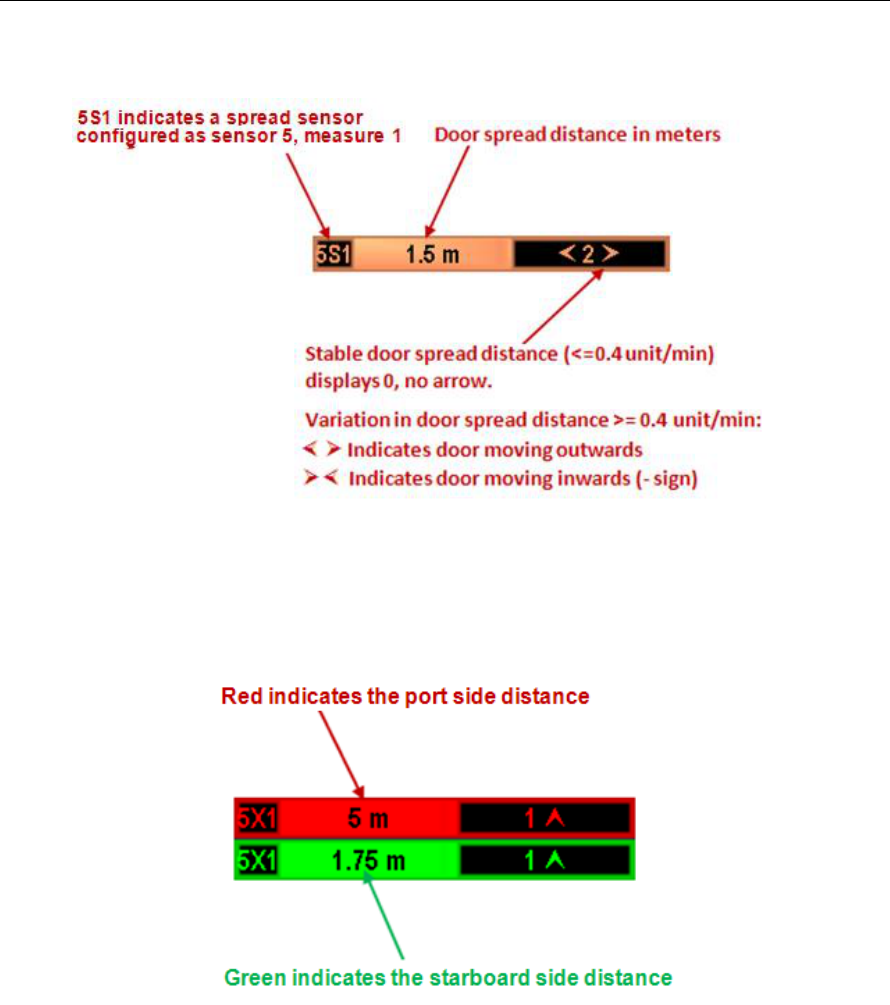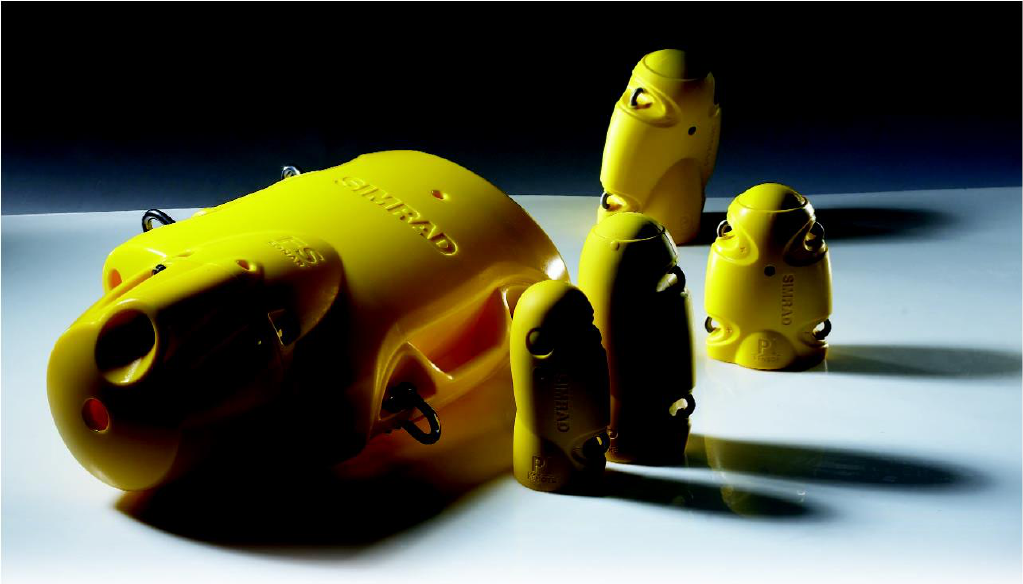
Kongsberg Mesotech Ltd.
Port Coquitlam, BC - Canada
FS 70
Trawl Sonar System
Operator Manual
SIMRAD

974-24007001/5.0 I
974-24007001/5.0
FS70 Trawl Sonar System
Operator manual
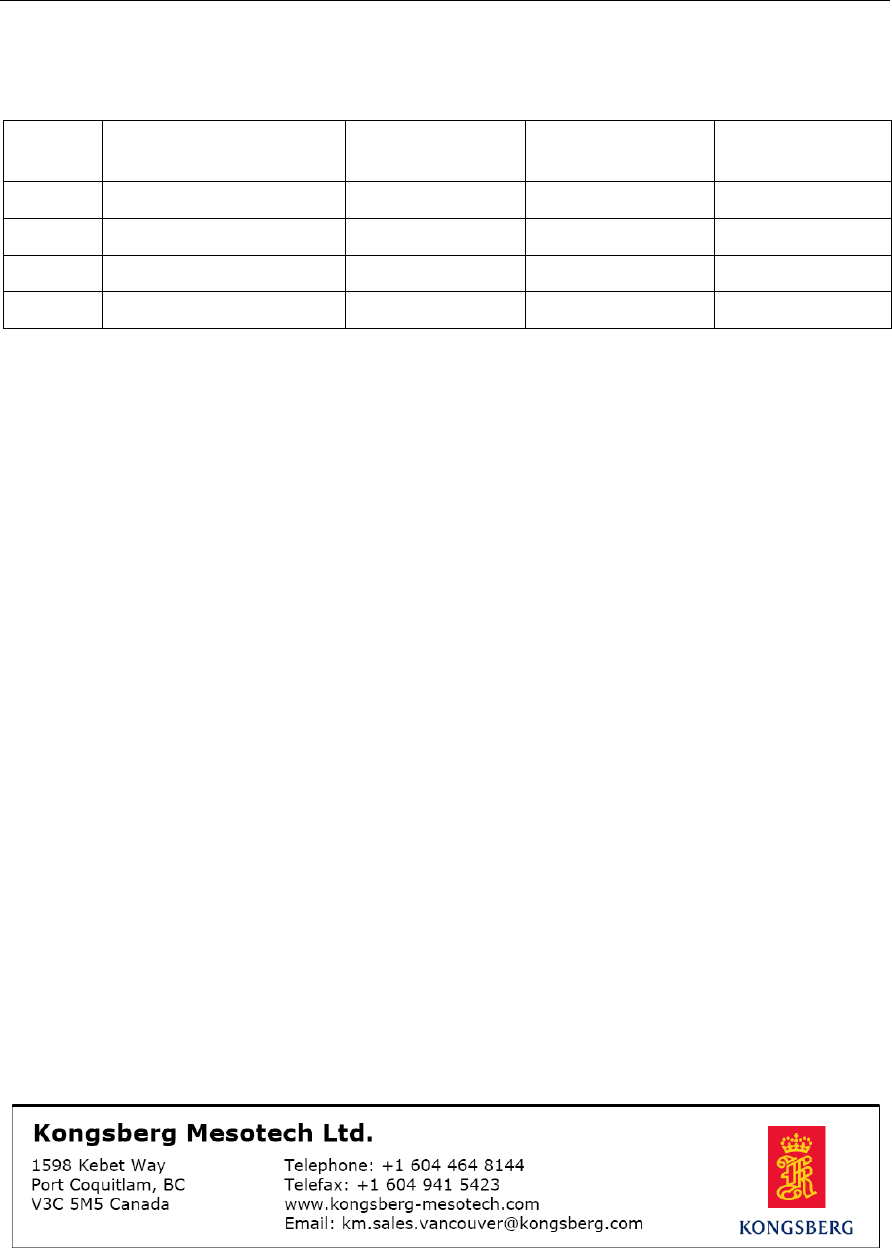
FS70 Trawl Sonar System
II 974-24007001/5.0
Document revisions
Version
Date
Written by
Checked by
Approved by
4.1
January 04, 2011
LF/BC
JH
BC
5.0
February 24, 2016
BC
JH
BC
About this document
The information contained in this document is subject to change without prior notice.
Kongsberg Mesotech Ltd. shall not be liable for errors contained herein, or for incidental or
consequential damages in connection with the furnishing, performance, or use of this
document.
© 2010 Kongsberg Mesotech Ltd. All rights reserved. No part of this work covered by the
copyright hereon may be reproduced or otherwise copied without prior permission from
Kongsberg Mesotech Ltd.

974-24007001/5.0 III
Table of contents
1 SYSTEM FAMILIARIZATION ............................................................................ 1
1.1 Overview ............................................................................................................. 1
1.2 Equipment List .................................................................................................... 2
1.3 Typical System Configurations .......................................................................... 2
1.4 Display Monitor .................................................................................................. 3
1.5 Processor Unit ..................................................................................................... 4
1.6 Power /TTM Interface Module ........................................................................... 4
1.7 Deployment Housing Unit .................................................................................. 4
1.8 Jointing Tool ....................................................................................................... 5
1.9 Catch Sensors ...................................................................................................... 5
1.10 PI Sensors Option ............................................................................................ 5
1.11 Depth, Temperature & Sensors NMEA Output .............................................. 5
1.12 Trawl Cable, Winch and Block ....................................................................... 6
2 THEORY OF OPERATION ................................................................................... 6
2.1 Introduction ......................................................................................................... 6
2.2 Basic Principles ................................................................................................... 6
2.3 Determining Target Position ............................................................................... 7
2.4 Forming an Image ............................................................................................... 7
2.5 Key Features Setting ........................................................................................... 7
2.5.1 Automatic Gain Control (AGC) ....................................................................... 8
2.5.2 Reverberation Controlled Gain (RCG) ............................................................. 8
2.5.3 RX Gain Response and Type............................................................................ 8
2.5.4 Pulse Length Control ........................................................................................ 8
2.5.5 Peak Detection .................................................................................................. 9
3 FS 70 SYSTEM OPERATION ............................................................................. 10
3.1 Introduction ....................................................................................................... 10
3.1.1 Processor Requirements ................................................................................. 11
3.1.2 Installing DATSS ........................................................................................... 11
3.2 Quick Reference ............................................................................................... 11

FS70 Trawl Sonar System
IV 974-24007001/5.0
3.2.1 Starting DATSS: ............................................................................................. 11
3.2.2 Sonar Operation: ............................................................................................. 14
3.2.2.1 Selecting the Scan Mode: ........................................................................ 14
3.2.2.2 Selecting the Bandwidth: ........................................................................ 14
3.2.2.3 Changing the Gain:.................................................................................. 15
3.2.2.4 Changing the Scan Speed: ....................................................................... 15
3.2.2.5 Changing the Gain Type: ........................................................................ 16
3.2.2.6 Changing the Resolution: ........................................................................ 17
3.2.3 Sonar Operation Pages: .................................................................................. 18
3.2.3.1 The scan page: ......................................................................................... 18
3.2.3.2 The transmit page: ................................................................................... 20
3.2.3.3 The TVG page: ........................................................................................ 22
3.2.3.4 The Sensor page: ..................................................................................... 24
3.2.4 Sonar Display: ................................................................................................ 24
3.2.4.1 Using the reference cursors: .................................................................... 25
3.2.4.2 Using the Tools: ...................................................................................... 26
3.2.4.3 Using the Gauge Window: ...................................................................... 26
3.2.5 NMEA Input and Output: ............................................................................... 28
3.2.5.1 NMEA Input ............................................................................................ 28
3.2.5.2 Creating user defined sensors .................................................................. 30
3.2.5.3 Setting the COM port for sensors ............................................................ 32
3.2.5.4 Checking the sensor data ......................................................................... 33
3.2.6 Recording Playback and Exporting: ............................................................... 33
3.2.6.1 Recording ................................................................................................ 33
3.2.6.2 Playback .................................................................................................. 36
3.2.6.3 Exporting ................................................................................................. 37
3.2.6.4 Saving the sonar image ........................................................................... 39
3.2.7 User Interface ................................................................................................. 39
3.2.7.1 Control Panel ........................................................................................... 40

974-24007001/5.0 V
3.2.7.2 Operating Control Panel Tab................................................................... 42
3.2.7.3 Display Control Panel Tab ...................................................................... 43
3.2.7.4 Setup Control Panel Tab ......................................................................... 43
3.2.7.5 Users Settings Control Panel Tab............................................................ 44
3.2.7.6 Sensors Control Panel Tab ...................................................................... 44
3.2.7.7 PI 40 kHz Channel Sensors Setup ........................................................... 46
3.2.7.8 PI 40 kHz Sensors Receiver Setup .......................................................... 47
3.2.7.9 PI 40 kHz Sensors Activation Menu ....................................................... 48
3.2.7.10 PI 70 kHz Sensors Activation Menu ....................................................... 49
3.2.8 Advanced Panel Tab ....................................................................................... 50
3.2.8.1 TVG selection ......................................................................................... 50
3.2.8.2 Sonar orientation ..................................................................................... 51
3.2.8.3 External Synchronization ........................................................................ 52
3.2.8.4 Audio Setup ............................................................................................. 52
3.2.8.5 Acoustic interference Filter ..................................................................... 53
3.2.8.6 Palette selection ....................................................................................... 53
3.2.8.7 Advanced Menu ...................................................................................... 53
3.2.9 The Status Bar ................................................................................................ 54
3.2.10 The Message Log Window ............................................................................. 55
3.2.11 The Context Menu .......................................................................................... 55
3.2.12 The System Menu ........................................................................................... 57
3.2.13 The Sensor Indicator ....................................................................................... 57
3.2.13.1 Deployment pack sensors ........................................................................ 57
3.2.13.2 Sensor Indicator Status ............................................................................ 57
3.2.13.3 Catch Sensor Indicator ............................................................................ 58
3.2.13.4 Depth Sensor Indicator ............................................................................ 58
3.2.13.5 Temperature Sensor Indicator ................................................................. 58
3.2.13.6 Spread Sensor Indicator .......................................................................... 59
3.2.13.7 Geometry Sensor Indicator...................................................................... 59

FS70 Trawl Sonar System
VI 974-24007001/5.0
3.2.14 File Types ....................................................................................................... 60
3.2.15 Activating the Sonar ....................................................................................... 61
4 FS 70 INSTALLATION INSTRUCTIONS ......................................................... 62
4.1 Installation procedure ....................................................................................... 62
4.2 Surface Unit Installation ................................................................................... 62
4.2.1 Mounting of Units .......................................................................................... 62
4.2.2 Ship Power Requirement ................................................................................ 63
4.2.3 Display Unit .................................................................................................... 63
4.2.4 Power/TTM Unit ............................................................................................ 64
4.2.5 Connecting the Processing Unit ..................................................................... 64
4.2.6 Interconnect Cables Description ..................................................................... 65
4.2.7 Connection the USB Security Key “Dongle” ................................................. 66
4.2.8 Connecting the USB/RS232 to the TTM Unit ............................................... 66
4.2.9 Connecting a GPS ........................................................................................... 67
4.2.10 Connecting a Echo Sounder ........................................................................... 67
4.2.11 Connecting a Heading Sensor......................................................................... 67
4.2.12 Connection to Cable Winch/Slip-Rings ......................................................... 68
4.2.13 Assembling of the Trawl Unit ........................................................................ 68
4.2.14 FS 70 Configuration ....................................................................................... 68
4.3 System Set-up and Testing using the test cable ................................................ 69
4.3.1 FS Processor & TTM Communication Set-Up .............................................. 69
4.3.2 Start Up ........................................................................................................... 69
4.3.3 Power-Up Configuration ................................................................................ 69
4.3.4 Selecting the Trawl Output Voltage ............................................................... 69
4.3.5 Final System Test ........................................................................................... 70
4.3.6 Completing the Trawl Unit Assembly ............................................................ 71
4.3.7 Mounting the Catch Sensors ........................................................................... 71
4.3.8 Mounting the Geometry Sensors .................................................................... 72
4.3.9 PI Receiver Basic Configuration Settings ...................................................... 73

974-24007001/5.0
VII
5 TROUBLESHOOTING AND MAINTENANCE ............................................... 74
5.1 Introduction ....................................................................................................... 74
5.2 System overview ............................................................................................... 74
5.3 Handling & maintenance .................................................................................. 74
5.3.1 Wheelhouse Electronics ................................................................................. 75
5.3.2 Trawl Unit ...................................................................................................... 75
5.3.2.1 Handling Tips .......................................................................................... 75
5.3.2.2 Maintenance Schedule............................................................................. 75
5.3.2.3 Connector Maintenance........................................................................... 76
5.3.2.4 Excessive Impacts ................................................................................... 77
5.3.2.5 Corrosion ................................................................................................. 77
5.3.2.6 Shaft or Transducer Damage ................................................................... 77
5.3.3 FA 701 Catch and PI Sensors ......................................................................... 77
5.3.4 Winch Slip-Rings and Trawl Cable ................................................................ 77
5.4 On-board System Troubleshooting ................................................................... 78
5.4.1 System Tools .................................................................................................. 78
5.4.2 Test Cable ....................................................................................................... 79
5.4.3 Power Supply Meter Readings ....................................................................... 79
5.4.4 Trawl Cable Gain............................................................................................ 80
5.4.5 Testing the Trawl Cable ................................................................................. 80
5.4.5.1 Trawl Cable Insulation Measurement ..................................................... 80
5.4.5.2 Closed Loop Resistance, Voltage and Current at Trawl Unit ................. 81
5.4.5.3 Test for Water Ingress in the Trawl Cable .............................................. 82
5.4.6 Telemetry Errors ............................................................................................. 83
5.4.7 Diagnostic Recordings .................................................................................... 83
5.4.8 System Info Page ............................................................................................ 83
5.4.9 Bitmap “Snapshots” Sonar Image .................................................................. 84
5.4.10 Manual Recordings ......................................................................................... 85
5.4.11 Automatic Recordings .................................................................................... 85

FS70 Trawl Sonar System
VIII 974-24007001/5.0
5.4.12 Diagnostic and Message Files Transfer Procedure ........................................ 85
5.4.13 Diagnosing Problems ...................................................................................... 86
5.4.14 Troubleshooting Problems .............................................................................. 87
5.4.15 Power up Sequence of Events ........................................................................ 87
5.4.16 Host FS70 Software Start-up Sequence of Events ......................................... 88
5.4.17 What happens when you click “RUN” ........................................................... 88
5.5 Catch sensors .................................................................................................... 91
5.6 Winch slip-rings and trawl cable ...................................................................... 91
6 DRAWINGS ........................................................................................................... 92
ANNEX A - FS SONAR TEST REPORT ................................................................. 101

Theory of Operation
974-24007001/5.0 1
1 System Familiarization
1.1 Overview
The SIMRAD FS 70 Series is a third wire trawl monitoring system for pelagic and bottom
fishing trawlers. The system provides real time information from the trawl sonar head and
the associated sensors to the bridge, thus maximizing fishing efficiency and reducing sea
time.
The FS 70 vertical trawl sonar allows the operator to see the complete net opening and
operation by displaying individual fish targets in the vertical plane, the fish school location,
bottom/net location and net geometry. In addition to the vertical monitoring, the FS 70 also
allows the operator to measure the spread of the trawl door, view and skim banks to avoid
reefs and locate boulders on the ocean floor that may damage the trawl net.
The 200 kHz Echo Sounder capability ensures maximum control of the foot rope during the
tow. The active motion sensor for pitch and roll comes as a standard feature.
The trawl system’s sensor module and addition of sensors from the Simrad PI family
allows the operator to monitor trawl depth, water temperature and receive information from
the catch sensors, the doors spread sensors, the cod end depth sensor and from the rip or
bottom contact sensor.
The FS Trawl Sonar Series is a modular system. It is operated with ease through direct
access mouse and keyboard operated menus. The major benefit of the third wire trawl sonar
system is that it prevents the loss of communication with the trawl instrumentation as the
vessel is changing course and or during heavy sea.

FS70 Trawl Sonar System
2 974-24007001/5.0
1.2 Equipment List
A typical FS70 Trawl Monitoring System consists of:
FS 70 Deployment Housing
FS 70, Vertical Sonar Head 120kHz, or 330kHz,
200kHz Sounder Transducer
40kHz or 70kHz Catch Sensors
FS PWR/TTM Interface Unit
USB/RS232 or optional Ethernet/RS232 converters
DATSS PC based Processing Unit.
LCD display monitors.
1.3 Typical System Configurations
FS70 - 70 kHz System Configuration Overview
SIMRAD POWER / TTM
RS232 or USB/RS232
200 kHz
Sounder
40/70 kHz Catch
Hydrophone
FS70 Sonar (120 or 330 kHz)
70 kHz Catch (max 4)
200 kHz sounder (alternating)
FA 701
FA-701
70 kHz Catch Egg
#1, #2, #3, #4
PI / PS
PI/PS Programmed as 70 kHz
Catch Egg as #1, #2, #3, #4
Power / TTM Interface Unit
FS70 Software
c/w FS70 Dongle
Internal Sensors
· Pitch/Roll
· Depth
· Temp
70 kHz Catch Sensors
Test Cable
or
3
rd
Wire

Theory of Operation
974-24007001/5.0 3
FS70 - 40 kHz System Configuration Overview
SIMRAD POWER / TTM
RS232 or USB/RS232
200 kHz
Sounder
40/70 kHz Catch
Hydrophone
FS70 Sonar (120 or 330 kHz)
40 kHz PI/PS sensors (max. 6)
c/w 200 kHz sounder (alternating)
PI / PS
40 kHz
Catch Egg
Depth Sensor
Temp Sensor
Bottom Contact
Rip Sensor
FS Power / TTM Interface Unit
FS70 Software
c/w FS70 Dongle
Internal Sensors
· Pitch/Roll
· Depth
· Temp
40 kHz PI/PS Sensors
Test cable
Or
3
rd
Wire
Optional
27/40 kHz PI Door
Spread Hydrophone
40 kHz PI/PS Sensors
Direction - Aft Pointing
40 kHz
Door Spread
Door Depth
Net Geometry
PI / PS
1.4 Display Monitor
The display monitor for the FS 70 can be a LCD monitor but any commercially available
monitor may be used. This is in order to have the full benefit of high resolution provided by
the video Multi-Display adapter available with the FS Processors.

FS70 Trawl Sonar System
4 974-24007001/5.0
1.5 Processor Unit
The PC unit running the DATSS is the control unit for the system. The rear panel of the
Processing unit contains the connectors for AC power, Dual Monitor port, one Serial port
and several USB ports, Keyboard, Mouse, Printer, and Network port. The Network
Ethernet port can be used to connect the remote workstation or connect with the factory for
remote service support.
The installed DATSS system software provides a mechanism for the sonar head detection,
setup and operation. It is operated through the Main Control panel to enable the Sonar
selection, tilt, range, gain, cursor, and by moving the mouse pointer over the toolbar will
allow the operator to perform certain operations with a simple Right or Left mouse click.
The sector heading and width are also controlled by a single mouse click used to set the
center and the width of the sector scan. In polar mode the sector width can be extended up
to 360°.
NOTE: A security key or (“dongle”) must be attached to a USB port to enable full
operation of the system.
1.6 Power /TTM Interface Module
The FS 19” Rack mounted Power/TTM interface Module unit provides the supply voltage
required by the trawl sonar and the telemetry translation between the Processing Unit Serial
or USB port and the sonar head. The DC output voltage is combined with the telemetry
signals and supplied to the trawl sonar.
The voltage and current supplied to the sonar head are monitored by voltage and current
meters. A selector switch located below the voltage meter can be used to select the output
voltage of the power supply required for the appropriate system configuration. Also, a
separate on/off switch is located in the front panel.
NOTE: The main on/off switch input voltage selector and input fuse are located on
the rear panel of the TTM Module.
A test cable connector and selection switch between the trawl cable and test cable are
accessible on the front panel, providing quick access for a test cable without disconnecting
the 3
rd
wire cable from the rear of the TTM.
1.7 Deployment Housing Unit
The trawl deployment housing unit is made from polyurethane and designed for the
harshest of environments yet it is easy to handle. The FS 70 trawl unit sits within the

Theory of Operation
974-24007001/5.0 5
deployment housing unit and contains the vertical sonar head, catch hydrophone receiver,
the optional forward hydrophone, the 200 kHz echo sounder transducer and depth and
temperature sensors. The mounting kit supplied contains the strain relief cable gland and
other hardware used to attach the trawl cable to the trawl head rope.
The trawl cable is connected to the trawl sonar by a watertight connector and a locking
sleeve.
1.8 Jointing Tool
Jointing tools and materials are required for splicing the trawl cable and attaching the trawl
“2 pin pigtail” connector to the trawl sonar. We recommend using 3M 72-N1 jointing tool
kits that can be purchase locally and are designed for coaxial cable with a breaking point of
1500kg. The jointing kit will allow you to make 1 cable joint.
NOTE: The size of the required joining and crimping sleeve will be determined by
the type of 3
rd
wire you are using.
1.9 Catch Sensors
The catch sensor “eggs” are wireless sensors mounted on the cod-end of the trawl net to
detect the stretch of the net as it fills up with the catch. When sufficient stretch of the net
occurs, the catch sensor is triggered and sends an acoustic signal to the trawl sonar through
the catch receiver. The information is then sent to the processor and displayed on the
monitor.
The sensors have a rugged construction in order to withstand the strain from winches and
the power block. The operator can use up to six sensors (with the 40 kHz system)
simultaneously. The catch sensors are equipped with rechargeable batteries.
1.10 PI Sensors Option
The FS 70 provides full integration with the PI System sensors. Door Spread, Net
Geometry, Bottom Contact, Rip Sensor and Cod End Depth Sensors available from Simrad
AS, Horten Norway.
1.11 Depth, Temperature & Sensors NMEA
Output
The FS 70 Processing Unit can be configured to output NMEA data information. The
integrated sensor module will output Depth, Temperature and PI Sensors data when

FS70 Trawl Sonar System
6 974-24007001/5.0
interfaced to echo sounders or other onboard equipment. The head rope depth information
appears on the sounder showing the location of the trawl in relation to the fish or bottom
returns.
1.12 Trawl Cable, Winch and Block
The trawl cable and the associated equipment are supplied by the vessel. The trawl cable is
chosen for maximum mechanical strength, durability and minimum attenuation of the
signals. Cables in common use are coaxial with breaking points of 1500kg and 6000kg.
Cable winches are delivered in different types and with different capacities; low-pressure
hydraulic, high-pressure hydraulic and electrically driven. Choice of winch is dependent on
prevailing conditions; type and length of cable and available source of power. Most types
operate automatically - the cable is pulled out, kept tight during towing, and hauled in
together with the trawl. Control of the winch is done remotely from the bridge.
Any commercially available pulley block may be used to properly align the cable onto the
winch. A snatch block has the advantage that it may be installed without having to thread
the cable through it. A unit with two movable steering arms (one on each side of the pulley)
is recommended to prevent the cable from coming off the pulley and causing damage to the
cable.
2 Theory of Operation
2.1 Introduction
This section explains the theory of operation of the Vertical and Sounder Scanning Trawl
Monitoring Sonar System.
2.2 Basic Principles
Sound waves travel very efficiently through water.
A sound pulse can be projected through water in a controlled direction with the sonar
transducer.
An object in the path of the projected sound pulse will reflect some sound pulses back
toward the sonar transducer.
The speed of the sound pulse projected through the water can be predicted for given
conditions.

Theory of Operation
974-24007001/5.0 7
2.3 Determining Target Position
The trawl scanning sonar processor measures the time from the start of the sound pulse
projected through water, to the reception of the sound pulse reflected back to the sonar
transducer. The measured time is then converted to distance by using the value of sound
speed through water.
Since the sound pulse is projected in a known direction, the bearing of the reflected object
is also known. This makes it possible to locate the object with respect to the sonar
transducer; the information will be used to plot the position of the reflected target on a
video graphic display monitor.
2.4 Forming an Image
The sound pulse projected will be attenuated as it travels through the water from the
transducer to the target and back. Much of this attenuation is a predictable function of the
total time or the distance the sound pulse travelled through water. Increasing the receiving
gain with time can compensate for this decrease in the signal level. This is done
automatically in the sonar with a Time Varying Gain (TVG) circuit.
After the TVG correction, the absolute levels of the received signals will be determined by
the acoustic response of the reflecting target.
The sonar processor system repeatedly measures the TVG corrected target levels by
digitizing a sequence of samples after each sound pulse transmission. Each sample is then
plotted on the video display at the appropriate position according to its range and bearing.
The level of the target strength sample determines the colour used to plot each sample.
The process can be repeated with the transducer pointed in different directions, forming an
image of a large area of the bottom, (or the trawl net geometry) and displaying it on the
video screen.
In simple words, the TVG function controls the gain of the receiver so that a school with a
given size and density is presented with approximately the same strength on the display,
inside the regulated TVG range.
2.5 Key Features Setting
The following paragraphs describe some of the key features of the FS 70 System.

FS70 Trawl Sonar System
8 974-24007001/5.0
2.5.1 Automatic Gain Control (AGC)
The AGC “Automatic Gain Control” algorithm increases the gain during low acoustic
returns and reduces the gain during strong acoustic returns. The speed with which the gain
is adjusted is determined by the setting of the “RX Gain Response”
2.5.2 Reverberation Controlled Gain (RCG)
The RCG filter senses the noise level (reverberation, propeller noise, etc.), and adjusts the
gain of each of the received beams in order to eliminate noise on the display. The strength
of the filter can be selected in the menu. With maximum strength selected, the RCG will
effectively reduce the bottom in shallow water, while variation on the bottom will be
displayed.
Note that scattered fish can be perceived as reverberation. The RCG filter must be used
with care if scattered schools are to be detected.
2.5.3 RX Gain Response and Type
The setting of the “RX Gain Response” determines the response of the filter algorithm as
selected by the “RX Gain Type”. For the AGC, this setting determines the speed by which
the gain is adjusted. For the RCG, this setting determines the influence of the previous ping
average over the current ping. If set to “Slow” the overall average is given by the sum of
20% current and 80% of previous average. In “Medium” this ratio is 50% to 50%, and in
“Fast” the ratio is 80% to 20%.
2.5.4 Pulse Length Control
The FS 70 Trawl Sonar Heads are capable of changing the acoustic pulse length that is
transmitted. The surface processing unit sets the pulse length based on the operating range
of the sonar head. It is generally better to use a longer pulse as the operating range
increases. However, the actual value can be optimized to enhance the details in the sonar
image (Optimize Resolution) or to increase the target visibility at long distance away from
the sonar head (Maximum Range).
Optimize Resolution - The pulse length selection can be optimized to enhance the detail of
the targets. It has been experimentally determined that the pulse length corresponding to
40% of the sample period can increase the image resolution and details for targets that are
generally larger than a few samples.

Theory of Operation
974-24007001/5.0 9
Maximize Range - The pulse length calculation can be optimized to increase the detection
range of the sonar head. Generally, the longer the pulse length, the more energy is
transmitted into the water which could then travel a longer distance and get reflected from
the targets that are further away from the sonar head. It has been determined that the pulse
length corresponding to 80% of the sample period can increase the detection distance of the
targets without a major drain on the sonar head power supply.
The pulse length increases linearly with increasing operating range. The system will
automatically set the pulse length to match the range, unless manually adjusted by the
operator.
2.5.5 Peak Detection
Depending on the operational settings, the combination of small target size, short pulse
length and long sample period could result in the acoustic return from the target falling
between two samples and therefore not beings seen on the sonar image.
To remedy this, it was decided to take additional samples in the interval between two
displayed samples and select the strongest echo target during that interval for the sonar
image display. This is generally referred to as Peak Detection because we are detecting the
peak value of signal in between two samples. The user can enable the Peak Detection and
select the number of additional samples that the system takes in order to detect the peak
value in order to optimize the detail in the image while maintaining an acceptable signal to
noise ratio.
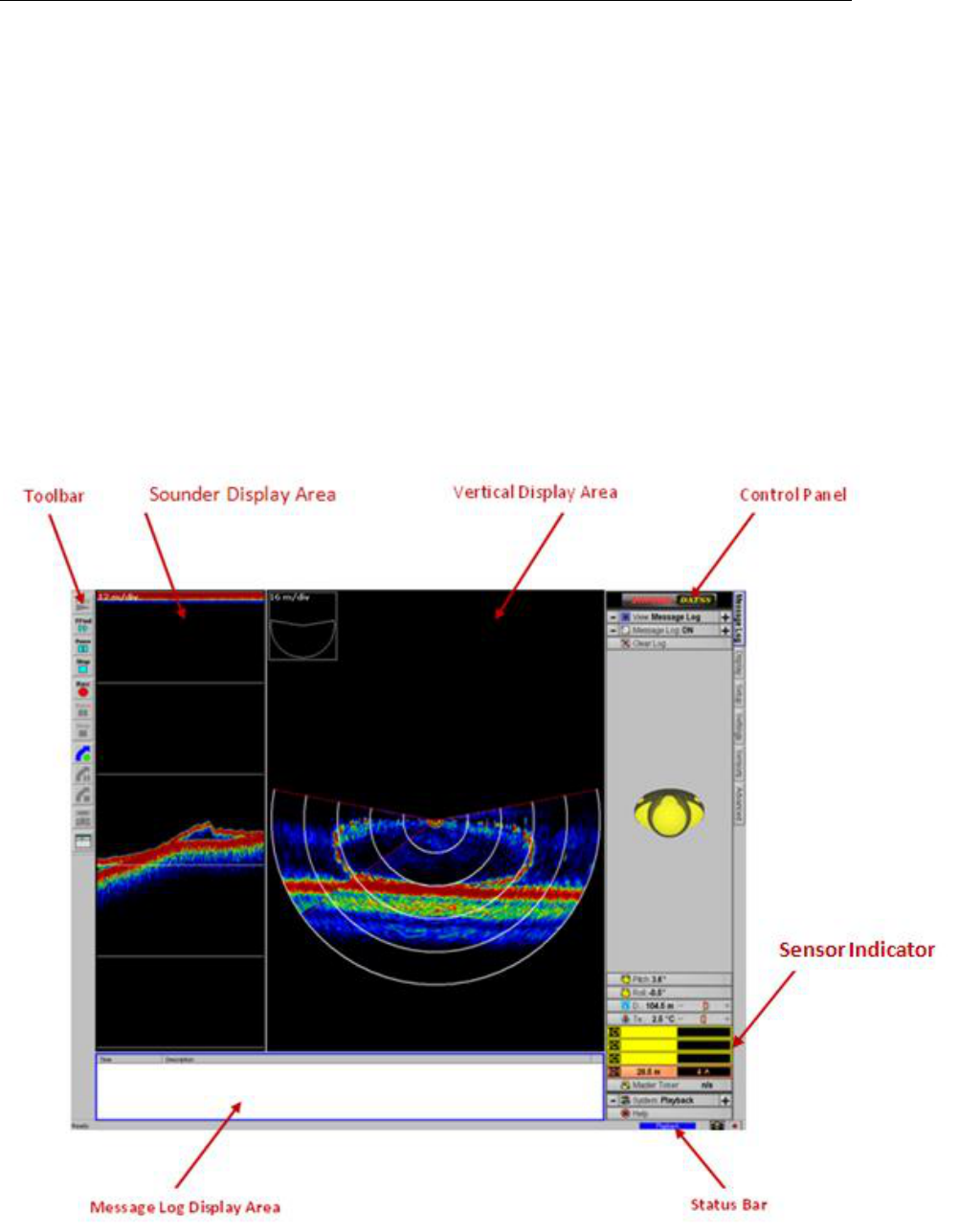
FS70 Trawl Sonar System
10 974-24007001/5.0
3 FS 70 System Operation
3.1 Introduction
The typical screen display for DATSS Sonar Processor consists of a tabbed Control Panel
that allows changing the settings and operating parameters of the DATSS System, resizable
display areas for the Sonar Head, Sounder and Message Log, a floating dockable Sensor
Panel to monitor the sensors status, toolbars for quick access to various functionalities and
a status bar to monitor the system status. The image below shows a typical screen layout for
the DATSS processor and highlights the main components listed above:

FS 70 System Operation
974-24007001/5.0 11
3.1.1 Processor Requirements
Minimum:
1 GHz 32-bit x86 processor
512 MB RAM
300 MB of free hard drive space
One COM port or USB port
One Ethernet port
One CD ROM or DVD ROM drive
Video card with 1024 x 768 resolution
Windows XP Pro 32 bit
Recommended:
2 GHz or higher 64-bit x64 processor
2GB or more RAM
Video card with 1280 x 1024 or higher resolution
Windows 7 Ultimate 64 bit Edition or higher
3.1.2 Installing DATSS
Installation from the CD-ROM/DVD-ROM:
Insert the DATSS installation CD in the drive, select DATSS_V0xxx_Setup.exe. Follow
the installation wizard in the setup program.
Note: it is recommended to uninstall the previous version of DATSS. However, different
version of DATSS can coexist on the same PC.
3.2 Quick Reference
3.2.1 Starting DATSS:
To start DATSS, double-click the DATSS icon on the computer desktop
Select Setup tab | Connect Sonar Menu
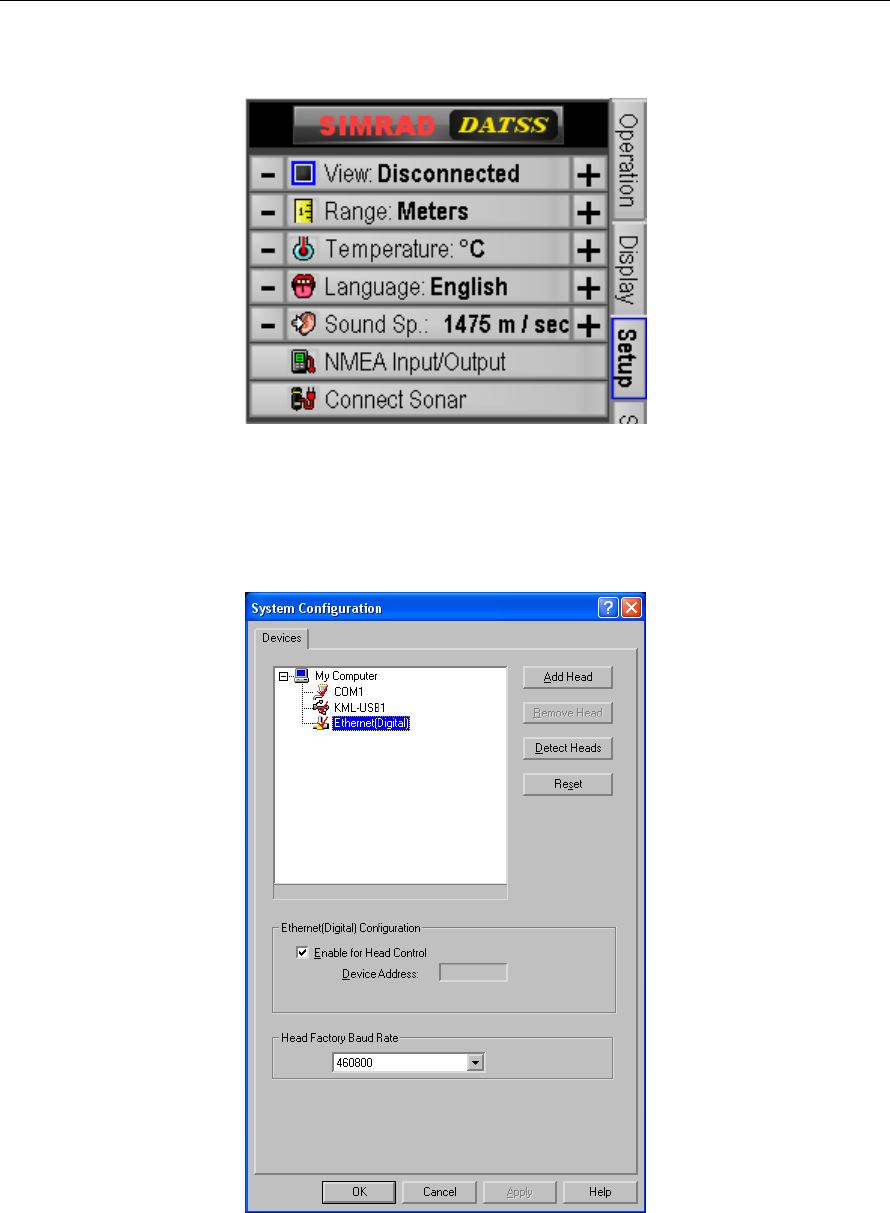
FS70 Trawl Sonar System
12 974-24007001/5.0
The System Configuration page will appear showing available COM ports, KML USB
devices and Ethernet devices.

FS 70 System Operation
974-24007001/5.0 13
To connect a head, click Detect Heads button. A progress bar will be shown as the system
establishes communication with the sonar heads.
The Part Number and Serial Number of the sonar head will be shown.
Click OK to exit the dialog.
Select System > Run
The system will automatically setup the sonar head(s) attached to the trawl cable. This
operation will take approx. 60 seconds for the Anlalog system and 40 seconds for the
digital system.

FS70 Trawl Sonar System
14 974-24007001/5.0
3.2.2 Sonar Operation:
3.2.2.1 Selecting the Scan Mode:
DATSS supports the following scan modes:
Polar: used to allow the sonar scan for up to 360 degree.
Sector: used to allow the sonar scan in a sector less than 180 degree.
Net opening: used to allow the sonar scan in a sector less than 216 degree to observe the
trawl net.
Sounder: used to lock the sonar transducer to 180 degree angle. The angle is not
adjustable.
Smooth sounder: the same function as Sounder, except the horizontal pixel and the
vertical pixel has one to one aspect ratio.
Lock: used to lock the sonar transducer to a certain angle. The angle is adjustable.
To change the scan mode:
Click Mode button from the Operation tab.
3.2.2.2 Selecting the Bandwidth:
DATSS supports the following bandwidth control:
Wide: to get higher intensity image
Medium: to use the optimal bandwidth
Narrow: to get less noisy image
To change the bandwidth:
Click Bandwidth button from the Operation tab.
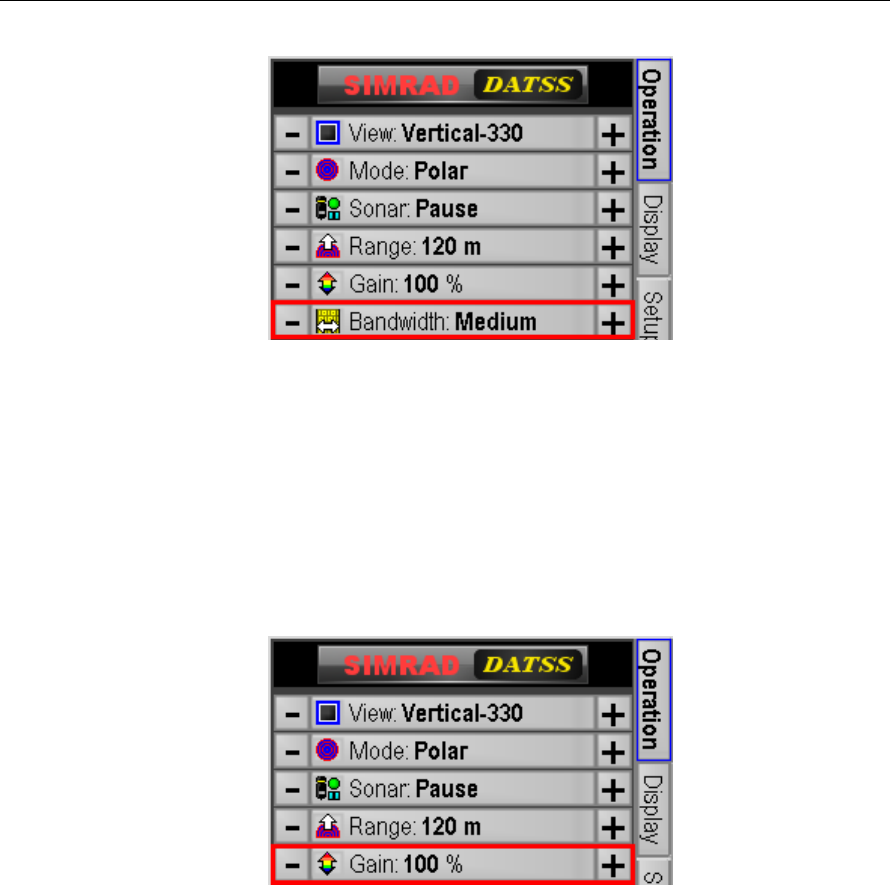
FS 70 System Operation
974-24007001/5.0 15
3.2.2.3 Changing the Gain:
Increase the Gain to get higher intensity image.
Decrease the Gain to get lower intensity image.
To change the Gain:
Click Gain button from the Operation tab.
3.2.2.4 Changing the Scan Speed:
DATSS supports the following scan speed for the step motor in Polar and Sector scan
mode:
0.5 degree per step
1 degree per step
2 degree per step
4 degree per step
7 degree per step
To change the scan speed:
Click Scan Speed button on the Operation tab.
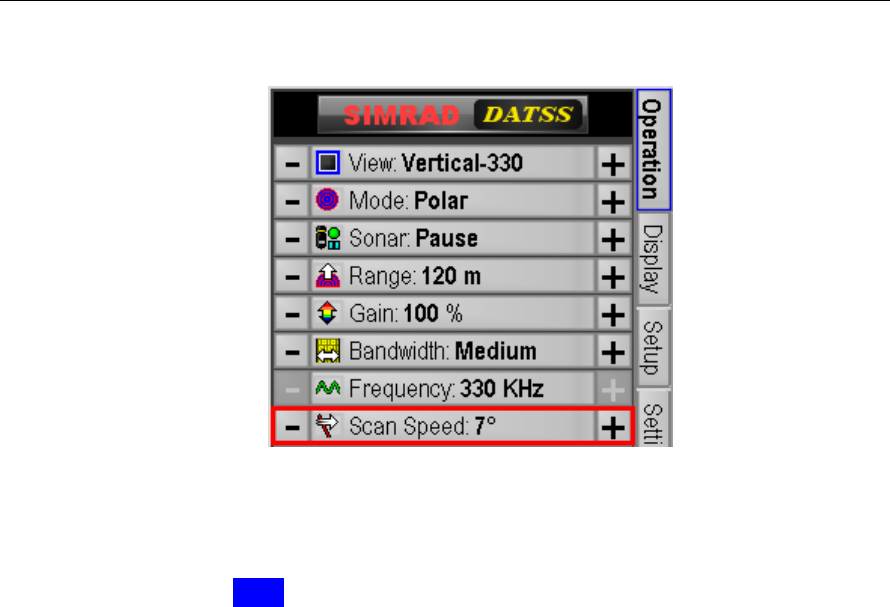
FS70 Trawl Sonar System
16 974-24007001/5.0
3.2.2.5 Changing the Gain Type:
Gain Type is used to enable elementary image processing for reverberation control (RCG),
automatic gain control (AGC) or a combination of the two.
AGC (Automatic Gain Control): provide automatic scaling to each sample in order to
maintain proper dynamic range based on all sample values.
RCG (Reverberation Controlled Gain): the RCG function adjusts the picture to
minimize the influence from the bottom and the surface reverberation.
AGC+RCG: Combination of AGC and RCG
To change the Gain Type:
Click Gain Type button on the Operation tab.
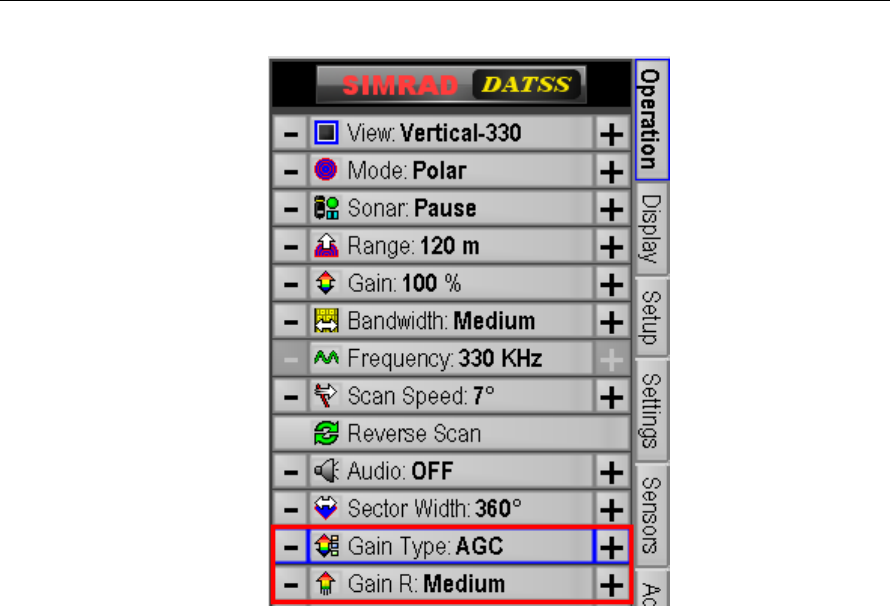
FS 70 System Operation
974-24007001/5.0 17
Gain Response is the severity of the Gain Type affects the sonar image. To change the
Gain response:
Click Gain R button on the Operation tab.
3.2.2.6 Changing the Resolution:
Select low resolution for faster scan rate.
Select high resolution for better image quality.
To change the resolution:
Click Resolution button on the Operation tab.
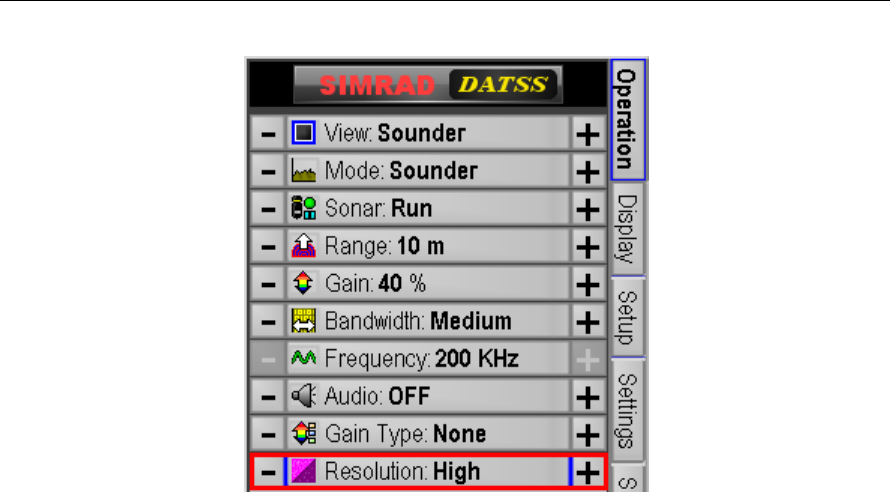
FS70 Trawl Sonar System
18 974-24007001/5.0
3.2.3 Sonar Operation Pages:
To access sonar operation pages, right click on the sonar image display; select Control
Head from the context menu.
NOTE: Depending on the version of the DATSS software the operation pages will use
either the “Head Settings” or the “Sonar Head Control” descriptor in the title bar.
3.2.3.1 The scan page:
The scan page is used to control scan mode, speed and area.
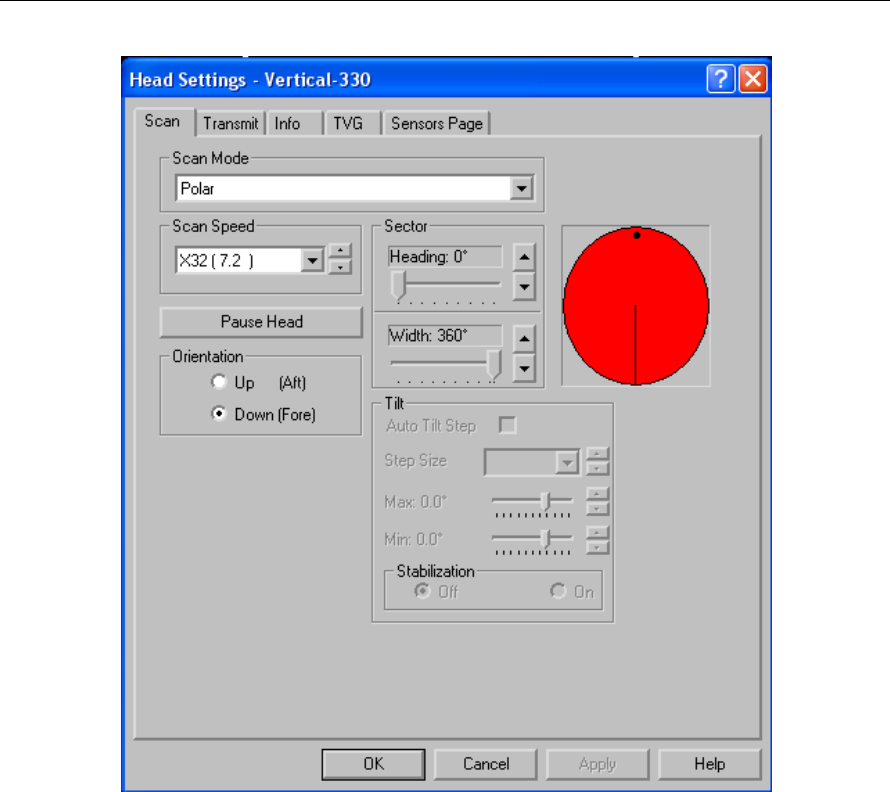
FS 70 System Operation
974-24007001/5.0 19
The Scan Mode box allows you to select Polar, Sector, Net Opening, Sounder, Smooth
Sounder, or Lock mode.
Use the Scan Speed box to select the scanning speed for the head.
The Pause Head button will make the head stop scanning and/or pinging.
Select Up (Aft) in the Orientation box if the transducer is mounted pointing to the stern
side. Select Down (Fore) if the transducer is mounted pointing to the bow side.
Use the Sector controls to adjust the Heading of the area to be scanned as well as the
Width of the sector. Use the slider controls or the increase-decrease buttons for either
adjustment. The area to be scanned is shown graphically beside these controls.
Tilt and Stabilization: when running a FS925 sonar head, the tilt and stabilization controls
will be enabled. Tilt control is used to adjust the vertical angle of the FS925 sonar head. By
enabling the Stabilization, the FS925 will automatically compensate the boat rolling angle
using the reading from pitch/roll sensor.
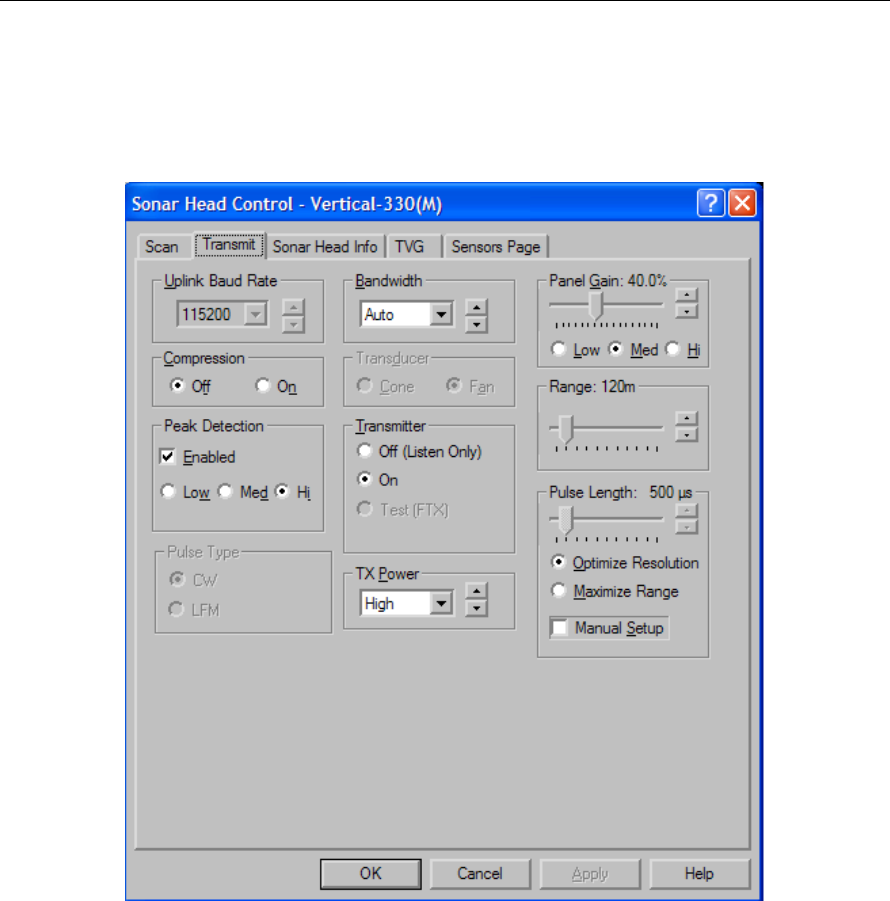
FS70 Trawl Sonar System
20 974-24007001/5.0
3.2.3.2 The transmit page:
The Transmit Page is used to control transmission from the head.
The Uplink control is used to set the baud rate at which data is sent from the head to the
surface. You will normally want to set this control to as high a rate as your system will
support without generating too many errors. When using the Ethernet telemetry, this control
is disabled.
When Compression is set to on, the colour depth of the sonar image will be one-eighth of
its maximum through a reduction in the signal amplitude resolution. This, however,
increases the uplink speed of the sonar data, thereby increasing the system performance.
Peak Detection: when enabled, the sonar head will use highest sampling frequency to
sample the data to get the highest resolution.
Bandwidth: select bandwidth from Wide, Medium and Narrow.

FS 70 System Operation
974-24007001/5.0 21
Transmitter: The transmitter controls are usually used for receiver test.
The Power Control is used to control the current transmit power output.
The Hi Acquisition control is used to change the number of samples collected from the
sonar head to twice its normal value. This is equivalent to a ZOOM x2 operation.
The Panel Gain control is used to adjust the overall gain for the image from this head.
The Pulse Length control can be used to set the desired transmit pulse length. Generally, a
shorter pulse length will give a sharper image but with reduced range. By default, the
system adjusts the pulse length at different range and display mode settings according to the
selection of the Optimize resolution or Maximize Range. The automatic selection of the
pulse length can be disabled by clicking the Manual Setup box.
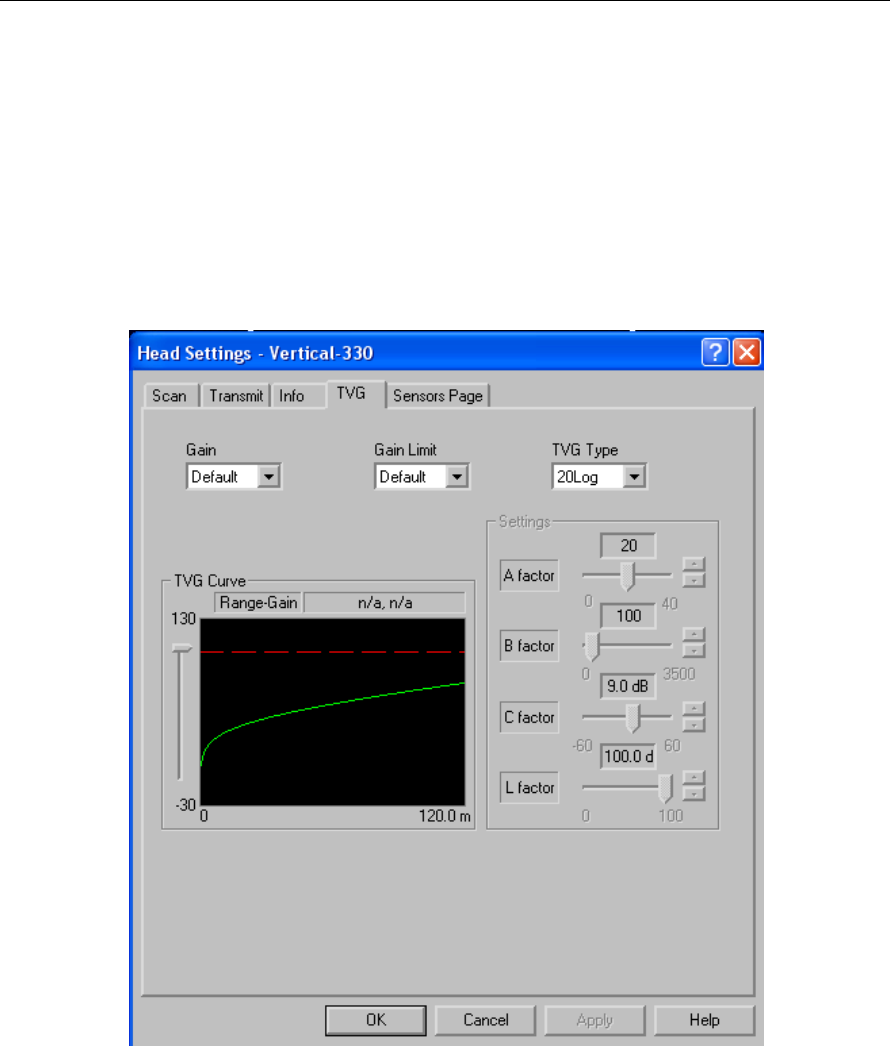
FS70 Trawl Sonar System
22 974-24007001/5.0
If the sonar head has an auxiliary sounder, the sounder transmit page has a special control,
Transmit Ratio. This is used to control the transmit ratio between the primary transducer
and the auxiliary transducer. For example, at transmit ration 1:4, the auxiliary transducer
will transmit once every 4 primary transducer transmit.
3.2.3.3 The TVG page:
The TVG Page is used to control the Time Varying Gain characteristics for the sonar.
Gain
Select Default to use the standard default TVG settings.
Select High to use TVG settings slightly higher than default
Select Low to use TVG settings slightly lower than default.

FS 70 System Operation
974-24007001/5.0 23
Gain Limit
Select Default to use the default upper limit on TVG gain.
Select High to set the upper limit on TVG gain higher than default.
Select Low to set the upper limit on TVG gain lower than default.
TVG Type
Select 20log to use TVG A factor = 20
Select 30log to use TVG A factor = 30
Select 40log to use TVG A factor = 40
Select Test to select a simple ramped TVG curve.
Select User to allow a custom TVG curve to be defined.
TVG Curve
The TVG curve uses three different coloured lines to show the current settings graphically.
The solid green line shows the current TVG curve.
The dashed red line shows the upper limit for the TVG curve.
The position of the yellow line can be adjusted up or down with the slider control to the left
of the graph. The range and gain at the intersection of the yellow and green lines is shown
in the Range-Gain box.
The Settings controls allow a custom TVG curve to be defined. Four adjustable factors are
used to set the gain curve:
A factor represents spreading loss,
B factor represents one way absorption loss,
C factor represents a base or starting gain level.
L factor limits the maximum gain to reasonable levels
The equation used is:
Gain = A log(R) + 2BR + C
Gain = L, if Gain > L
Where R is proportional to time since transmission start (range)

FS70 Trawl Sonar System
24 974-24007001/5.0
3.2.3.4 The Sensor page:
The sensor page is used to adjust trawl sensors display information.
Graph Time: sets the sensor reading display time.
Depth Offset: when depth sensor reading is not accurate, use this offset to compensate the
depth reading.
Tilt Sensor: enabled if tilt sensor is available. Filter level is used to stabilize the sensor
reading. Pitch/Roll offset is used to compensate the pitch, roll value if the tilt sensor
mounting is not level.
3.2.4 Sonar Display:
The Sonar Display contains the sonar image and the measurement overlays. In the
following example, the standard grid of circular range rings and the measurement cursors
have been enabled to measure the sonar image.
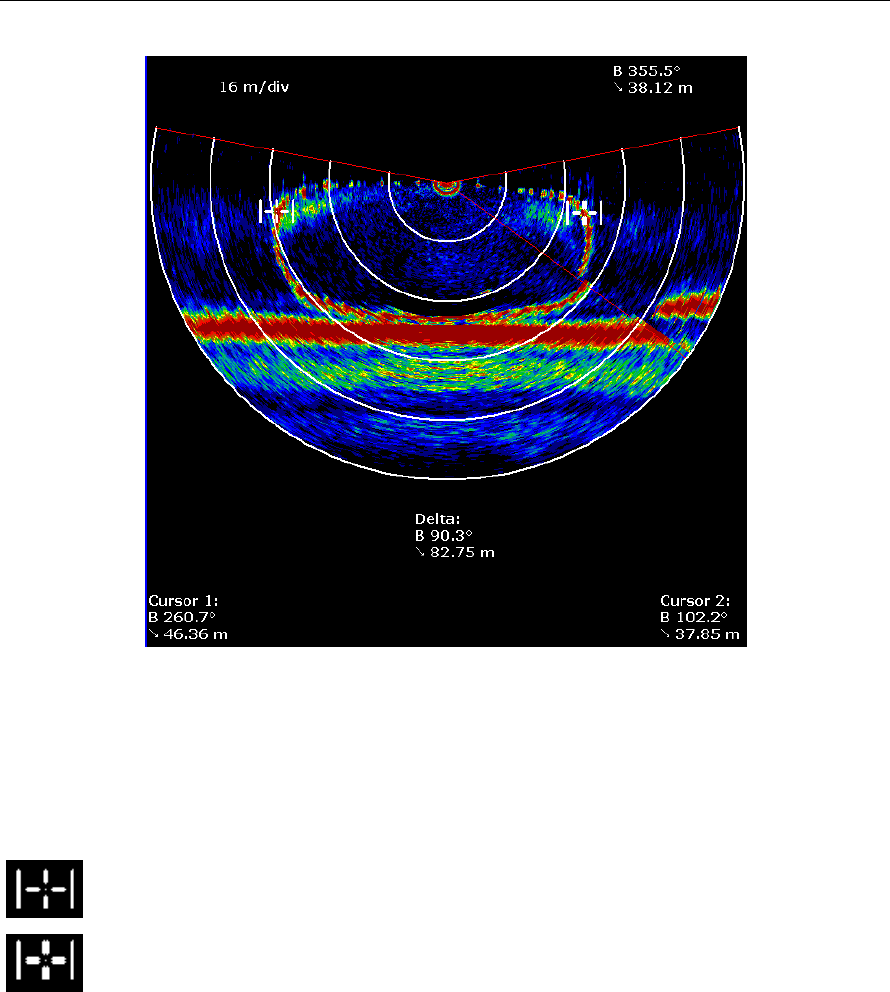
FS 70 System Operation
974-24007001/5.0 25
3.2.4.1 Using the reference cursors:
The Reference Cursors are two cross-hair type markers that can be placed on the sonar
image to mark a point of interest. User can use the reference cursors to measure the range
and bearing from the origin.
Reference cursor 1
Reference cursor 2
To use the reference cursors, click the Cursors button from the Display tab
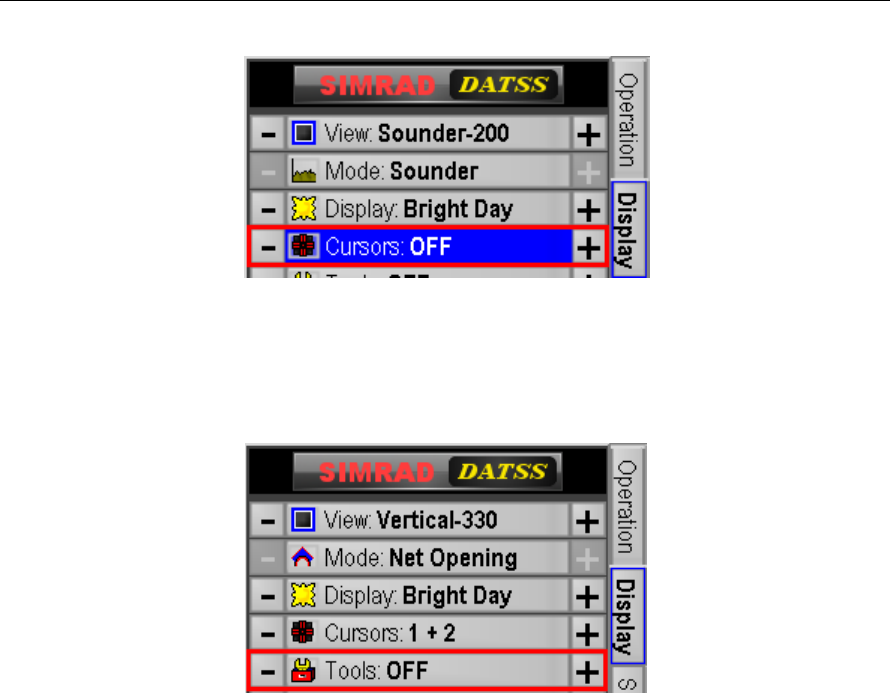
FS70 Trawl Sonar System
26 974-24007001/5.0
3.2.4.2 Using the Tools:
Tools can be selected from the Display tab.
The Tools include the following:
Pencil: Used for annotation. Drag from any point on the screen to label that point with a
text box overlay. To enter new text or change the existing text, simply double click on
the text box.
Wiper: Used to delete existing measurement overlays.
3.2.4.3 Using the Gauge Window:
A gauge window is a small window containing data and appearing inside the sonar head
display window. DATSS has following gauge windows:
The Head Settings Gauge Window: The Head Settings gauge Window shows the
settings of some of the main parameters for the sonar head. Right-click on the sonar
image view, select Head Settings to display The Head Settings gauge window.

FS 70 System Operation
974-24007001/5.0 27
The FS Sensors Gauge Window: The FS Sensors Gauge Window shows the depth and
temperature sensor data from the trawl sensor pack. Right-click on the sonar image
view and select FS Sensors to display The FS Sensors Gauge Window.
The Overload Counter Gauge Window: The Overload Counter window displays the
percentage of sonar samples that are in saturation. The display is logarithmic in nature,
where 10% count is displayed as half scale and 100% as full scale. User is encouraged
to adjust the TVG to minimize the number of saturated samples.
To Create a customized gauge window to display customized parameters
1. Right-click on the sonar image view and select Customize Gauge Window
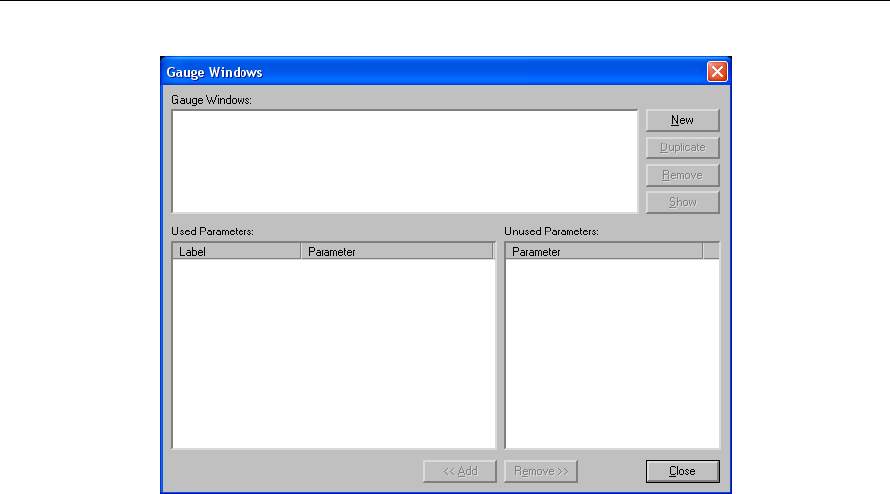
FS70 Trawl Sonar System
28 974-24007001/5.0
2. In the "Gauge Windows" dialog box, click "New" button.
3. Enter a name for the new gauge window then click "OK".
4. To add parameters into the gauge window, select from the "Unused Parameters" list
then press the "Add" button.
5. To remove parameters from the gauge window, select from the "Used Parameters" list
then press the "Remove" button.
6. Click "Close" button to finish.
7. Use the "Duplicate" button to quickly duplicate an existing gauge window and add
more parameters.
8. Use the "Show" button to show/hide the selected gauge window.
3.2.5 NMEA Input and Output:
3.2.5.1 NMEA Input
NMEA standard sensors such as GPS can be imported to The DATSS through a COM Port
or a Virtual COM Port. To enable NMEA input, click NMEA Input/Output button on the
Setup tab and then select Input

FS 70 System Operation
974-24007001/5.0 29
1. From the Sensors Configuration page, select a COM port,
2. Select one or more of the NMEA standard in the "Standard" list, and click "Connect".
3. If you have "User Defined" sensors (see section Creating user defined sensors), select one
or more from the "User Defined" list, and click "Connect".
4. Select "Ports Configuration" tab to configure COM port parameters (see section Set up
COM port parameters.
5. Select "Test" tab to check if the sensor data is received from selected COM port. (See
section Check the Sensor Data)

FS70 Trawl Sonar System
30 974-24007001/5.0
To remove a sensor from a COM port:
1. Select the sensor to be removed
2. Click the Disconnect button
Select "Adjust System Time" to allow the system clock to be synchronized to the time
stamp from the NMEA sensor data.
3.2.5.2 Creating user defined sensors
- In the User Defined Sensors page, click the Create button to make a new user defined
sensor.
- Change the assigned name by editing the contents of the Name box.
- Use the Start Character box to select the start character of the user serial string.
- Use the Field Delimiter box to select the delimiter character to delimit the string. Typically
a comma or a space.
- Use the Format box to select which characters in the input string will be displayed and
how they will be interpreted. You must enter some sequence of the letters A,B,F,I,N,D, or
S to define the display format:
A --- Print as ASCII character
B --- Print as BCD character

FS 70 System Operation
974-24007001/5.0 31
F --- Search for the next Field Delimiter
I --- Ignore a character
N --- Print as ASCII to the next Field Delimiter
D --- Insert a Decimal point
S --- Insert a Space
Example
Suppose you had a device which provided distance travelled through the water using the
NMEA defined VLW sentence:
$--VLW,x.x,N,x.x,N*hh<CR><LF>
where:
$--VLW identifies the start and type of sentence,
x.x is a variable length data field showing the cumulative distance travelled through the
water.
N specifies the distance units to be in nautical miles,
x.x is a variable length data field showing the distance since reset,
N specifies the distance units to be in nautical miles,
*hh is a checksum,
<CR><LF> is a terminating carriage return and line feed pair.
This sentence always starts with the $ character, so we would set the Start Character for this
data to $ (Hex 24 or Binary 00100100).
The data is separated into fields using commas, so we would set the Field Delimiter for this
data to , (Hex 2C or Binary 00101100).
Suppose we wanted to display only the cumulative distance and the distance since reset
from this data string. We could set the Display Format string to FNFSSN. The first F would
ignore everything up to and including the first comma, the first N would display the
cumulative distance field, the next F would skip the next field, the SS would print two
spaces to separate the data, and the final N would display the 'distance since reset' field.
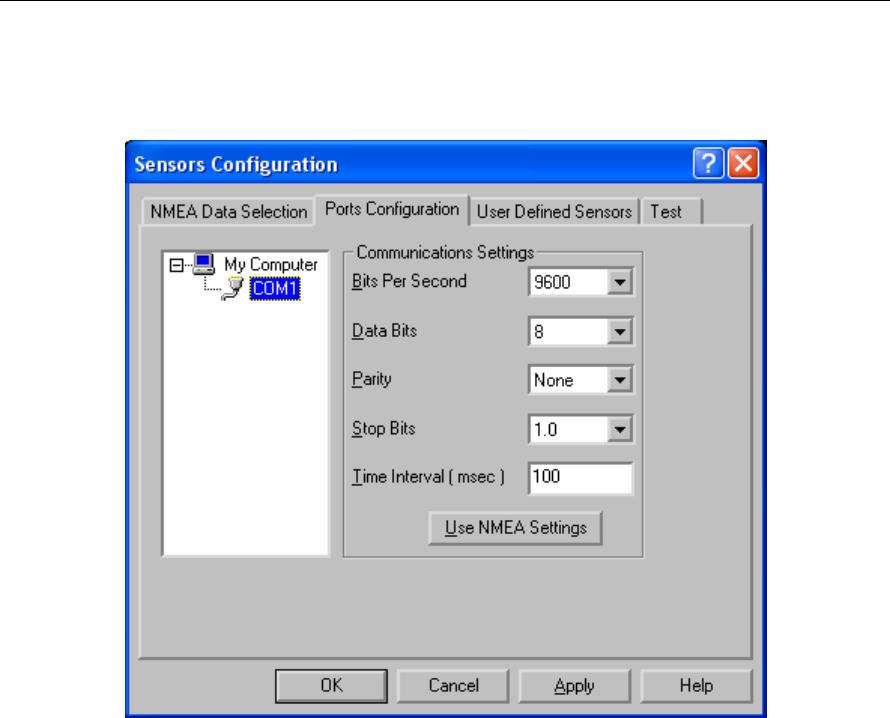
FS70 Trawl Sonar System
32 974-24007001/5.0
3.2.5.3 Setting the COM port for sensors
- In the Ports Configuration page, select the COM port that you want to configure in the
tree under My Computer.
- Set Bits Per Second, Data Bits, Parity, and Stop Bits to match with the sensor
settings.
- Set the Time Interval for the sensor data input rate.
- Click the Use NMEA Settings button to quickly set all of the settings to NMEA
default.
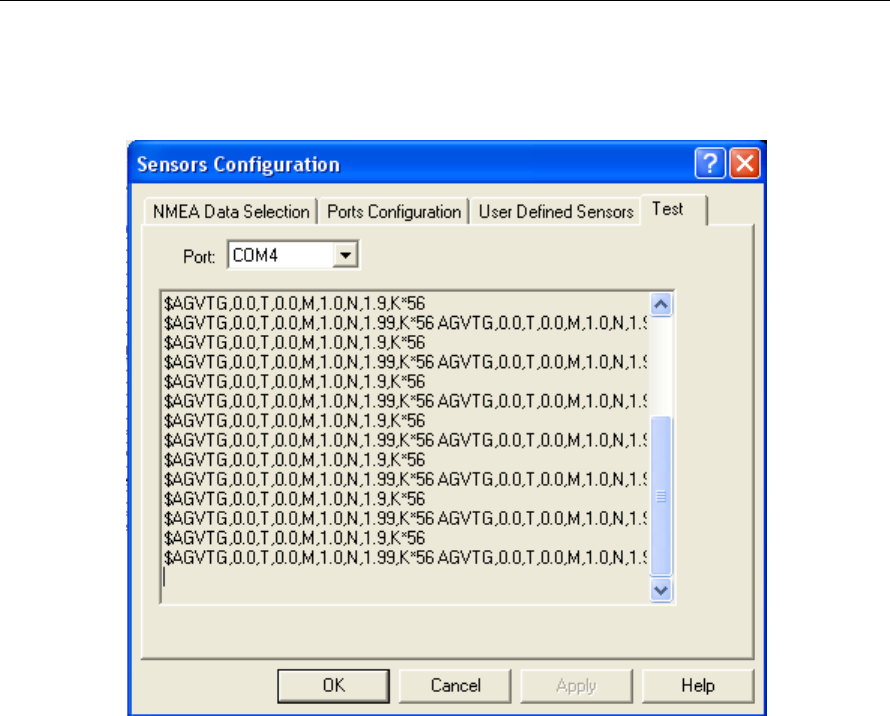
FS 70 System Operation
974-24007001/5.0 33
3.2.5.4 Checking the sensor data
In the Test page, check the sensor data received from the COM port.
3.2.6 Recording Playback and Exporting:
3.2.6.1 Recording
With DATSS, you can record the sonar data and settings to the ".smb" data file. The
recorded data are time-stamped with UTC time and displayed in GMT format during
playback. To start recording:
Click Rec Toolbar in the Display tab to enable or disable the recording tool bar.
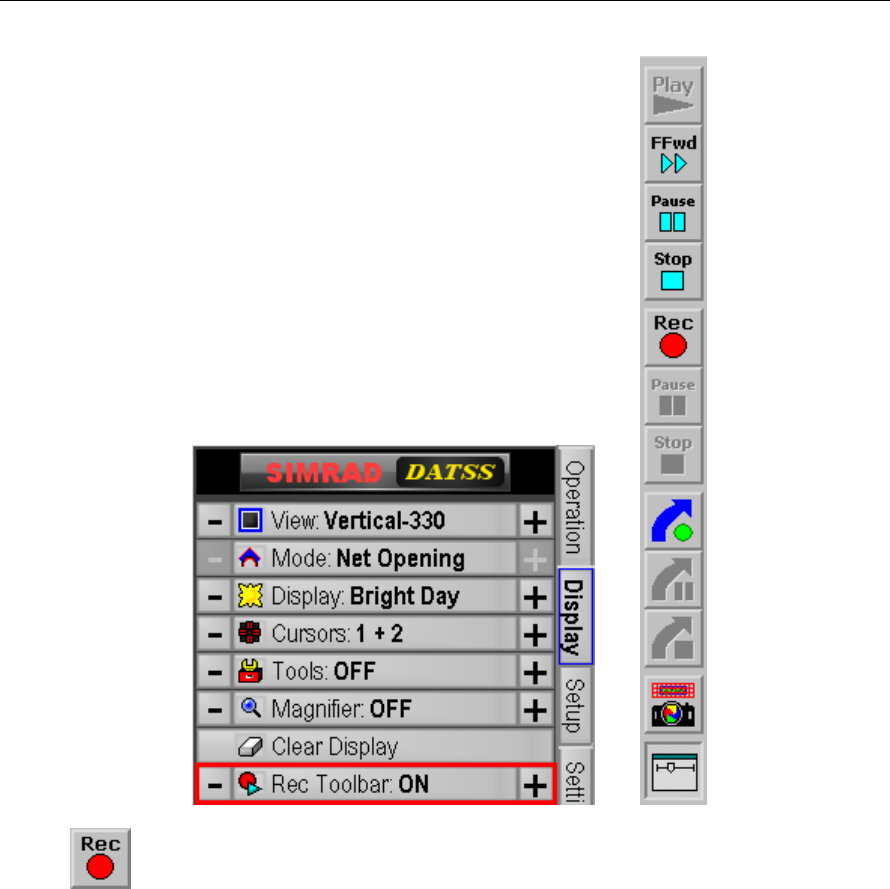
FS70 Trawl Sonar System
34 974-24007001/5.0
Click button on the recording tool bar
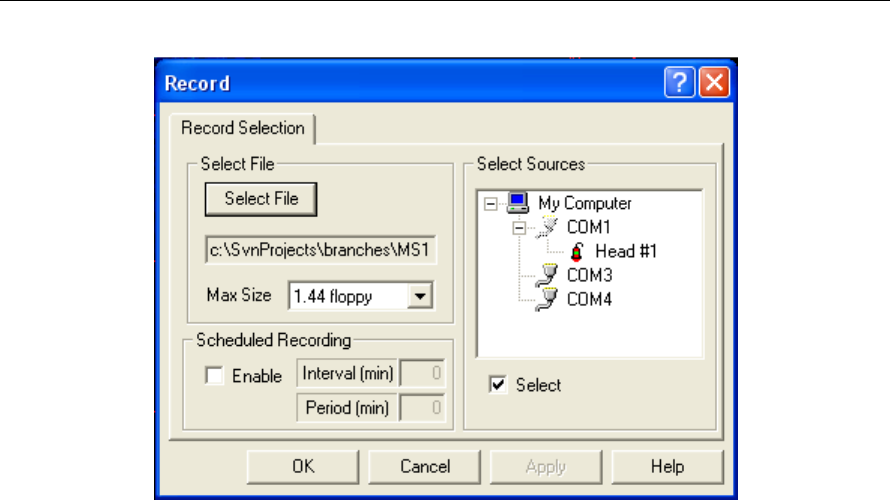
FS 70 System Operation
974-24007001/5.0 35
Select File: The DATSS creates a unique name for each file based on the date and time. If
you do not want to use this name, click the Select File button to select a name for the file to
be recorded.
Use the Max Size control to set the maximum file size to be used. When this size is
reached, a new file will be started using the same name and a different extension as
follows:
-
- The first file will have the extension SMB.
-
- The next file will have the extension 001.
-
- The next file will have the extension 002.
-
- etc.
Select Sources: Click on the sonar head that you want to record and then check “Select”
Scheduled Recording: The scheduled recording feature allows you to automatically record
data for a selected interval then pause for another interval. This cycle will repeat
continuously. Select Enable to enable scheduled recording. Set the number of minutes to
be recorded with the Interval (min) control. Set the number of minutes between recording
sessions with the Period (min) control. For example, to set the sonar head to run for 5
minutes and sleep for 25 minutes enter 5 min for interval, 30 min for period.

FS70 Trawl Sonar System
36 974-24007001/5.0
3.2.6.2 Playback
To playback smb file, click button on the recording toolbar. The playback data
dialog box allows you to select a file for playback.
Select the file that you want to playback, then click Open to start playback.
The Playback Progress dialog box is used to control data playback and show the current
position within the data.
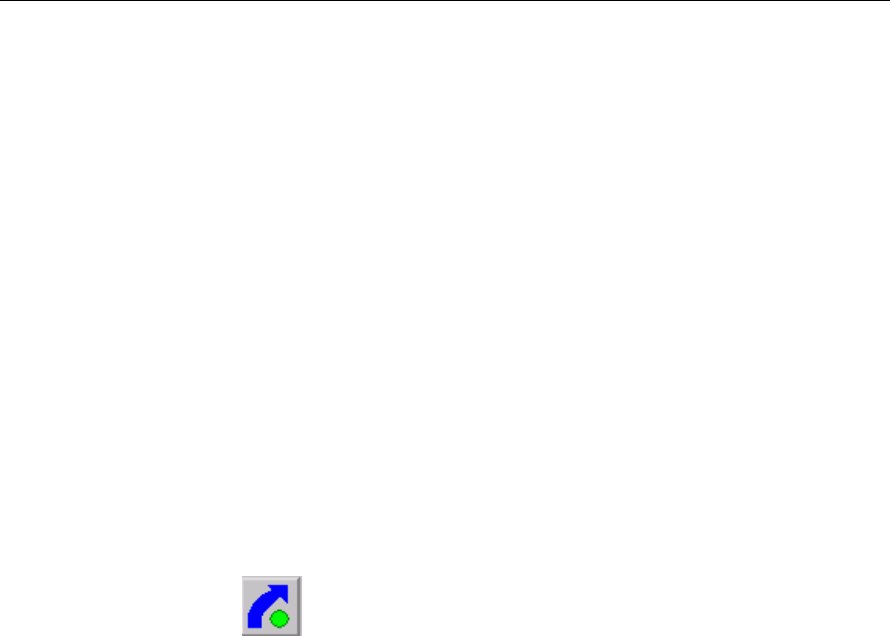
FS 70 System Operation
974-24007001/5.0 37
The slider bar shows the relative progress of the playback. The markers on top of the slider
bar correspond to the beginning of each volume or file in the selected file group. The slider
can be dragged ahead or back to see any part of the data.
Select Restart from beginning of Volume if you want to always restart at the beginning of
each volume after repositioning the slider bar. This is the default and provides the fastest
repositioning. If this option is disabled, the system will fast forward through the selected
volume to the user selected position.
The Progress box shows the playback progress as a percentage of the total file group size.
Select Continuous to allow the system to continuously replay the same file group over and
over again.
The date and time of the recorded data are displayed as GMT time.
Use the Fast Forward Speed control to adjust the playback speed when the Fast Forward
feature has been selected.
3.2.6.3 Exporting
To start exporting, click on the recording toolbar.
The Export Sensor Selection dialog box allows you to configure the system to export data
to a COM port.
Select a COM port under Ports and check Enabled Export On Port. Select one or more
data source under Select Source.

FS70 Trawl Sonar System
38 974-24007001/5.0
The Ports Configuration page allows you to set the communications settings for the
selected COM port.

FS 70 System Operation
974-24007001/5.0 39
Select the COM port that you want to configure in the tree under My Computer.
Set the Communications Settings (Baud Rate, Data Bits, Parity, and Stop Bits). Use the
highest baud rate to get the maximum exporting speed.
Click the Use NMEA Settings button to quickly set all of the communication settings to
those normally used by NMEA devices.
3.2.6.4 Saving the sonar image
To save the sonar image to BMP file:
Click on the recording toolbar to save the sonar image with overlays.
A “.TXT” file is created along with the “.BMP” file.
3.2.7 User Interface
The DATSS user interface contains the following modules:
- Control Panel
- Toolbar
- Vertical Image Display
- Sounder Image Display
- Message Log Window
- Status Bar
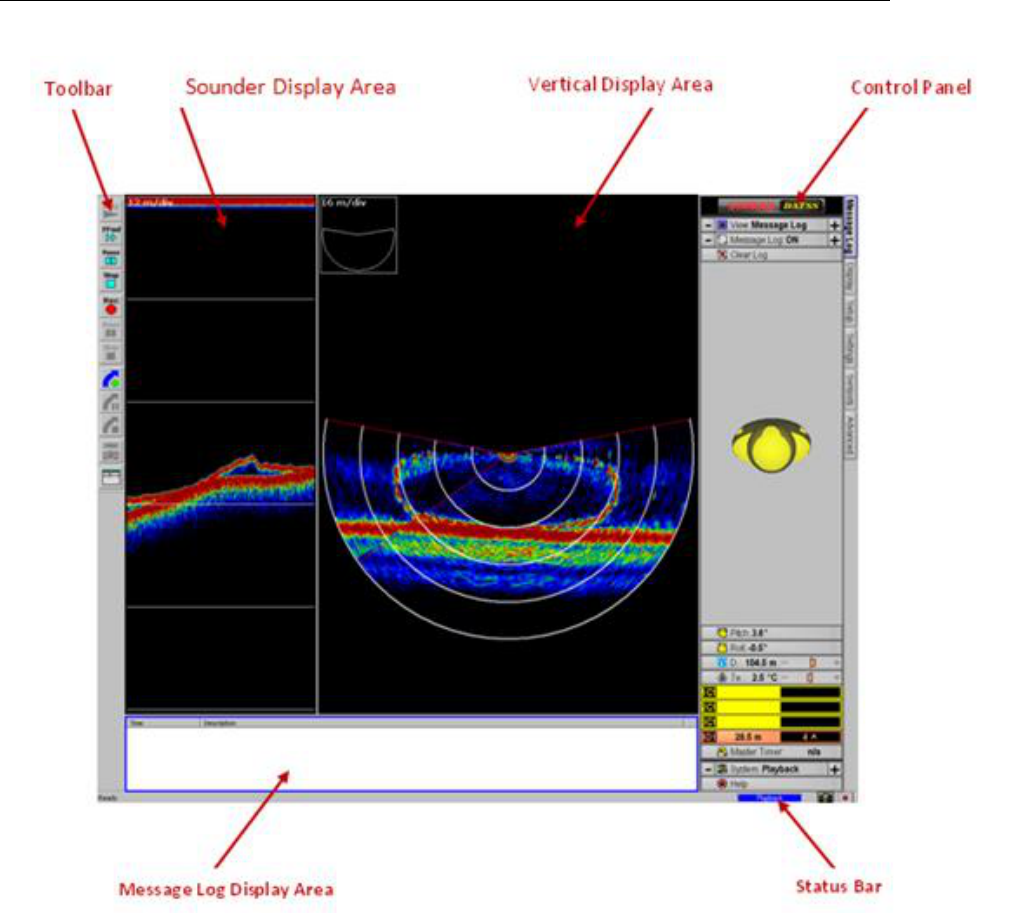
FS70 Trawl Sonar System
40 974-24007001/5.0
3.2.7.1 Control Panel
The Control Panel allows adjustments to several system parameters without having to
access a menu system. To minimize clutter the control items available in Control Panel are
grouped into tabbed pages according to functionality. Items that lead to dialog boxes are
shown in the “Advanced Menu”. All other items are system parameters that may be
modified. As you move the pointer over the Control Panel, a simple help message will pop
up beside the pointer describing its function. To perform certain operations, just left or right
click the mouse over the desired item. Selected items are highlighted.
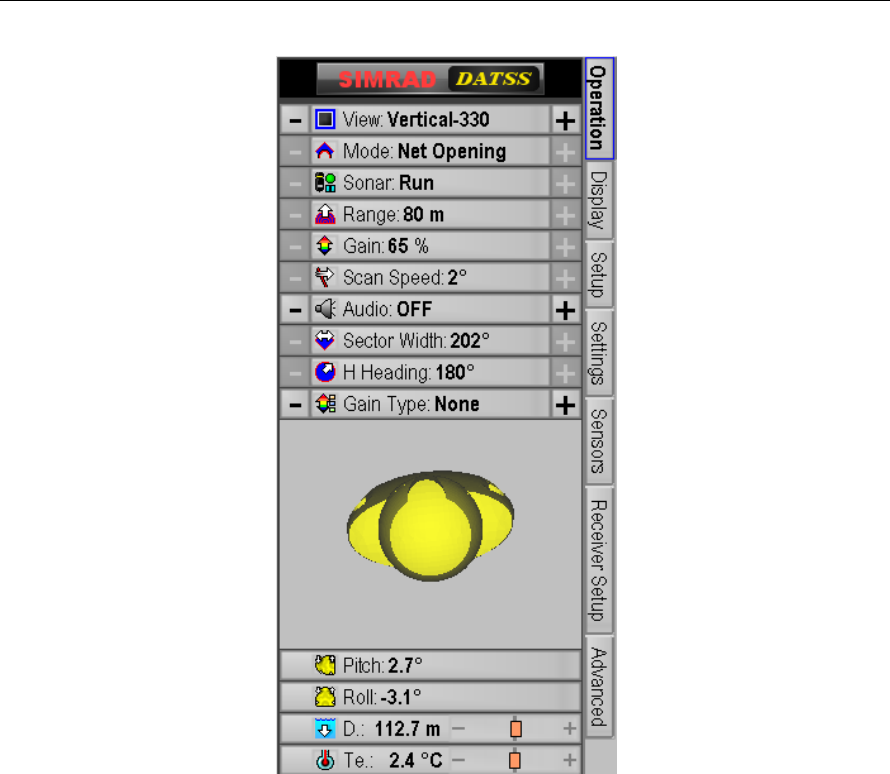
FS 70 System Operation
974-24007001/5.0 41
The Sonar Control Panel located above is divided into 7 tabbed Pages: Page 1 “Operation”,
Page 2 “Display”, Page 3 “Setup”, Page 4 “Settings”, Page 5 “Sensors Control”, Page 6
“Receiver Setup” and Page 7 “Advanced”. Each page allows you to change the system
parameters. To change the value of a system parameter, move the mouse up or down until
the desired button is highlighted and click the left mouse button or right mouse button to
activate the new setting.
NOTE: The main control panel can be docked or auto-hidden.

FS70 Trawl Sonar System
42 974-24007001/5.0
3.2.7.2 Operating Control Panel Tab
The main “Operating” control panel allows you to select operational settings for the active
sonar. Click on the appropriate display window to activate the sonar you want to control,
next position the mouse cursor on the button you want to change, then, click the left mouse
button or right mouse button to change the settings.

FS 70 System Operation
974-24007001/5.0 43
3.2.7.3 Display Control Panel Tab
The main Display” control panel allows you to select the display settings for the active
sonar. To change the value of the system parameter just left or right click the mouse over
the button you have selected, move the mouse up or down until the desired button is
highlighted and click the left mouse button or right mouse button to activate the new
setting.
3.2.7.4 Setup Control Panel Tab
The main “Setup” control panel allows you to set up system parameters for the active sonar.
To change the value of the system parameter just left or right click the mouse over the
button you have selected, move the mouse up or down until the desired button is
highlighted and click the left mouse button or right mouse button to activate the new
setting.
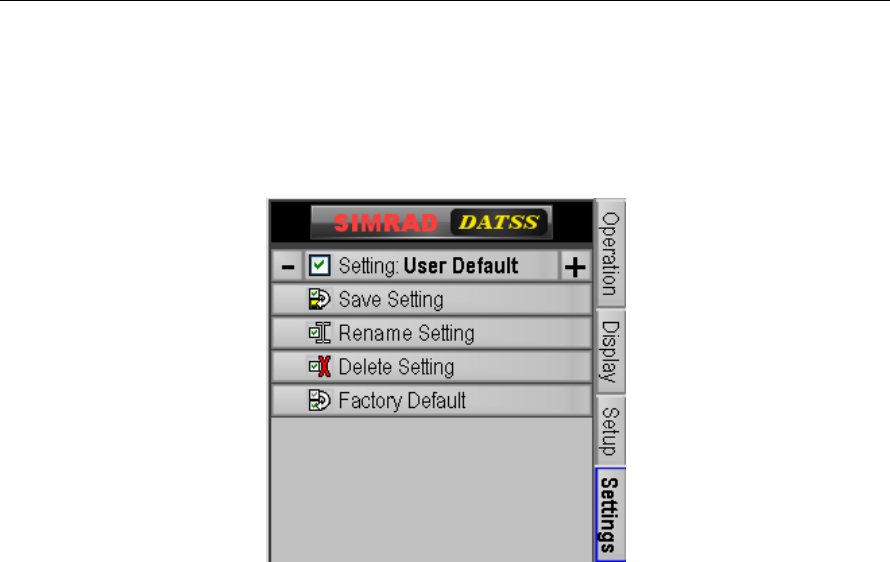
FS70 Trawl Sonar System
44 974-24007001/5.0
3.2.7.5 Users Settings Control Panel Tab
The main “Users” control panel allows you to set the settings for the active sonar based on
previously saved settings. To change the setting, just left or right click the mouse over the
button you have selected, move the mouse up or down until the desired button is
highlighted and click the left mouse button or right mouse button to activate the new
setting.
NOTE: When you “Save Setting” you automatically save the setting for both the
vertical and the sounder at the same time.
3.2.7.6 Sensors Control Panel Tab
The main “SENSORS” control panel allows you to select the sensors you want to setup. To
change the value of the system parameter just left or right click the mouse over the button
you have selected, move the mouse up or down until the desired button is highlighted and
click the left mouse button or right mouse button to activate the new setting.
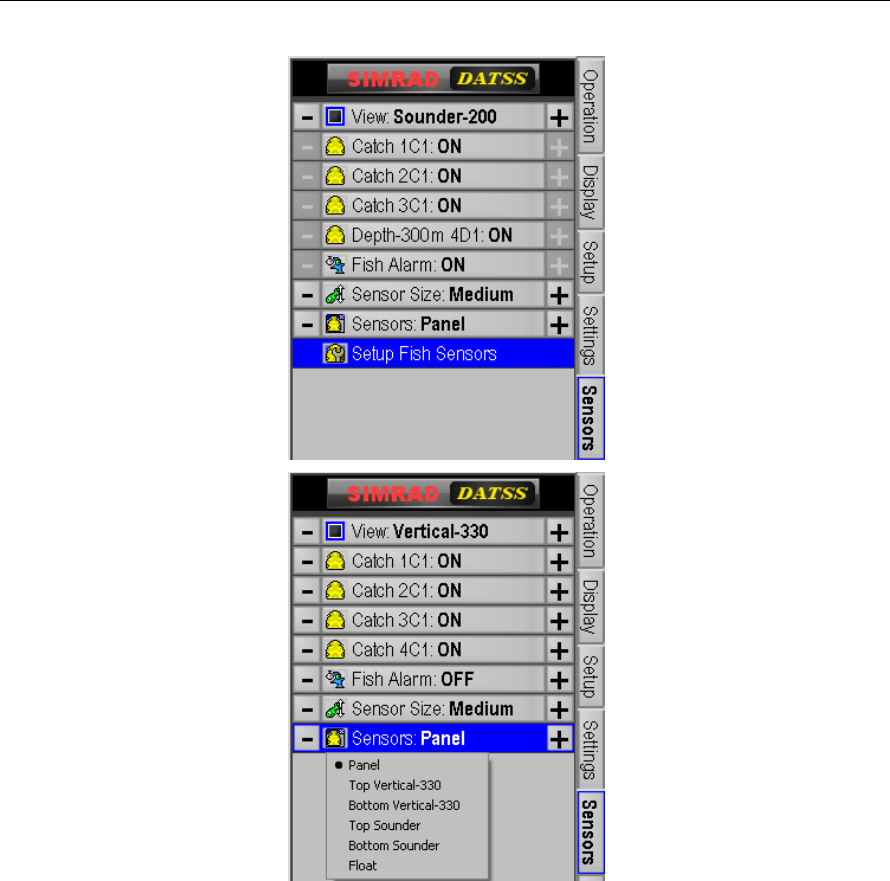
FS 70 System Operation
974-24007001/5.0 45
By placing the mouse cursor on the “Setup Fish Sensors” button and then left clicking the
mouse, the Fish Sensor Window will pop up as indicated on the following page. Move the
mouse cursor up or down to select the sensor you want to select and then left click the
mouse on the appropriate selection to activate the mode of operation. By placing the mouse
cursor on the “Sensors Panel” button and then right clicking the mouse a drop down menu
will appear. Move the mouse cursor up or down to select the location of the sensor panel
you want to select. Next left click the mouse on the appropriate button selection to activate
the operation.
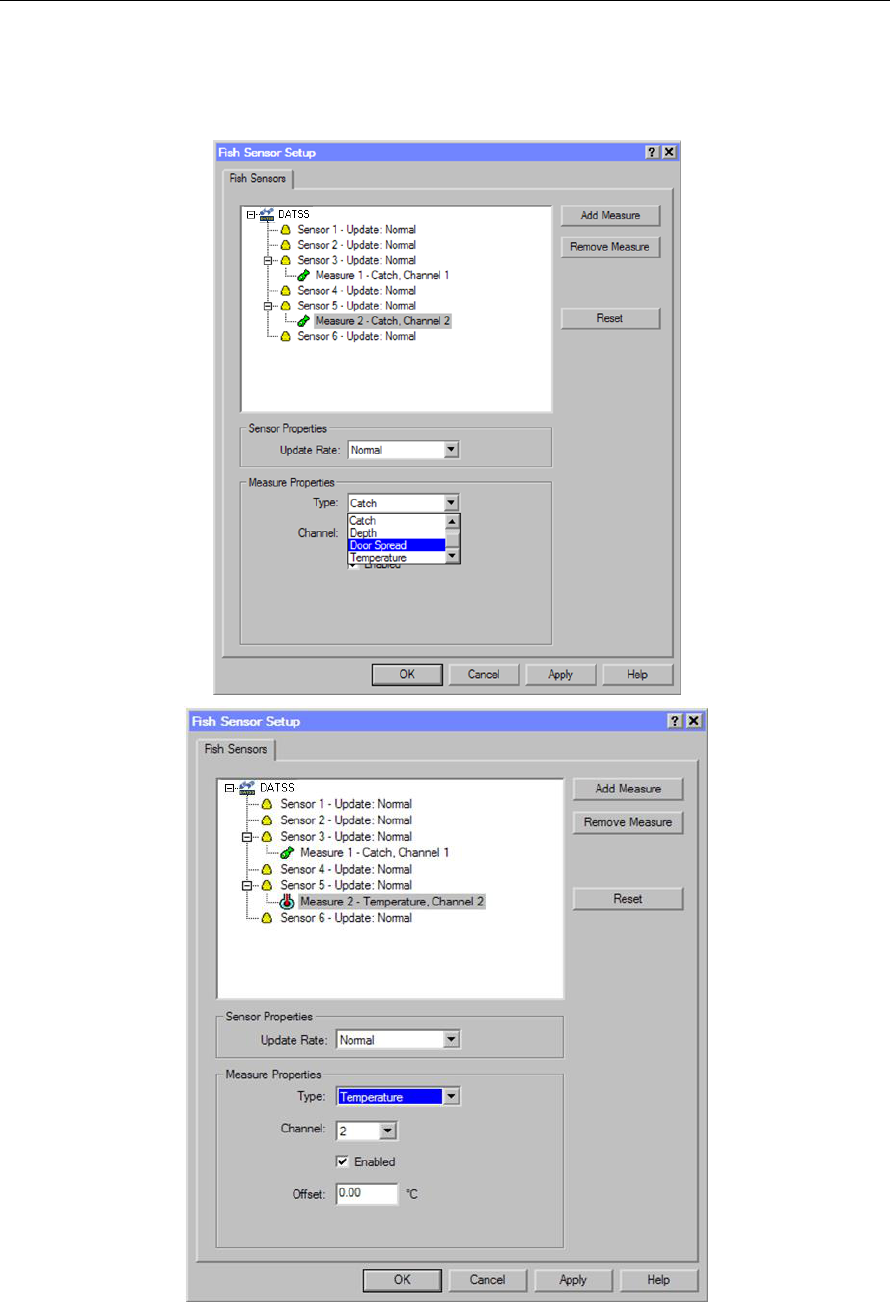
FS70 Trawl Sonar System
46 974-24007001/5.0
3.2.7.7 PI 40 kHz Channel Sensors Setup
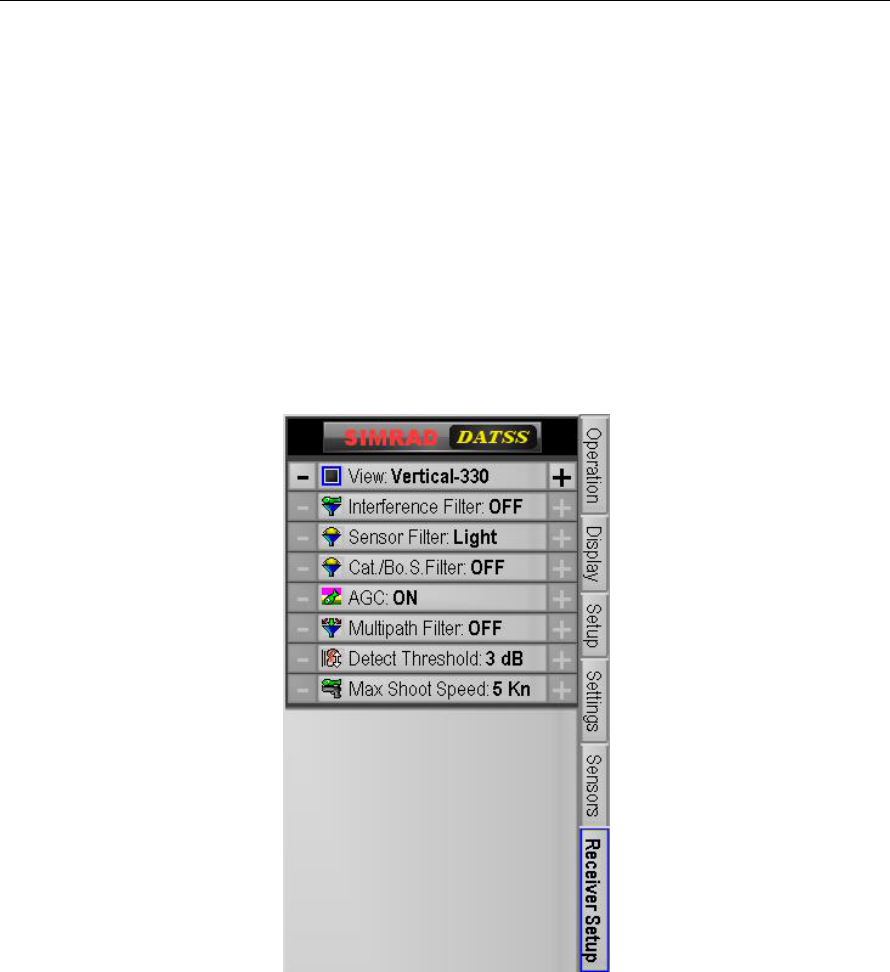
FS 70 System Operation
974-24007001/5.0 47
The next step after the above operation, for example, will be to add a catch sensor.
Click on “sensor 5”; next select Door Spread or catch #2; next you would select the channel
of operation, in this case you would have selected #2.
If you are adding for example a temperature sensor you can setup an offset. See the
windows above for the example.
Note: For additional information on the Simrad PI Setup, please refer to your PI Instruction
Manual.
3.2.7.8 PI 40 kHz Sensors Receiver Setup
The main “SENSORS RECEIVER SETUP” control panel allows you to select the sensors
you want to setup. To change the value of the system parameter just left or right click the
mouse over the button you have selected, move the mouse up or down until the desired
button is highlighted and click the left mouse button or right mouse button to activate the
new setting.
NOTE: For additional information on the Simrad PI Sensors Setup, please refer to
your PI Instruction Manual.
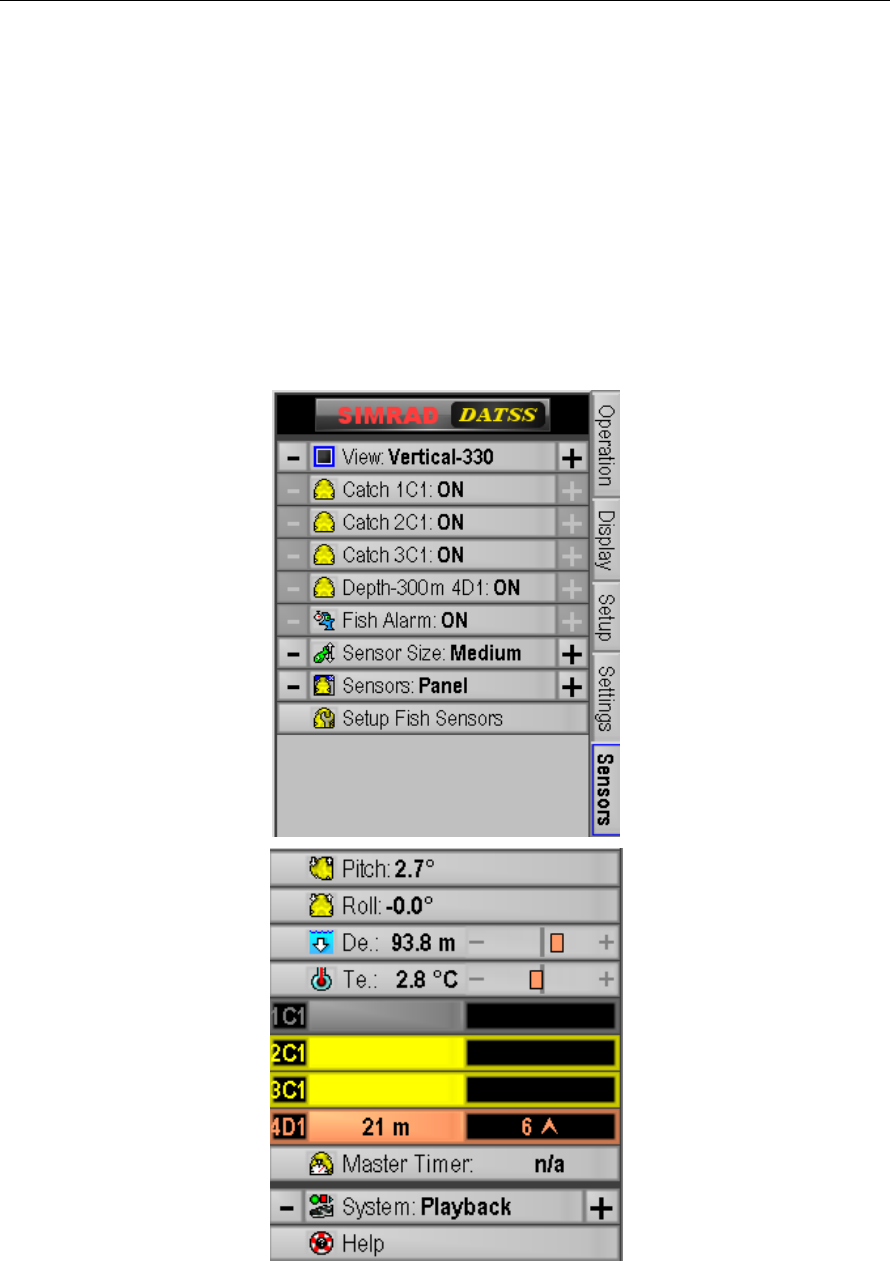
FS70 Trawl Sonar System
48 974-24007001/5.0
NOTE: The PI sensor setup menus are not available if you are using a 70 kHz Catch
Sensors system.
3.2.7.9 PI 40 kHz Sensors Activation Menu
The main “SENSORS ACTIVATION MENU” control panel allows you to select the
sensors you want to turn ON or OFF. To change the value of the system parameter just left
or right click the mouse over the button you have selected, move the mouse up or down
until the desired button is highlighted and click the left mouse button or right mouse button
to activate the new setting.
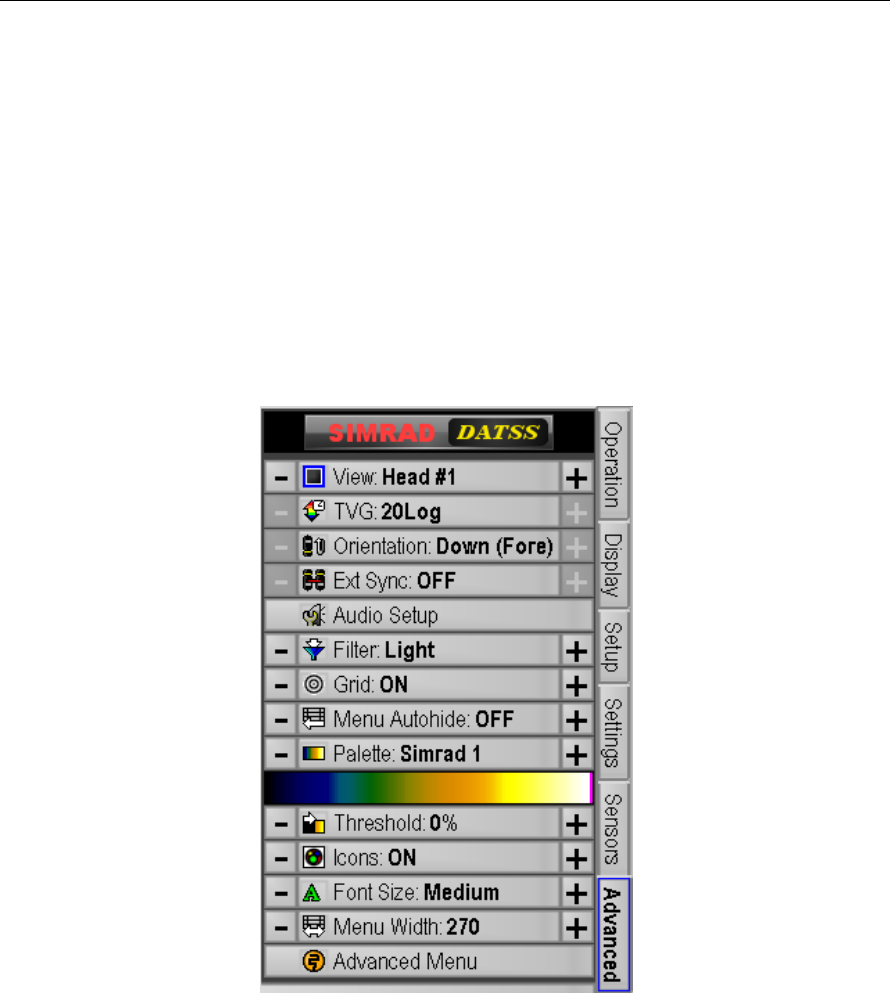
FS70 Trawl Sonar System
50 974-24007001/5.0
The Catch Sensor windows will be displayed automatically when you left click on the
Catch Window button located on the Sensors Page. To activate or de-activate individual
Catch Sensors click on the appropriate button.
When you activate a Catch Sensor the sensor information is automatically displayed in the
Control Panel.
3.2.8 Advanced Panel Tab
The Advanced Panel Tab contains the parameters for advanced users. These parameters
usually do not need to be changed.
3.2.8.1 TVG selection
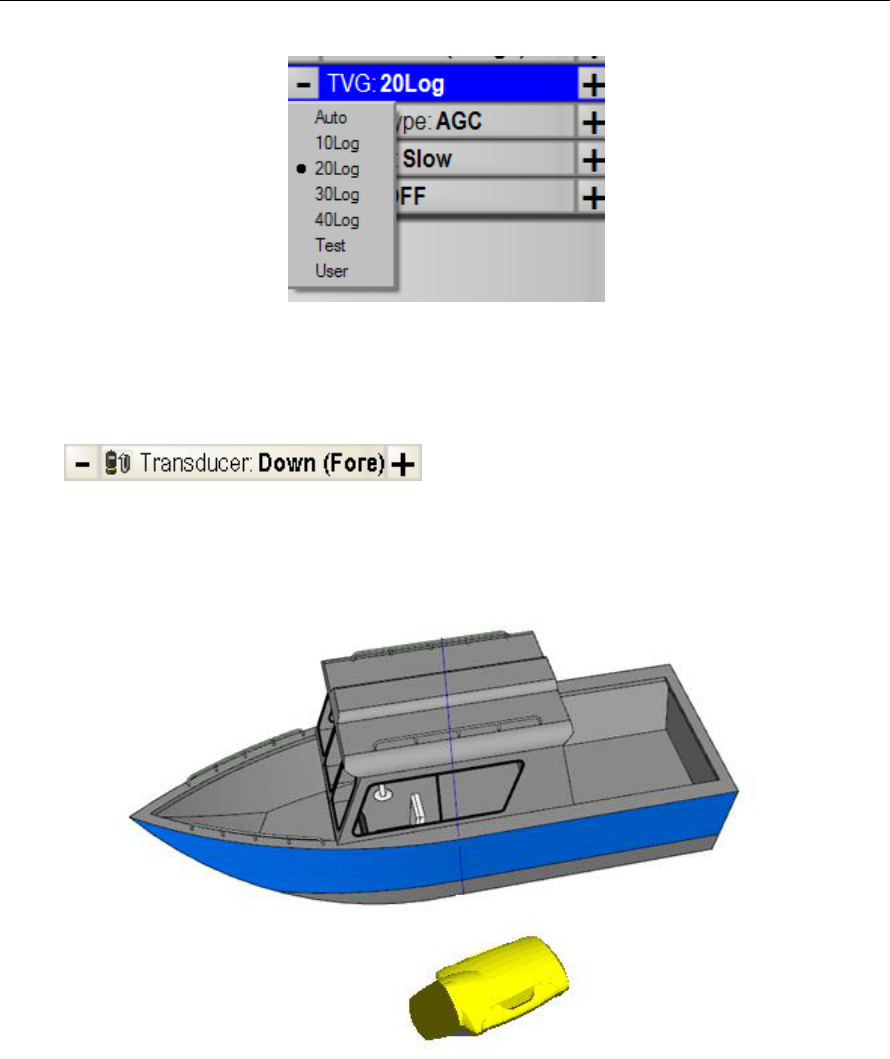
FS 70 System Operation
974-24007001/5.0 51
Click the middle of the TVG button, a drop down menu will appear. Select the appropriate
TVG for the current selected sonar head.
3.2.8.2 Sonar orientation
Click to change the sonar transducer orientation.
There are 2 types of transducer orientation which depends on the sonar mounting.
Fore: Transducer is pointing to the bow.
Aft: Transducer is pointing to the stern
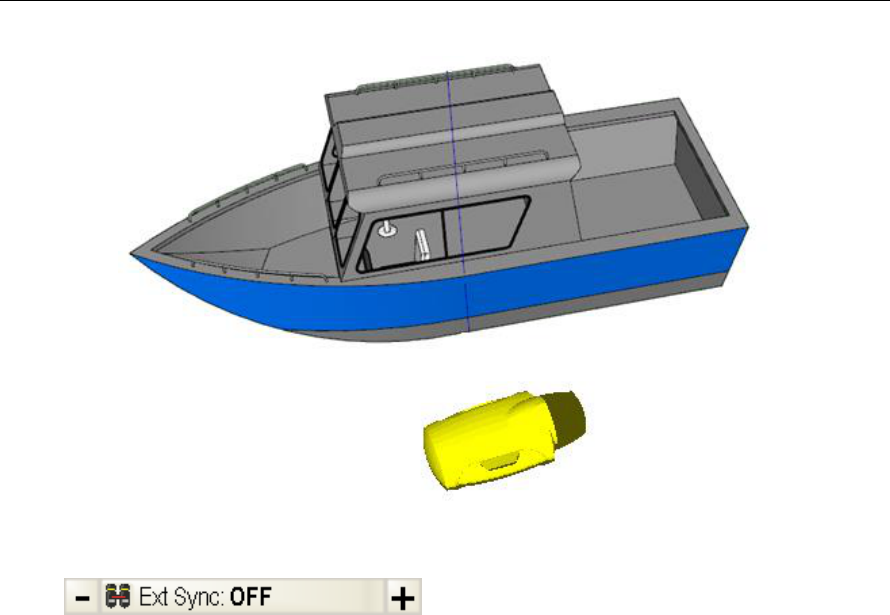
FS70 Trawl Sonar System
52 974-24007001/5.0
3.2.8.3 External Synchronization
Click to select the hardware synchronization mode.
The Hardware Synchronization is used in conjunction with devices with two hardware lines
(signal and ground) that may be used to synchronize transmit bursts of two or more sonar
heads or TTMs. Note that the Hardware Synchronization is only useful and applicable
when the heads are attached to separate telemetry lines. The selection options are:
Slave (Input): This head is synchronized with other heads. It pings only when the other
heads are ready to ping.
Master (Output): Allows other heads to synchronize to this head. This head runs free and
pings at it own time.
Select (Input/Output): It pings only when other heads are ready to ping. It also provides
the signals for other heads to synchronize to it.
Note that the heads in Input or Input/Output would only wait a total of 2 seconds for
synchronization signal, after which they proceed with a ping anyway.
3.2.8.4 Audio Setup

FS 70 System Operation
974-24007001/5.0 53
Click to open the Audio Settings dialog window.
3.2.8.5 Acoustic interference Filter
Click to enable the filter to filter out the acoustic
interference.
3.2.8.6 Palette selection
Click to select the palette to plot the sonar image.
3.2.8.7 Advanced Menu
Click to select the advanced menu. The advanced
menu contains the following items:
View: opens the View Menu
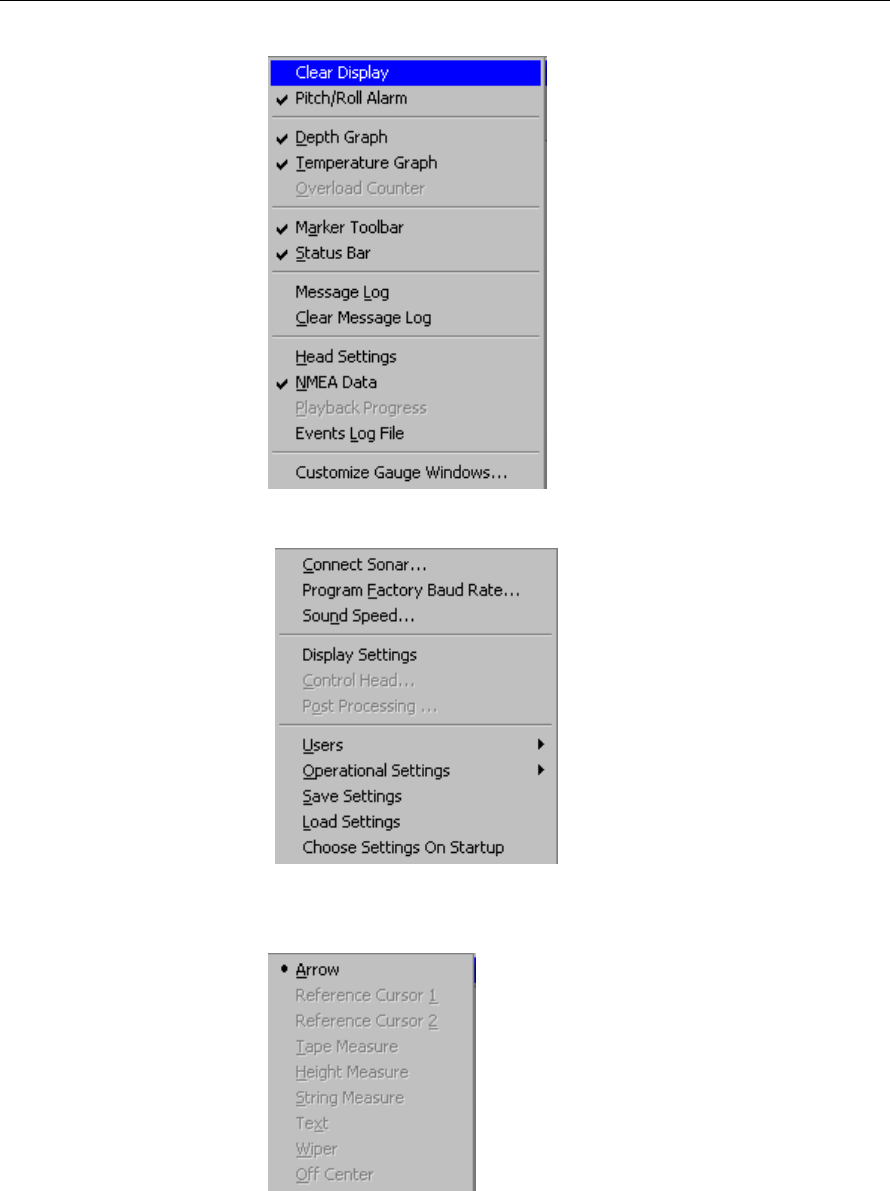
FS70 Trawl Sonar System
54 974-24007001/5.0
Configuration: opens the configuration menu
Tools: opens the tools menu
3.2.9 The Status Bar
The status bar uses different colours to indicate different status of the system.
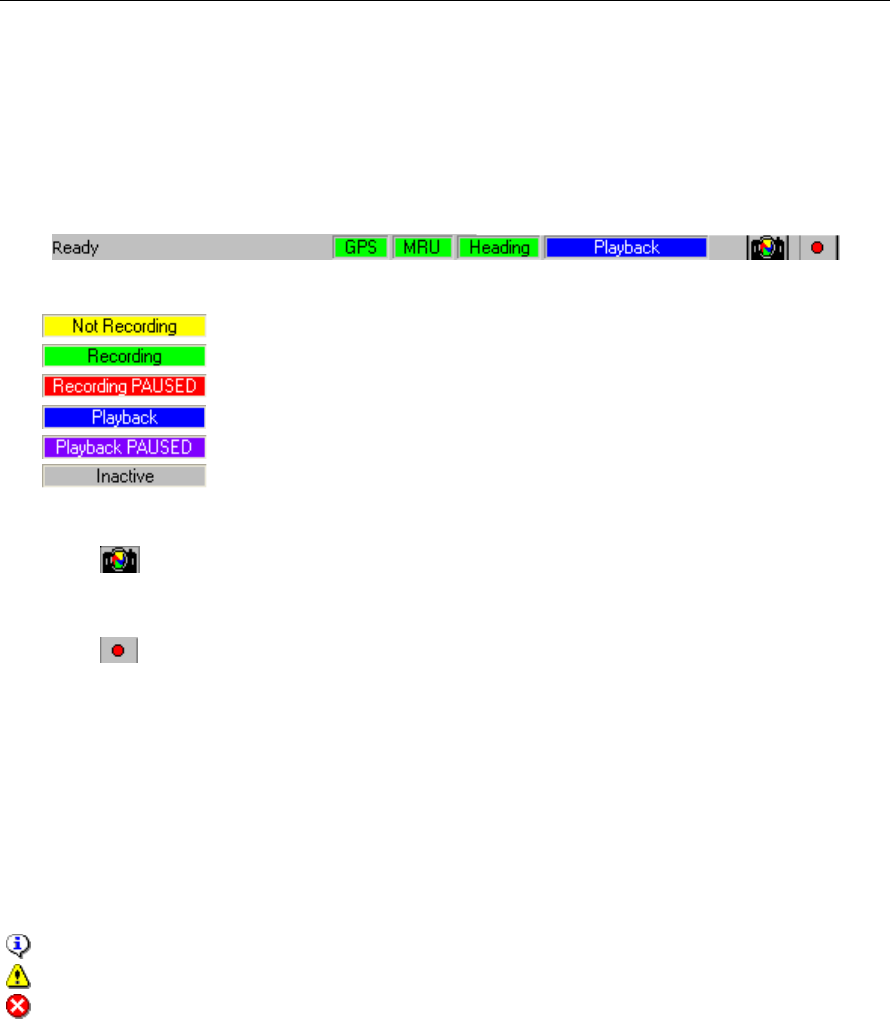
FS 70 System Operation
974-24007001/5.0 55
For NMEA sensors status:
Green means receiving sensor data with good quality.
Yellow means receiving sensor data with compromised quality.
Purple means sensor data conflict from multiple sensors.
Red means not receiving sensor data.
For System status:
sonar head is running, recording is not started
sonar head is running, recording is started
sonar head is running, recording is paused
sonar head is not running, playback is in progress.
sonar head is not running, playback is paused
system is inactive, not running sonar head, not playing back data.
One-click buttons:
Click to save a screen-shot without entering file name. The file is automatically
named with the current time and saved to \Diagnostic folder under the DATSS
installation directory.
Click to start recording without entering file name. The file is automatically named
with the current time and saved to \Diagnostic folder under the DATSS installation
directory.
3.2.10 The Message Log Window
The Message Log Window displays the system message logs, including information
messages, warning messages, error messages. Each message is displayed with an icon to
indicate the message type:
Information
Warning
Error
To show/hide the Message Log window by right click the sonar image display, click
Message Log.
3.2.11 The Context Menu
The Context menu can be accessed by right-clicking the sonar image window. It provides
quick access of the commonly used functions.
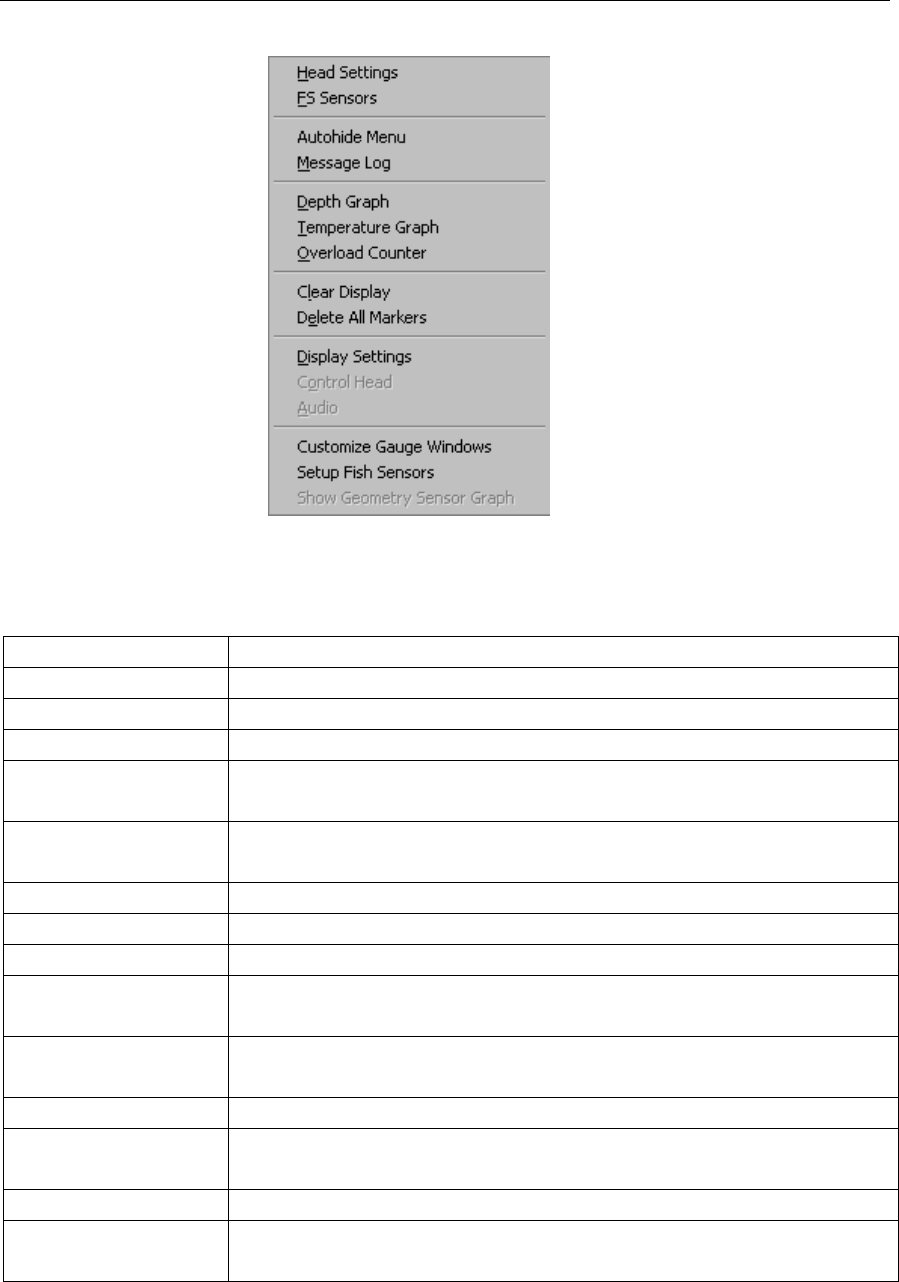
FS70 Trawl Sonar System
56 974-24007001/5.0
Menu items:
Head Settings
Opens the head settings gauge window.
FS Sensors
Opens the depth and temperature sensor gauge window.
Autohide Menu
Turn The Control Panel auto-hide on or off.
Message Log
Open / Close the Message Log Window
Depth Graph
Opens the depth graph window. The depth graph window displays
1 hour depth readings.
Temperature Graph
Opens the temperature graph window. The temperature graph
window displays 1 hour temperature readings.
Overload Counter
Opens the Overload Counter window.
Clear Display
Clear the current selected sonar image display.
Delete All Markers
Delete all markers on the display.
Display Settings
Opens the advanced display settings dialog box to change the
display settings.
Control Head
Opens the advanced head settings dialog box to change the sonar
head settings.
Audio
Opens the Audio Setup dialog.
Customize Gauge
Window
Opens the gauge window dialog box to define the gauge window.
Setup Fish Sensors
Opens the Fish Sensor Setup window to configure PI sensors.
Show Geometry
Sensor Graph
Opens the geometry sensor graph window. The geometry sensor
graph window displays 1 hour geometry sensor readings.

FS 70 System Operation
974-24007001/5.0 57
3.2.12 The System Menu
Click button to select one of the system modes.
Click button to open the help file.
3.2.13 The Sensor Indicator
The Sensor Indicator showing data from all the sensors with digits and symbols in data
windows. Numeric display shows the present value of the sensor data in easy to read digits
or symbols. Changes in values are indicated with digits showing rate of change combined
with graphic symbols.
3.2.13.1 Deployment pack sensors
Deployment pack sensors are installed with the deployment pack and indicates deployment
pack status.
3.2.13.2 Sensor Indicator Status
Sensor is configured, not activated.
Sensor is activated, no data received.
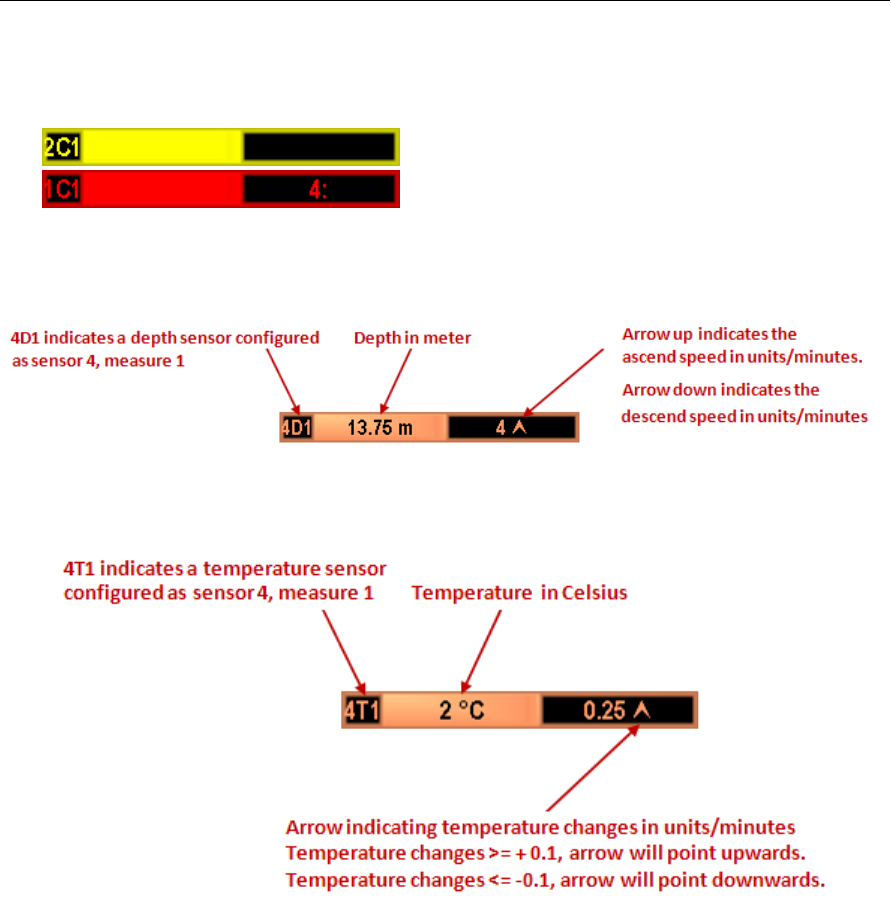
FS70 Trawl Sonar System
58 974-24007001/5.0
3.2.13.3 Catch Sensor Indicator
Catch sensor is activated, data valid.
Catch sensor is pulled, triggered the fish alarm
for 4 minutes.
3.2.13.4 Depth Sensor Indicator
3.2.13.5 Temperature Sensor Indicator
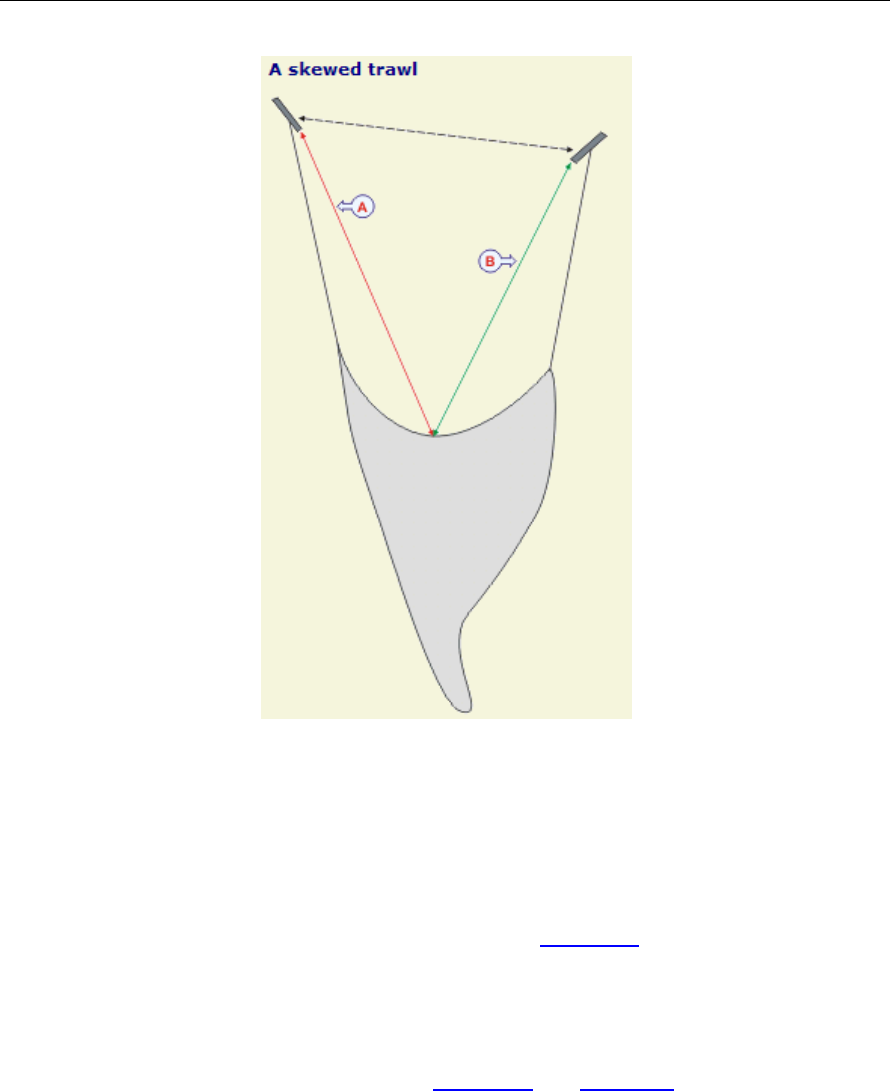
FS70 Trawl Sonar System
60 974-24007001/5.0
Skew = A - B
3.2.14 File Types
File extension Description:
EXP
ASCII files created during exporting. The extension of the
first file in a series is .EXP and subsequent are .e001, .e002
and so on.
LOG
ASCII files contain the system message logs.
SMB
Binary files for recording and playback. The first file is
indicated by the extension .smb and the subsequent files with
extensions 001, 002, 003, 004, 005, 006, 007, 008, 009.
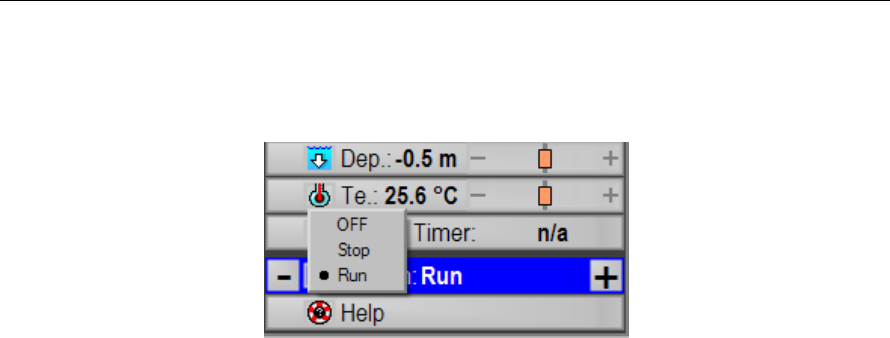
FS 70 System Operation
974-24007001/5.0 61
3.2.15 Activating the Sonar
When you click on the Run button the system will initialize the serial port and start the
calibration of each sonar head connected to the TTM module. When you click the Stop
button you will automatically disconnect the sonar heads from the system.
NOTE: If you only want to “PAUSE” the sonar image, just right click the mouse on
the Sonar “Run/PAUSE” Button located on the Operation Page. Left click the mouse
to “RUN” the system.

FS70 Trawl Sonar System
62 974-24007001/5.0
4 FS 70 Installation Instructions
4.1 Installation procedure
The installation of the FS 70 Trawl Monitoring System involves the following steps:
• Deciding on the locations in the wheel house for the surface units.
• Mounting the surface units and making the connections between the FS 70 Processor, the
display unit, the FS Power Supply/TTM interface unit, and other optional equipment being
installed.
• Assembling the trawl unit.
• Running up the system on the test cable to verify proper installation, configuring the control
unit, and performing initial system tests.
• Installing the cable winch, snatch block and trawl cable, and connecting the winch slip-
rings to the control unit.
• Mounting the trawl unit to the head rope and completing the final system test.
• Mounting the catch sensors to the cod-end of the trawl and other PI sensors.
4.2 Surface Unit Installation
4.2.1 Mounting of Units
The display unit should be located in the wheel house in a place that provides a good view of
the screen and avoids direct sunlight if possible. Depending on the monitor that was selected
the unit may be mounted on top or recessed into the bridge console.
The FS70 Processing unit should be mounted in close vicinity to the operator's position in the
wheel house and near the display unit. The unit may be mounted on top of the bridge console
or recessed into a cabinet. Note: You must have access to the ON/OFF switch and provide
proper ventilation to avoid overheating.
The Power Supply/TTM Interface Unit supplied with the system may be mounted on top of
the bridge console or recessed and flush mounted into the bridge console. Sufficient space
should be left around the control unit for proper ventilation.
Optional equipment for interface to the control unit may be mounted in any convenient
location provided the user supplied interconnects cables is of sufficient length and the
required power is available.

FS 70 Installation Instructions
974-24007001/5.0 63
NOTE: The Processing Unit and the Power/TTM must be connected to a dedicated
UPS.
4.2.2 Ship Power Requirement
The display unit, generally, will require 120 VAC or 230 VAC. Depending on the
capabilities of the unit chosen, it may automatically detect the supply voltage or the unit
may have to be ordered for the correct voltage.
The FS70 Processor will operate from either 120 VAC or 230 VAC. IF input voltage must be
selected then a voltage input selector switch is located at the rear of the unit. Some of the
processors are equipped with auto detection voltage input.
The FS Power Supply/TTM module can be operated with either 120 VAC or 230 VAC.
Selection of the supply voltage is done by moving the voltage selector card located in the
power entry module at the rear panel. Details on selecting the proper voltage are indicated on
the voltage card. You must position the “indicator pin” location to the desired voltage.
To change the input line voltage, use a small blade screwdriver and pop the cover. Pull the
voltage selector card straight out from the housing, and place the indicator pin to the
selected voltage. Reinsert the card, reinstall the cover and verify that the indicator shows
the desired voltage. You must insure that the proper fuse rating is installed, 2 A for 230
VAC and 4 A for 110 VAC. Spare fuses are supplied with the TTM module.
NOTE: Failure to select the proper input voltage will damage the internal power
supply.
4.2.3 Display Unit
Either an LCD/DVI or VGA monitor may be connected to the FS70 Processor. Depending
on which type of monitor is used, the video output type must be set accordingly.
An industry standard VGA monitor will connect directly to the miniature DB-15 connector
located on the rear panel of the processor unit.
The FS70 Processor Unit has a Dual Video interface card installed as standard equipment.
You must set up your display software as per your requirement. If you have only one
monitor, simply plug your monitor cable into the monitor “Y” adaptor connector marked
“Connector 1” on the adapter card. If you are using two monitors, you must connect the 2
nd
monitor to the “Connector 2” on the adapter card.
NOTE: The FS 70 Processor must be is turned “OFF” prior to connecting the video
monitors
A User Guide manual is provided with the system including a Recovery CD-ROM. With this
CD you can recover your system as delivered and run the diagnostics.

FS70 Trawl Sonar System
64 974-24007001/5.0
NOTE: The dual monitor software is installed at the factory, you only have to set up
your monitor configuration as per “Microsoft Window’s Operating System” provided
with the FS processor unit.
4.2.4 Power/TTM Unit
The Power/TTM Interface comes with the long line power supply incorporated in one unit,
thus making the installation easier.
The Front Panel comes with an ON/Off switch, trawl DC output voltage meter, amperage
meter and a four position trawl voltage rotary selection switch. The possible selections are;
“OFF”, “TEST”, “120 V” and “200 V”. A “TEST/TRAWL” selector switch and test cable
connector is also provided in the front panel.
The Rear Panel of the Power/TTM Interface comes with 110/230 VAC power input, master
ON/OFF switch and fuse located in the AC power entry module, and RS232 serial ports “A”,
“B” and “C” including the 3rd wire trawl cable connector.
4.2.5 Connecting the Processing Unit
The FS 70 Processor unit comes with the DATSS Trawl Sonar System operating software
installed by the factory.
NOTE: All Device drivers and utilities are preloaded on your system and provided on
a Driver, Utilities and documentation CD-ROM. This CD-ROM also includes tips for
re-installing the operating system.
The FS70 Industrial PC rear panel connectivity is described below. For other PC models, the
rear panel appearance may be different but the appearance and functionality of the standard
ports will be similar to the description below.
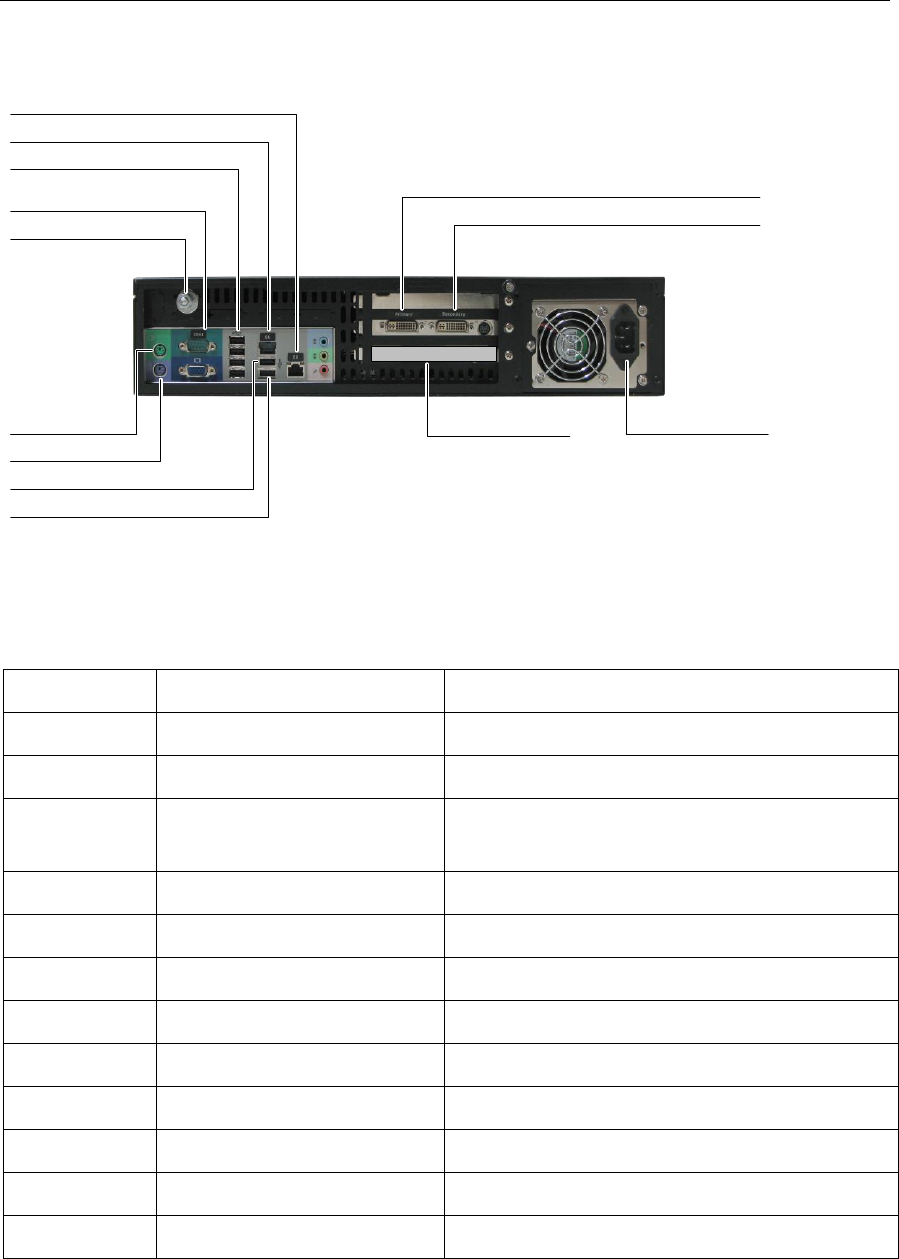
FS 70 Installation Instructions
974-24007001/5.0 65
C6 Ethernet 1
C7 Ethernet 2 Optional
C3 AC Power
C4 Mouse
C5 Keyboard
C1 Monitor (Primary)
C2 Monitor (Secondary)
C10 (FS USB to RS-232 Converter)
C9 Ground Wire (Optional)
C8 (COM 1) Port
Opti
C12 FS 70 USB Security Key Port
C11 (FS USB to RS-232 Converter)
Expansion Slot
FS 70 Industrial Processing
Rack Mount Unit
4.2.6 Interconnect Cables Description
ID #
Application
Description
C1
Video Connection
Standard Video cable supplied with monitor
C2
Video Connection
Standard Video cable supplied with monitor
C3
AC Power Input
Standard 110/230Vac cable supplied with
the processor
C4
PS2 Mouse
Logitech Trackman Trackball-STO Mouse
C5
PS2 Keyboard
Mini Cherry Keyboard
C6
Ethernet 1 Connection
Cat 5 RJ45 Ethernet cable “Optional”
C7
Ethernet 2 Connection
Cat 5 RJ45 Ethernet cable “Optional”
C8
RS232 Com Port
RS 232 Cable not supplied “Optional”
C9
Ground Wire Connection
Ground wire Cable not supplied “Optional”
C10
FS 70 USB Port
Connection for USB/RS232 Converter
C11
FS 70 USB Port
Connection for USB/RS232 Converter
C12
FS 70 USB Port
Connection for USB FS 70 Security Key

FS70 Trawl Sonar System
66 974-24007001/5.0
4.2.7 Connection the USB Security Key “Dongle”
The security key “USB Dongle” is require to run the FS 70 host software and must be
connect the to a USB port located at the rear of the processing Unit. Connect the key as
indicated in the above DWG located in paragraph 4.2.5.
NOTE: The security key “Dongle” is NOT a “Flash Memory USB” stick.
4.2.8 Connecting the USB/RS232 to the TTM Unit
Connect the 2 meter USB cable to the USB/RS232 Converter; next connect the USB side of
the converter to one of the USB ports located on the PC and the RS232 connector to the
Port “A” of the TTM unit. Note: The Port “A” of all TTM units is assigned for the Vertical
Sonar Head, referred as “LF1” telemetry. Port “B” is assigned to “LF2” telemetry required
for the forward looking sonar or may be assigned to the “HF1” telemetry required to run the
FS70 Sim-Sounder option. If you do have a TTM with the LF2 or HF1 connect the 2
nd
USB/RS232 as indicated below.
Refer to the DWG below for all connections:

FS 70 Installation Instructions
974-24007001/5.0 67
USB/RS232 Dual Channels Telemetry Converter part number 901-80010000
4.2.9 Connecting a GPS
The GPS NMEA 183 output can be connected to the serial port at the rear of the processing
unit. The interconnect cable is not supplied.
The pin connections for your GPS input/output PC/RS232 are as follows:
• Pin number “2” - 232 Rx,
• Pin number “3” - 232 Tx,
• Pin number “5” - GND.
4.2.10 Connecting a Echo Sounder
The FS 70 Processor Unit may be connected to an echo sounder for display of the trawl unit
depth on the sounder. This is made via the RS232 serial port on the rear panel of the
processing unit or an RS232/USB converter. The processor will output the Temperature
and the Depth from the trawl integrated sensor module in the NMEA 0183 format.
If port “B” is not available you will have to install an additional serial card or install an
RS232/USB external converter.
4.2.11 Connecting a Heading Sensor
If you need to connect a heading sensor output to the serial port at the rear of the processing
unit, you will have to install an additional serial card in the Processing Unit or install an
RS232/USB external converter. The pinout for your heading sensor input/output RS232
connection is as follows:
• Pin number “2” 232 Rx,
• Pin number “3” 232 Tx,
• Pin number “5” GND.
For additional information, please refer to the User’s Guide supplied with the system.

FS70 Trawl Sonar System
68 974-24007001/5.0
4.2.12 Connection to Cable Winch/Slip-Rings
The connection between the FS TTM Interface unit and the cable winch/slip-rings should
be made with a 12AWG or heavier, shielded pair cable. The connection to the control unit
is made using the 3-pin MS connector supplied in the TTM module accessory kit. To
minimize noise interference on the cable, the shield of the cable should be attached to the
connector.
NOTES:
1. The shield of the cable between the FS TTM module and the slip-rings should be
connected at the TTM module, but NOT at the slip-rings.
2. Based on experience from previous installations, good results were achieved using a
section of your 3rd wire cable for this connection.
4.2.13 Assembling of the Trawl Unit
Assembling the trawl unit for the first time should be conducted in the wheel house where
the surface unit electronics have been mounted. This will facilitate testing the trawl unit
using the test cable.
4.2.14 FS 70 Configuration
The FS 70 trawl configurations all consist of an FS 70, 120 kHz or 330 kHz vertical sonar
head with a 200 kHz echo sounder, an FS 70 sensor module is integrated in the trawl sonar
head. The FS 70 polyurethane housing includes mounting and assembling hardware and a
strain relief. The trawl unit also contains a catch receiver unit and the echo sounder
transducer. Assembly of the unit involves correctly locating the sonar head, attaching the
strain relief to the trawl cable, proper routing and connection of the cable to the sonar head
and bolting the polyurethane housing together. This section describes the connection and
location of the sonar head, echo sounder transducer and catch receive transducer. Final
assembly is illustrated in the “Drawings” section.
A locating block positioned at the end of the housing or a guide bracket is used to prevent the
sonar head from rotating. Only one guide block is required and it can be placed into the
positioning hole of the bottom half of the trawl unit housing as shown in the assembly
drawing in Chapter 6.
NOTE: Dow Corning “#55” grease must be applied to all mating surfaces of
underwater connectors to insure proper sealing. Sufficient grease should be applied so
that excess squeezes out with any air when the connectors are mated. RTV or any
other sealant must NOT be used, and when tightening the locking sleeves, do NOT use
a wrench or pliers!

FS 70 Installation Instructions
974-24007001/5.0 69
4.3 System Set-up and Testing using the test
cable
Initial power-up, set-up and test of the system should be made with the trawl unit connected
to the PWR/TTM module using the supplied test cable. The 3-pin MS connector of the test
cable is attached to the connector labelled “TEST CABLE” located on the front panel of the
PWR/TTM unit. The other end of the test cable is plugged into the 2-pin connector on the
sonar head of the trawl unit.
4.3.1 FS Processor & TTM Communication Set-Up
The commnunication between the FS Processor and the TTM unit can be achive 3 ways
depending on the type of communication ports available in the processor unit:
1. If standard serial COM ports are available you may use a RS232 Null Modem cable,
KML part number 144-0217, supplied with the processor.
2. If USB ports are available then use the USB/RS232 telemetry converter, KML part
number 901-80010000, supplied with the processor.
4.3.2 Start Up
1. Check that the system has been properly installed and that all connections have been made
to the PWR/TTM and the Processing Unit.
2. First turn on the PWR/TTM interface module. The voltmeter should display
approximately 120 volts if on “120VDC” setting, 200 volts if on the “200VDC” setting
and approximately 60 volts if on “TEST” setting. The current meter should read
approximately 0.15 – 0.7 amps.
3. Next turn on the display monitor, and then turn on the processing unit. The system will
start up automatically.
4.3.3 Power-Up Configuration
For the system to operate properly the trawl unit configuration must be selected correctly.
In addition, modification of these power-up configuration parameters is done in a special
mode selected after power-up of the Processor unit.
The following sections describe the process of configuring these parameters. These steps
must be followed only when the system is powered-up for the first time or when you have to
replace the Processing unit or the TTM Module assembly.
4.3.4 Selecting the Trawl Output Voltage
You must select the proper trawl voltage in accordance with the underwater trawl unit system
you are using,

FS70 Trawl Sonar System
70 974-24007001/5.0
In the “OFF” position, no voltage is applied to the trawl cable.
In the “TEST” position, 60 VDC will be provided to the trawl cable. Note: The “TEST”
position is provided for the old FS 3300, 1000 meter sonar head. You must connect the test
cable supplied with the system to the front panel connector of the TTM marked “TEST
CABLE” and position the Trawl/Test switch located on the front panel of the TTM module to
“TEST”.
In the “120 V” position, 120 VDC will be provided to the trawl cable. The 120 VDC is
provided to run all FS3300, 1800 meter sonar head. The same procedure should be used to
test an FS3300 1800 meter head.
In the “200V” position, 200VDC will be provided to the trawl cable. The 200VDC is
provided to run all TS10, TS15, TS15S and the FS70 sonar heads.
NOTE: To test a TS10, TS15, TS15S and FS70 sonar head position the trawl voltage
switch to 120 VDC, connect the test cable supplied with the system to the front panel
connector marked “TEST CABLE” and position the Trawl/Test switch located on the
front panel of the TTM Interface Unit to “TEST”.
WARNING: Make sure you have selected the trawl voltage for the appropriate sonar
head before turning power ON.
4.3.5 Final System Test
After preparing the trawl cable and before the final trawl unit assembly a system test should
be conducted to insure correct operation of the FS 70 Trawl Monitoring System over the
trawl cable.
As before, the start- up procedures should be followed to power up the system. Once the FS
70 has been turned on, the power supply voltage and current meters should be examined.
Expected values are 0.2 – 0.5 A, (output voltage selection switch should be set to 200VDC).
If the voltage and current values differ significantly from these values, it indicates a problem
with the trawl cable or its connections.
If there are any errors during the calibration a status report page will appear containing the
results that the control unit obtained from the tests performed. Again, any errors will be due
to the trawl cable or its connections. Check the connections again and ensure that the signal
polarity at the trawl unit is correct. A DC voltmeter can be used to check that the positive
voltage is on the small pin of the pigtail when the FS PWR/TTM unit is powered up.
If all is okay then the sonar head will begin scanning and the sonar image display will appear.

FS 70 Installation Instructions
974-24007001/5.0 71
4.3.6 Completing the Trawl Unit Assembly
First, the plastic cable strain relief supplied with the trawl unit must be bolted to the trawl
cable. The location should be at or very near the pigtail splice, but NOT on the pigtail
itself. You must slide the rubber hose on the trawl cable, if used, down so that
approximately 3.4 cm (1’.2") of the hose is clamped inside the strain relief.
Next, the trawl cable is connected to the sonar head. Liberal amounts of Dow Corning #55
grease are applied to the connector surfaces before mating so that a water tight seal is
obtained. The locking sleeve is then hand-tightened.
NOTE: Dow Corning “#55” grease must be applied to all mating surfaces of
underwater connectors to insure proper sealing. Sufficient grease should be applied
so that excess squeezes out with any air when the connectors are mated. RTV or any
other sealant must NOT be used, and when tightening the locking sleeves do NOT use
a wrench or pliers!
The plastic strain relief attached to the trawl cable is now placed in the trawl unit housing
containing the electronics and the excess cable is routed in the housing. Care must be taken
to insure that all cables within the trawl unit housing are properly placed to avoid being
pinched and possibly damaged. The top half of the trawl unit housing is then placed on top
and the two halves are secured together with the bolts supplied. Finally, the dome is secured
over the Vertical Sonar Head transducer with four additional bolts.
The fully assembled trawl unit is now ready for mounting to the trawl head rope in the chosen
manner.
4.3.7 Mounting the Catch Sensors
Proper mounting of the catch sensors on the cod-end is shown in drawing # 830-056482.
The fill of the cod-end and the sensitivity of the sensors are dependent upon the number of
mesh knots between the catch sensor and the rubber straps. Make sure that the sensor is
mounted in the correct direction with the transducer pointing towards the trawl unit (the
metal lid pointing aft).
WARNING: Make sure that the chains do not strain the net when the cod-end is being
filled with fish. This is controlled by stretching the net to capacity in the direction which
is relevant AFTER THE SENSORS HAVE BEEN MOUNTED TO THE TRAWL. The
purpose of the chains is to prevent the sensor from turning, and as an insurance against
loss should the rubber straps break. Mounting the chains too tight can result in the
fastening ears being ripped off.
If a system with four catch sensors has been ordered, sensors numbered 1 and 2 can be used
on the trawl and the other two sensors kept for reserve.

FS70 Trawl Sonar System
72 974-24007001/5.0
For deep trawling, and when fish are abundant, it can be advantageous to mount three or four
catch indicators in such a way that cod-end filling can be monitored continuously to insure
that the trawl is hauled back in time.
4.3.8 Mounting the Geometry Sensors

FS 70 Installation Instructions
974-24007001/5.0 73
The PI Geometry sensors are mounted behind the headrope at the top of the trawl opening,
or behind the footrope at the bottom depending on the required application.
The two Mini-R responders are normally mounted in dedicated adaptors on the two doors.
They may also be mounted on the trawl wings.
Communication link between the PI sensors and the two Mini-R responders may be done
via the FS 70 head rope unit forward hydrophone located inside the DP housing or via the
PI hydrophone mounted below the ship hull.
Refer to the SIMRAD supplied PI Net Geometry Installation Manual for additional
information.
4.3.9 PI Receiver Basic Configuration Settings
When you put the PI Geometry to use, you must set it up with one unique sensor number
with two measurements. Only one update rate can be chosen, this is common for both
measurements. The channel numbers are defined individually for the two measurements.
Both the update rate and the channel numbers must be chosen according to the sensor’s
configuration. Write down this configuration for future reference.
For default settings, to the SIMRAD supplied PI Net Geometry Installation Manual table in
section about sensor configuration.
If your PI system is fitted with MMI software version 0.50 and DSP software version 1.11
or later, use the following recommended receiver settings:
– Interference filter: On
– Interference filter level: 8
– Sensor filter: Light
– Catch/Bottom sensor filter: Light
– AGC: Off
– Manual gain: 20 dB
– Multipath filter: On
– Water profile: Salt
– Detection threshold (DT): 8 dB
– Maximum shooting speed: 1 knot

FS70 Trawl Sonar System
74 974-24007001/5.0
5 Troubleshooting and Maintenance
5.1 Introduction
This section provides instructions for the proper handling, maintenance and troubleshooting
of the FS 70 Trawl Monitoring System.
5.2 System overview
The Simrad FS Trawl Monitoring System FS 70 consists of wheelhouse electronics and a
trawl unit. The wheelhouse electronics include the display unit, the FS Processing Unit,
and the PWR/TTM interface unit. The trawl unit electronics include the sonar head with a
integrated sensor module, receiver transducer, and up to four catch sensors and door
spreads sensors. In addition to the above equipment, but not supplied by Simrad, the
system requires a winch with slip-rings, and a trawl cable for connection of the FS trawl
unit to the wheelhouse electronics.
The FS PWR/TTM unit contains the power modules to provide the Test Voltage, the 120
and 200 VDC @ 1 A maximum for powering the trawl unit electronics, and the voltage and
ampere meters. The low-frequency telemetry adapter “LF 1” Low Frequency PCB and the
telemetry translation module “TTM” PC interface is now incorporated into one unit.
With the FS 70 system, the trawl cable connects directly to the PWR/TTM unit.
Furthermore, the compensation for signal loss over the long trawl cable is done
automatically within the Processor Unit each time it is powered up. In this way changes to
the cable loss do not affect the intensity of the sonar return displayed.
5.3 Handling & maintenance
The most common causes of failures to the Simrad FS Trawl Monitoring system are:
1. Trawl cable and/or winch slip-ring problems,
2. Sonar head and sensor module connector and interconnect cable failures,
3. Excessive impacts and/or physical damage to trawl unit electronics.
In all three cases, proper handling and maintenance can significantly reduce the frequency
of FS failures. The following sections outline the recommended handling and maintenance
for the FS system.

Troubleshooting and Maintenance
974-24007001/5.0 75
5.3.1 Wheelhouse Electronics
Once installed these units require little maintenance other than removing dust. A damp,
lint-free cloth should be used for this purpose.
5.3.2 Trawl Unit
The Trawl Unit is subjected to the harshest conditions and therefore proper handling and
maintenance is crucial to ensure trouble free operation.
5.3.2.1 Handling Tips
Though the trawl unit electronics are ruggedized for the fishing environment
mishandling or repeated impacts may result in damage to, or failure of, the electronic
components. Care should be taken at all times to avoid dropping or impacting the
trawl unit or the individual components.
Avoid scratching the surface of the sonar head housings. The anodized surfaces (black
coating) are there to protect the electronic housings from corrosion and any damage to
these surfaces will increase the likelihood of corrosion.
Ensure correct installation of the sonar head into the trawl housing to avoid improper
operation. A locking block is located at the end cap to secure the sonar head into the
lower part of the housing.
Protect connector mating surfaces from corrosion and damage. At the first sign of
damage, connectors should be replaced!
Pigtails must be properly attached to the trawl cable and the connector mating surface
must be protected from moisture and dirt at all times. Failure to do this may result in
water damage to the cable causing improper operation of the sonar system.
5.3.2.2 Maintenance Schedule
For optimum performance and trouble free operation, follow the maintenance schedule
below.
Beginning of Fishing Season
Service all connectors
Every Two Weeks of Continuous Use
The trawl unit package should be opened and the components cleaned with fresh water.
The trawl sonar head should be inspected for corrosion or damage. Service all connectors.
The FS processor should be checked and cleaned if required.

FS70 Trawl Sonar System
76 974-24007001/5.0
End of Fishing Season
The trawl unit package should be opened and the components cleaned with fresh water.
The trawl sonar head should be inspected for corrosion or damage. Service all connectors
and cover them with plastic. Store unit in a dry, clean area.
Every Twelve (12) Months Heavy usage or Every Two Years
Return the trawl sonar to a qualified Simrad service facility for inspection of connectors,
seals and shaft assembly. Have parts replaced as required.
Every Four Years
The trawl sonar head should be returned to a qualified Simrad service facility for
recalibration and upgrade to the latest specifications, and inspection of connectors and
housings for damage.
5.3.2.3 Connector Maintenance
Proper connector maintenance is crucial to the prevention of connector failure that may
result in failure of the sonar system and possible water damage to the sonar head. The
following steps should be taken whenever the connectors are assembled, or at regular
intervals as outlined in the “Maintenance Schedule” section above.
1. Wipe connectors clean of old grease and dirt with a lint free cloth.
2. Inspect the connector’s metal contacts and sealing surfaces for corrosion, wear or
damage. If problems are found, return the unit to a qualified Simrad service facility for
replacement of the connector!
3. Apply liberal amounts of Dow Corning “55” grease to each of the connector prongs and
to the sealing surfaces of the connectors. Do not use a silicone rubber adhesive
sealant!
4. Press connectors together until fully seated. Excess grease should be squeezed out of
the connector sockets.
5. Hands tighten the locking sleeve. Do not use a wrench or pliers!
6. When separating the connectors, avoid wrenching or bending connector.
WARNING: Failure to correctly maintain connectors may cause damage to the system
and will void the warranty.

Troubleshooting and Maintenance
974-24007001/5.0 77
5.3.2.4 Excessive Impacts
Though the FS Trawl Unit is designed for the harsh fishing environment, excessive impacts
to the trawl unit or the individual components may damage them.
Excessive impacts to the trawl unit usually result in physical damage to this housing.
However with the newer, more durable urethane housing, excessive impacts to the trawl
unit may NOT cause physical damage to either the trawl housing or the exterior of the
individual electronic units, but may result in damage to the electronics.
NOTE: As with all electronics, careful handling of the trawl unit will reduce the
likelihood of FS failures.
5.3.2.5 Corrosion
If on examination corrosion has occurred to the sonar head metal parts these areas should
be cleaned well and the area sealed with paint or a sealant to prevent continuation of the
corrosion in this area.
WARNING: If corrosion is allowed to continue, flooding of the unit may result.
5.3.2.6 Shaft or Transducer Damage
The transducer and shaft are protected by a flexible dome and should be inspected for
damage. If the transducer dome has experienced an impact this could bend the shaft and
eventually allow water into the housing. If the shaft is bent the unit should be returned to a
qualified Simrad service facility for replacement of the shaft seal assembly.
NOTE: If the sonar head is correctly installed in the trawl unit, with proper
placement of the locating block, then damage to the transducer and shaft
should not occur.
5.3.3 FA 701 Catch and PI Sensors
The catch sensors are relatively maintenance free except to charge the batteries. Refer to
your Simrad FA701 and or PI 32 Catch sensors operator and installation manual for the
information on both the charging of the catch sensors and the proper mounting of these
sensors on the trawl.
5.3.4 Winch Slip-Rings and Trawl Cable
The winch slip-rings and trawl cable are the umbilical cord between the processor unit and
trawl unit electronics, and are critical to the proper operation of the Simrad FS Trawl
Monitoring system. Damaged, worn or poorly maintained cable or slip-rings will degrade
the performance of the system and may cause or lead to a complete system failure.

FS70 Trawl Sonar System
78 974-24007001/5.0
Worn, dirty or wet winch slip-rings may add noise, current spikes or additional losses to
cable. Slip-ring assemblies should be checked regularly for wear and proper sealing against
the weather. Slip-ring technology has improved considerably over the past several years
and sealed units from several suppliers (such as IEC Corp.) have proven to be very reliable.
Trawl cables, particularly the plastic jacketed type, are extremely susceptible to damage
and wear that may adversely affect system operation. Proper maintenance is very important
to ensure cable losses are minimized and adequate isolation between the cable conductors
and sea water are maintained. Common problems include poor splices, water damage,
cracked or worn outer casing (insulating jacket), or severed cable. The trawl cable should
be routinely checked for damage and affected sections removed, splices redone or the entire
cable replaced as required.
The pigtails spliced to the end of the trawl cable are susceptible to damage and corrosion
and must be checked and if necessary replaced every time prior to connecting the trawl
unit. When not in use the pigtail should be wrapped in a plastic bag and stored out of the
weather and away from being stepped on or damaged in any other way.
Polarity of the signals applied to the trawl cable (coax) may also be important in the proper
operation of the system. To provide optimum shielding from noise, we recommend the
positive signal be applied to the center conductor and the negative signal to the shield.
5.4 On-board System Troubleshooting
There are a number of tools available with the FS Trawl Monitoring system that allows its
performance to be checked. When these tools are utilized as part of the regular
maintenance they provide information about the state of the system and allow it to be
monitored. This can be valuable in detecting problems before they cause an FS system
failure.
In the event the FS Trawl Monitoring system does not operate, correct care must be taken
to properly diagnose the cause of the failure. Quite often the failure is thought to be with
the FS electronics when the actual cause is due to the winch slip-rings, the interconnect
cable or the trawl cable. The following sections provide helpful advice on troubleshooting
the FS system.
5.4.1 System Tools
The system tools available for troubleshooting the FS system are:
Test Cable
Voltage and Current Meters
Cable Gain Number

Troubleshooting and Maintenance
974-24007001/5.0 79
Cable Voltage and Resistance
System Info Page
Diagnostic Recording “SMB Format”
Errors Message Log File
4 Hrs of Auto Recording “SMB Format”
User Recording “SMB Format”
Sonar Images and System Text Document “Bitmap Image Format”
5.4.2 Test Cable
With every FS Trawl Monitoring system a 50’ test cable is supplied for testing the system
without requiring the 3
rd
wire trawl cable. This provides a quick and simple way of
verifying whether problems are due to the trawl cable or winch slip-rings.
NOTE: The initial system performance values that are measured on the test cable
during the installation and commissioning of the system provide a base for later
comparison.
5.4.3 Power Supply Meter Readings
The 3
rd
wire trawl cable voltage and ampere meters are useful for monitoring the trawl unit
power requirements. For the most benefit these meters are mounted on the front panel of
the PWR/TTM unit next to the trawl voltage selection switch for continuous monitoring.
When the system is first installed or when the trawl cable is replaced the trawl cable voltage
selection switch should be set to 200 VDC and current values should be recorded when the
unit is running in normal operating mode (i.e., with range and scan speed set to values
normally used during fishing) or set to the Factory Default Setting.
Typical “Current Meter” values will typically vary from 190 mA to 350 mA depending on
the type of sonar head connected to the 3
rd
wire. To facilitate monitoring of this information
these values should be recorded on the test report charts provided at the end of this manual.
Any changes in the recorded meter values during normal operation may indicate a potential
problem even if the unit continues to operate properly. Common cases are:
1. Current Meter Jitters:
This is commonly due to dirty, wet or worn winch slip-rings that cause current spikes on
the trawl cable when the winch is rotating.
A test for slip-ring problems is to slow down the winch (at high winch speeds you will not
see jitter on the current meters) and check if the current meter is jittering and whether the
jitter rate changes with the winch speed.

FS70 Trawl Sonar System
80 974-24007001/5.0
Note: The current meter will pulse each time the transmitter pings. The pulse will be at a
constant rate depending on your operating setting.
2. Increase in Current:
Gradual increases in the trawl unit current may be due to either the trawl cable or the trawl
unit electronics. A higher cable closed loop resistance, due to cable damage, poor splices,
poor winch slip-rings or water ingress in the cable may reduce the voltage supplied to the
sonar head below the required minimum DC voltage. This will result in the sonar head
drawing more current. Alternatively there may be a problem in the sonar head that causes
additional current draw.
To diagnose this problem a current reading should be made with the system running on the
test cable. If this value is higher than a previous value obtained on the test cable or when
connected to the cable simulator then the problem is likely with the trawl unit electronics. If
the current readings are the same on test the cable as previously obtained, then the trawl
cable and winch slip-rings should be checked.
5.4.4 Trawl Cable Gain
By periodically checking the cable compensation gain obtained from the system unit and
comparing it to a previously recorded value the condition of the 3
rd
wire trawl cable can be
monitored. Acceptable cable gain values have less than “10, XXX” for the first gain
number. If the first gain value is over “10, XXX” then there may be a problem with the 3
rd
wire trawl cable and the system should be checked on the test cable. To facilitate
monitoring of the trawl cable, the cable gain values should be recorded on the test report.
5.4.5 Testing the Trawl Cable
If after testing the FS system the trawl cable is suspected to be faulty, then troubleshooting
is needed to determine what and where the problem is. For problems that are not obvious,
however, this can be quite difficult to do and may require someone experienced with testing
trawl cables. This following paragraph provides some basic tips in troubleshooting trawl
cables but is in no way a complete and comprehensive guide.
5.4.5.1 Trawl Cable Insulation Measurement
The use of a Mega-Ohmmeter to check the impedance of the trawl cable may be the most
useful test. It can be done with or without the slip-rings connected and readings should be
taken between the cable’s two conductors and also from each conductor to the fishing
vessels hull. Typically the impedance should be greater than 2 MΩ, and preferably over 6
MΩ and lower readings may be indicative of potential problems with the third wire cabling.

Troubleshooting and Maintenance
974-24007001/5.0 81
Caution: The FS system MUST be disconnected from trawl cable during Mega-
Ohmmeter tests to prevent possible damage to the electronics!
If the impedance between the cable’s two conductors is relatively low then the cable should
be inspected for possible problems with splices, water ingress, and moisture in slip-rings (if
connected during test).
If the impedance between the cable’s conductors and the vessel’s hull is relatively low then
inspect the cable for any visible damage to the cable armour/jacket. Other possible causes
are bad splices or bad slip-rings (if connected during test)
5.4.5.2 Closed Loop Resistance, Voltage and Current at Trawl
Unit
As previously mentioned, the closed loop resistance must be less than 100 Ohms for proper
operation of the FS system.
This test should be done with the FS system disconnected but with the winch slip-rings
included. For whatever cable type and length used the following specifications must be met
for operation with the Simrad FS trawl Monitoring system:
Cable Closed Loop Resistance <100 ohms
Signal Attenuation Through Cable:
<40 dB (1/100 signal amplitude) @ 55 kHz
<20 dB (1/10 signal amplitude) @ 12 kHz
The cable closed loop resistance determines the maximum voltage drop along the trawl
cable. For proper operation the FS 70 trawl unit electronics require a supply voltage of 60
to 200 VDC. For typical operation, the current is approximately 195 mA to 250 mA with
peaks to 450 mA. The equations for calculating the voltage drop along the trawl cable are
described in the next paragraph.
There are two methods to check the closed loop resistance of the 3
rd
wire:
Method 1
To do the test the conductors at one end of cable should be shorted together. An ohmmeter
is then used at the other end of cable to measure the resistance between the conductors.
Method 2
An estimate of cable losses and resistance can be done by measuring the voltage and
current at the trawl unit. This measurement requires the trawl unit electronics to be
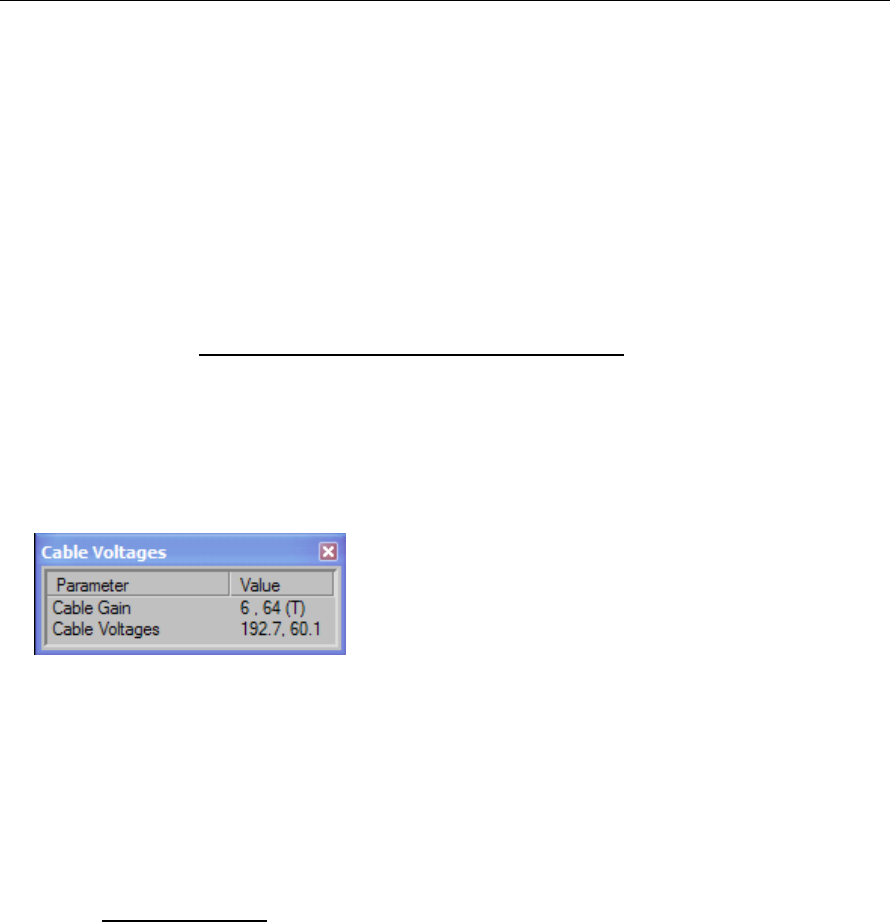
FS70 Trawl Sonar System
82 974-24007001/5.0
connected and the FS system powered up. This test is done where the trawl cable pigtail
plugs into the sonar head.
The cable closed loop resistance determines the maximum voltage drop along the trawl
cable. For proper operation, the FS Trawl Sonar System requires between 120 VDC or 200
VDC @ 1 A maximum depending on the type of sonar head you are using. For typical
operation, the current is approximately 195 mA to 350 mA with peaks to up to 450 mA.
The equation for calculating the resistance of the 3
rd
wire trawl cable from the TTM to the
sonar head is:
Cable Resistance =
Example:
The TTM output DC voltage is set at 200 VDC.
The Cable Voltage at the head is 192.7 VDC
Total DC voltage drop along the 3
rd
wire cable is 7.3 VDC.
The TTM AMP meter located on the front panel indicate a current of 0.3 A. Therefore the
calculated total resistance of the 3
rd
wire cable is:
R =
The maximum allowable closed loop cable resistance is 100 ohms.
5.4.5.3 Test for Water Ingress in the Trawl Cable
When a trawl cable is damaged or there is a poor splice, sea water can get into the cable.
As a result, the cable may act as a battery - producing a small dc voltage across the
conductors of the cable. This is detrimental to the operation of the FS system and all
affected cable should be removed.

Troubleshooting and Maintenance
974-24007001/5.0 83
To test for this the trawl cable should be disconnected from the FS system and a voltage
meter connected to the trawl unit end of the cable. If water is present, then there may be a
reading of 2 - 3 volts.
5.4.6 Telemetry Errors
In the normal operation of the FS Trawl Monitoring system commands are sent from the
processor unit down the trawl cable to the trawl unit electronics and acknowledgments are
then sent back up to the processor unit. Some error checking of these commands is
performed to monitor the performance of the Uplink and Downlink telemetry.
Telemetry errors can result from noise induced on the trawl cable due to interference or
problems with the 3
rd
wire trawl cable or trawl unit electronics.
Though a few telemetry errors are quite common and acceptable, an excessive number of
errors will adversely affect the sonar operation and may indicate a problem that will
eventually cause a system failure.
The most common type of telemetry errors is time-outs. This problem indicates the trawl
unit electronics are not responding to the processor unit or the integrated sensor module is
not responding to the sonar head.
If the processor unit displays changes in the “Baud Rate” (highlighted in red and flashing)
the change indicates that the Uplink signal to the processor may have a problem then refer
to the “Message Log” file and record the “Errors” including the cable gain number values
and make note of any other failure.
If no errors are recorded in the “Message Log” file, then re-set the baud rate to 115.2 kbps
and implement a system re-calibration. Next record the results obtained. The changes may
have been caused by noise or other interference.
5.4.7 Diagnostic Recordings
The system will save your screen displays in three different ways. Two of these ways are
manually started by the operator and the third is automatically managed by the system. All
three methods create files on the system which can be sent to your service provider for
analysis.
5.4.8 System Info Page
The System Info Page provides all the pertinent information required by the factory in order
to assist you in troubleshooting the FS system on-board the vessel.
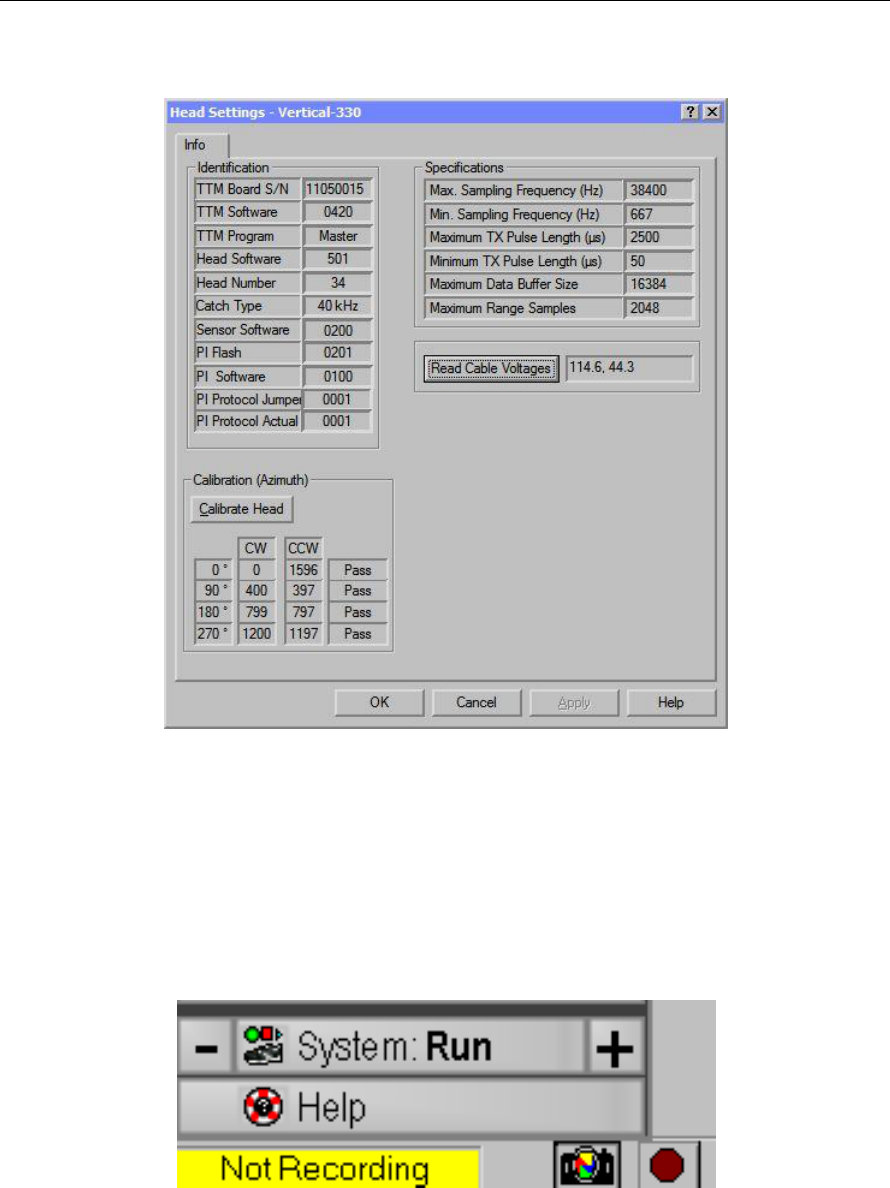
FS70 Trawl Sonar System
84 974-24007001/5.0
5.4.9 Bitmap “Snapshots” Sonar Image
The system will allow you to save snapshots of the screen display. In the lower right hand
corner of the display you will see the following display.

Troubleshooting and Maintenance
974-24007001/5.0 85
To take a snapshot of your display simply left click on the camera icon. A snapshot will be
saved in the “diagnostic” folder. When you click the camera icon a grey message box will
appear in the top left hand side of your display stating ”Saving a sonar image. Please wait.”
This box will only appear for a second or two but confirms that you have taken a picture
and that it has been saved. The snapshot saved will be only of the active window on your
display – either the vertical head or the sounder. The system saves both a video picture of
your display and a text file listing all of your system settings.
5.4.10 Manual Recordings
You can, at any time, start a recording of your display. To start the recording left clicks on
the red button beside the camera icon, (see image above). The recording will continue until
you stop it by clicking on the same button again. These recordings are saved into the
“record” folder.
The traditional way of starting a recording also still exists on the system. Go to the display
toolbar and turn the Record Toolbar on. The traditional recording toolbar will appear on
the left side of your display. You will also use this toolbar to playback any of your
recordings.
5.4.11 Automatic Recordings
The system is also automatically recording your display without the need for you to do
anything at all. The reason for this background recording is to ensure that should you
experience difficulties or an error the system will have kept a recording of it for future
analysis. This file can then be sent to your service organization for analysis. This file is a
four hour recording that continually loops itself ensuring that there is always a recording of
the last four (4) hours of operation. These files are saved into the “Diagnostic” folder.
5.4.12 Diagnostic and Message Files Transfer Procedure
To access any of the files that have been saved go to the following directory in your
system:
C:\ programs\KML\DATSS_ VO1XX
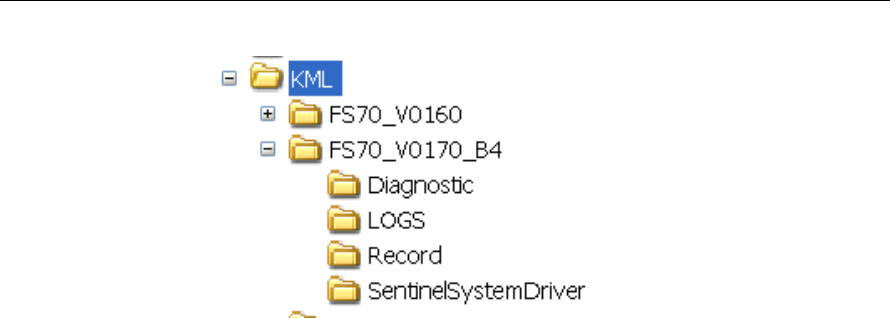
FS70 Trawl Sonar System
86 974-24007001/5.0
You will see the folders for “diagnostic”, “LOGS” and “Record”. Your recordings files are
saved as follows:
Diagnostic folder: Any snapshots that you take
The auto-run four (4) hour recording
LOGS folder: System messages and error messages (automatic)
Record folder: Any recordings that you manually start
All of these files are date and time stamped so you will know exactly when they occurred.
If you have experienced a problem with the system you want to ensure that the auto
recording of the event will not be overwritten. In this event you want to simply move the
file from the “diagnostic” folder and place it into a folder where you will easily be able to
find it. This file should be sent to your service provider at your earliest convenience so that
they can help determine what has caused the problem.
5.4.13 Diagnosing Problems
The usefulness of these tools is greatly enhanced when they are used on a regular basis to
monitor system performance. Records of past system performance (when the unit is
operating properly) provide a basis for comparison that may assist in diagnosing the
problem when an FS system fails.

Troubleshooting and Maintenance
974-24007001/5.0 87
If the FS system develops a problem, or if it fails completely, the steps below should be
followed.
1. Check the power supply unit meters and record their values. If the failure was on power
up, ensure the voltage selection switch is on high and that the power is on. If the system
developed a problem or failed while operating, then note the voltage and current meter
behaviour. If the current meter jitters, then stop the trawl winch if rotating, and note any
changes in the meter values or their behaviour.
2. If the processor unit displays a system test result page then record the values and make note
of any failure (highlighted in red). If not, then implement a system test and record the
results obtained.
3. Disconnect the trawl unit from the trawl cable and re-connect to the FS system using the
test cable, next re-power up the system. If the system failed then you will have to
troubleshoot the problem.
5.4.14 Troubleshooting Problems
The first step in troubleshooting the problem would be to retrieve the “Errors” message log
file located in the KLM directory as indicated in paragraph 5.4.12. The errors log file will
provide some information of what when wrong with the system.
The next step is to understand the “Power up Sequence of Events” when you power up the
FS system. By understanding the system sequence of events it will help you in diagnosing
where the problem may be.
5.4.15 Power up Sequence of Events
What happens when you turn “ON” the Power/TTM?
1. When you turn ON the TTM you apply power to the Pre-Regulator board located in the
sonar head.
2. Next, the pre-regulator board applies power to the main power supply.
3. Next, the main power supply board sets-up the voltages required to run the sonar head.
4. Next the motor will lock up in position “will not rotate freely by hand”.
If the Pre-regulator and Power supply boards are functioning correctly, the TTM panel
meter should indicate 200Vdc and a current of approx 0.20 Amp.

FS70 Trawl Sonar System
88 974-24007001/5.0
Troubleshooting system power problems:
Check TTM Interface unit panel meters for voltage and current, ensure unit is on and
confirm voltage meter indicates 200 VDC.
If no current is indicated then turn power off and disconnect the third wire cable from
the TTM Unit. Check wiring continuity between the MS connector and the 2 pin
connector at the trawl unit. If OK, then the sonar head needs servicing.
5.4.16 Host FS70 Software Start-up Sequence of Events
In this section we will be addressing the telemetry communication and highlighting the
action/problems and the possible causes.
What happens when you start up the host software?
When you start up the FS host software you are establishing “Digital” communication with
the TTM boards located inside the Power/TTM unit.
The communication is established between the PC and the TTM using the host software
commend by clicking on “Detect Head” if the host do not detect the “Head” you will have
to troubleshoot where the problem may be as indicated below.
Troubleshooting head detection problems:
Check COM port is activated in host software. If not, then activate the COM port and
re-detect head.
If head not detected, then check connection between the PC and TTM. If OK, the TTM
needs servicing.
After the host has detected the “digital side” of the TTM board, the “Analog” side of the
TTM board and via the LF1 telemetry board unit completes the downlink communication
through the LF1 telemetry board located in the sonar head.
5.4.17 What happens when you click “RUN”
The next steps after the host software is detected and you hit the “Run” button are:
Cable Calibration
The CPU board will request a series of transmit pulses from the transmitter to initiate the
cable calibration. While this is occurring the surface unit (via the TTM/LF1 board) will
increase/decrease the values (returned signal “echo’s”) via the receiver board and will be
uplinked and written to the Digital-to-Analog Converter “DAC” such that the Gain-Detect

Troubleshooting and Maintenance
974-24007001/5.0 89
(monitor by the TTM) is first detected then intentionally turned off and then detected again
by changing the values being uplinked and re-written back to the DACs. The final values
written to the DACs directly represent what we refer to as the “Cable Gain Numbers” i.e.,
example “6, 23” to compensate for the signal loss through the 3rd wire.
The most important steps regarding the Downlink and Uplink communication between the
host software, the TTM and the sonar head is completed. If any problems were detected
with the TTM/ LF1 telemetry, the LF1 telemetry board in the sonar head, the CPU board,
the transmitter or the receiver boards the cable calibration would have failed.
Motor Calibration
After the downloading of the head parameters is completed the host software via the CPU
board will request a motor calibration. The motor driver board will come online and
calibrate the motor with a series of rotations in order to detect the optocouplers located in
the motor housing and set-up each quadrant. The 4 quadrants and calibration numbers will
be recorded in the host software “info” page.
If the motor calibration fails the problem may be with the motor controller board of the
optocouplers located in the motor housing.
Sensors Info Request
The next step the host must know what is connected to the system in respect to the type of
sensors. A command requesting is downlinked to the head CPU board, the CPU will
request the info from the sensors controller board, e.g., Catch sensors, temp and depth,
Door Spread sensors etc. After the controller board has completed the detection the info is
uplinked back to the host software via the CPU, LF1 telemetry board in the sonar head,
then uplinked to the TTM via the LF1 telemetry board.
After the Host has received the information then the sensors page including the data will be
displayed on the sonar image.
If no sensor information is displayed on the sonar image you may have a problem with the
sensor controller board. If the internal sensors are displayed but no external sensors are
shown then the problem may be with the catch hydrophone receiver or the associated
circuits. If only some of the sensors are displayed you may have a problem with a specific
sensor that was not detected. You will have to troubleshoot the problem.
User Settings
If all OK and no errors are posted into the log files then the host will download the selected
“User Setting” to the head.

FS70 Trawl Sonar System
90 974-24007001/5.0
NOTE: If any of the above host Downlink commands have issued a requested and a
reply is not Uplinked back to the host, those errors are posted in the log file. Therefore
you are having some Downlink or Uplink telemetry problem. If this is the case you
will have to troubleshoot the problem.
The problem may be located in the TTM/LF1 telemetry boards or the LF1 telemetry boards
located in the head. The best way to determine the problem would be to replace the head or
the TTM with a serviceable spare unit.
Problems and the possible causes:
Problem
Action/Possible Cause
Complete system and/or
calibration failure - cable
gain at maximum, telemetry
errors are logged in the file.
Check for telemetry errors. If none, then problem is
with the sonar head or the TTM unit.
Sonar head operates
correctly but pauses
periodically - may not have
sensor module data
Check Message Log for errors. If multiple errors are
present then the internal sensor module may be
defective. Check by restarting the system.
Sonar head operates
correctly but image is
skewed or distorted.
Check for calibration errors in sonar head positioning.
If calibration errors are present then sonar head may
be defective. Otherwise check that sonar head is
properly mounted in trawl housing.
Sonar head operates
correctly but the cable gain
is higher than normal and
telemetry errors may be
present.
Problem may be with the sonar head or the TTM
interface unit.
Replace sonar head and repeat the test. If problem re-
occur then the problem is with the TTM/LF1
otherwise the problem is in the previous sonar head.
No sensor module data.
Internal sensor module electronics is defective.
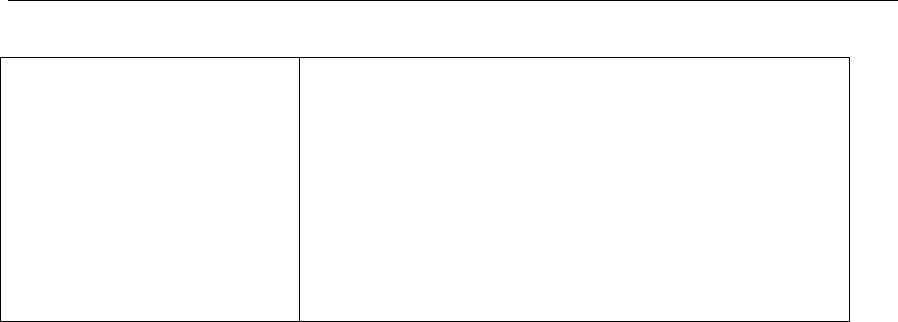
Troubleshooting and Maintenance
974-24007001/5.0 91
No catch indication but
Depth and Temp are OK.
Ensure catch sensors are properly charged and display
of catch data is enabled.
Check unit on deck with catch sensor placed 1 meter
from receive transducer. Connect wire from “+” lug
to metal lid on back of catch sensor, wait a couple
minutes and verify display. If no indication or
indication is wrong, then fault is with the internal
sensor module.
NOTE: If the FS unit is diagnosed as being faulty, then the unit(s) should be
returned to an authorized Simrad service centre. ALL system performance results
and a complete description of the problem should be supplied with the defective unit
to assist in its repair.
5.5 Catch sensors
Refer to your SIMRAD FA or PI Sensor Operator and Service Manual.
5.6 Winch slip-rings and trawl cable
Refer to your Manufacturer Operator and Installation Manual.

FS70 Trawl Sonar System
92 974-24007001/5.0
6 Drawings
Drawings List
436-00411000 - Test Cable
901-60181001 - FS power/TTM Outline Dwg
901-60181003 - FS Power/TTM Wiring Diagram
974-80161000 - FS 70 Housing Dwg (4 Dwgs)
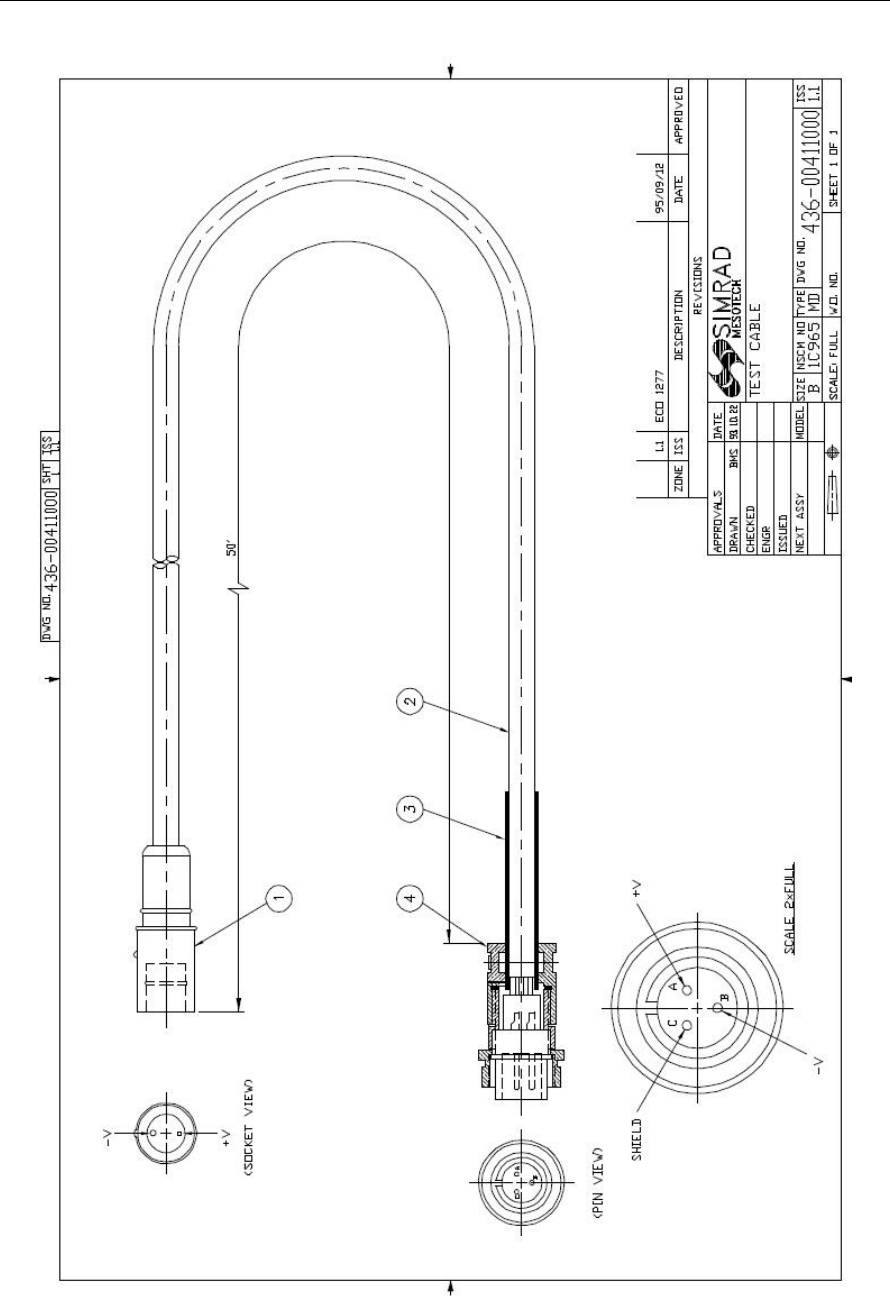
974-24007001/5.0 93
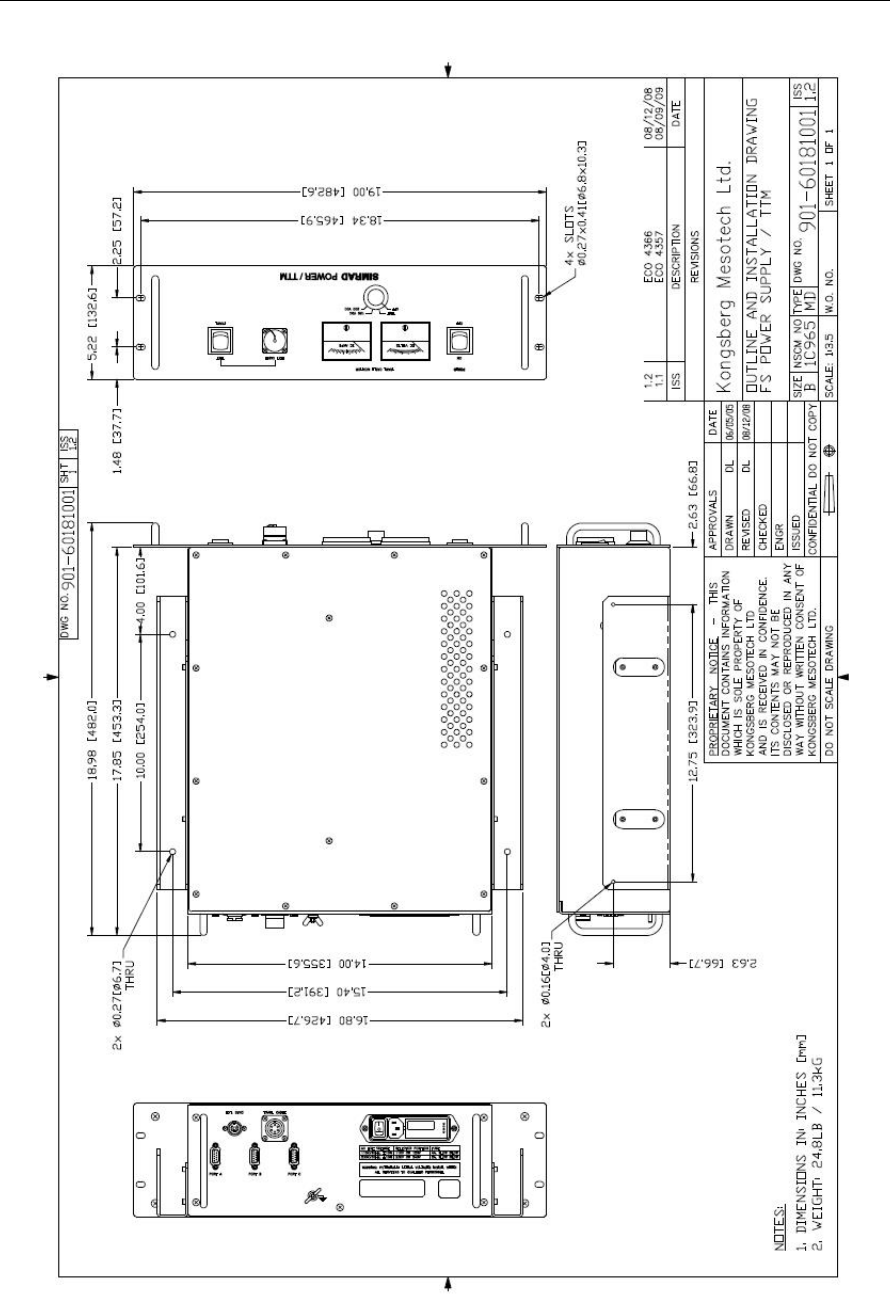
FS70 Trawl Sonar System
94 974-24007001/5.0
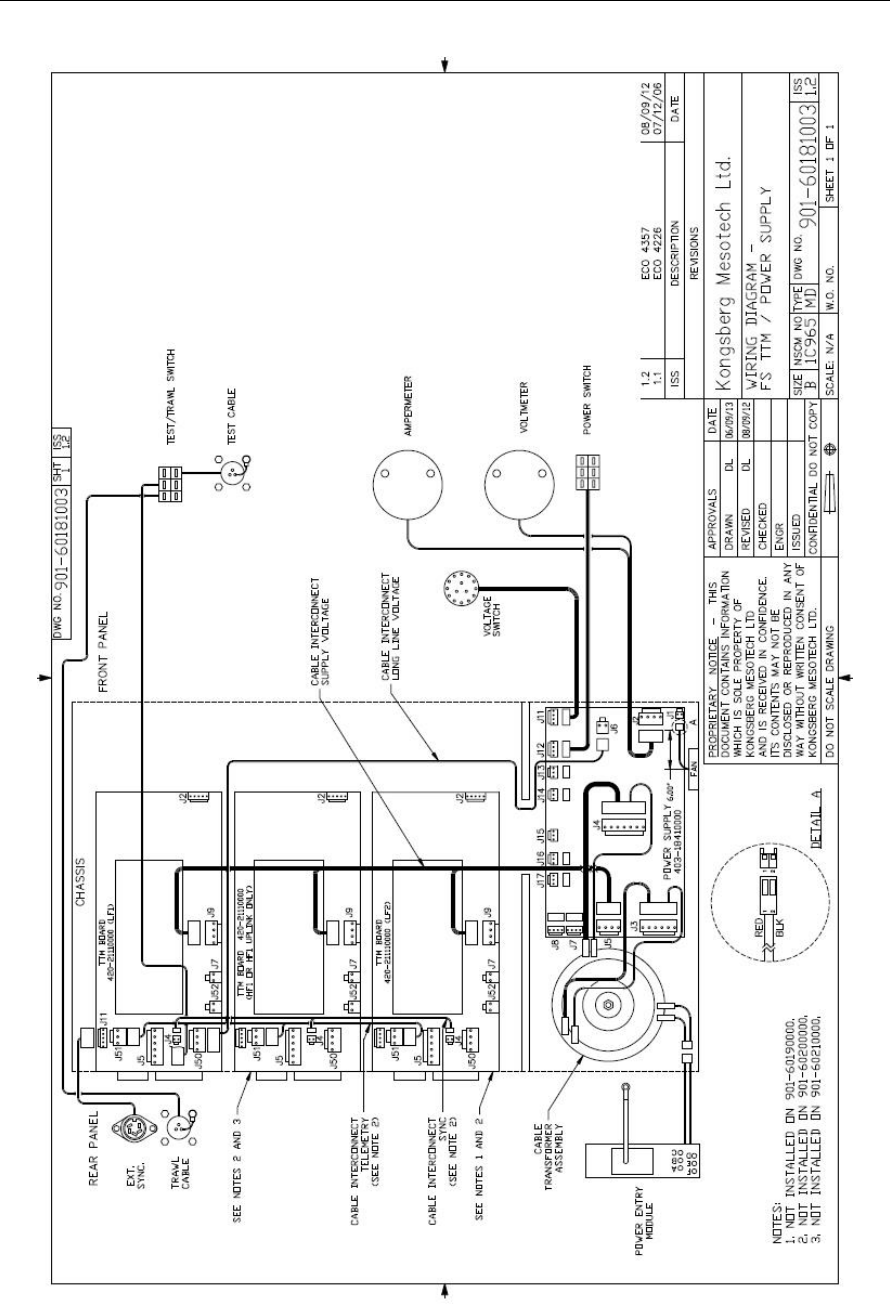
974-24007001/5.0 95
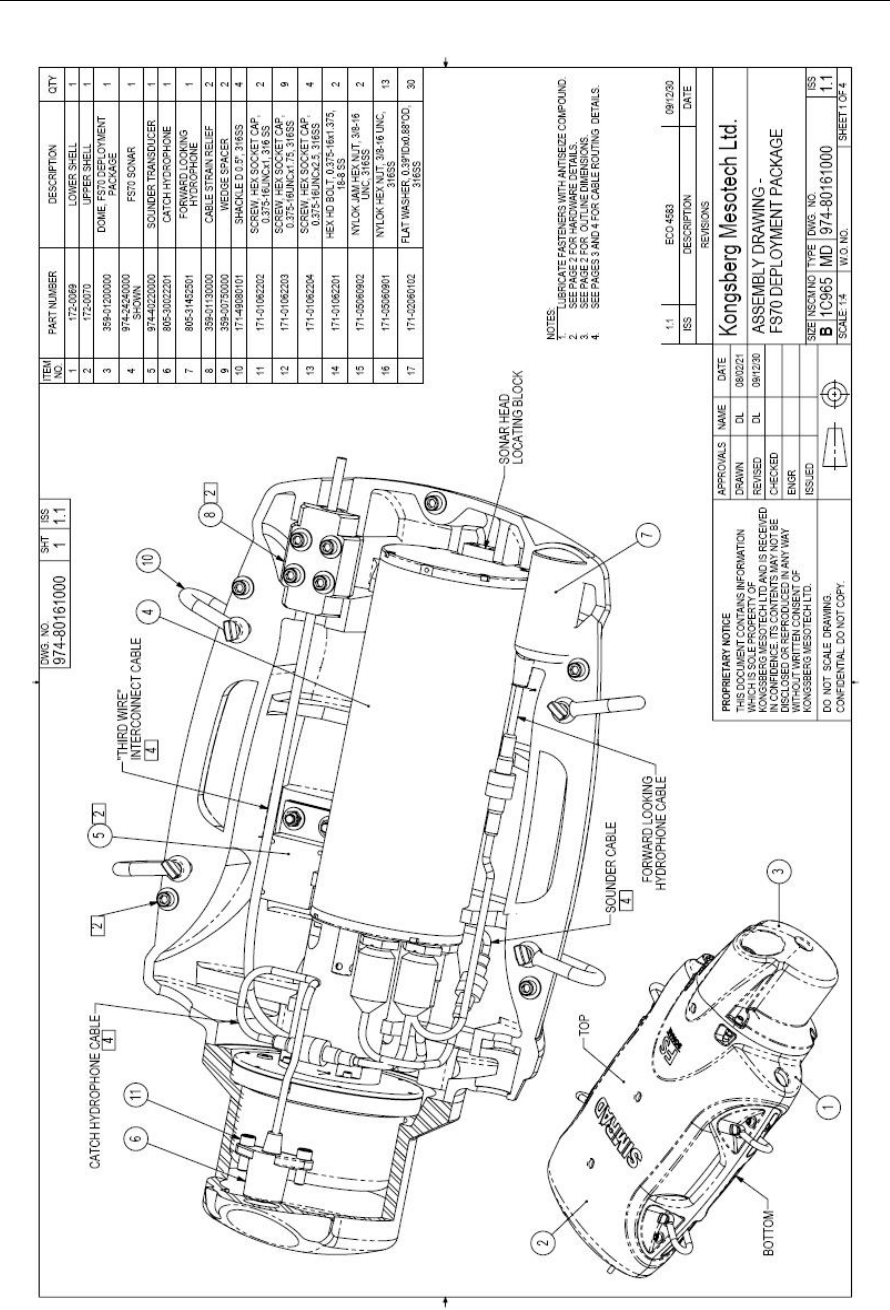
FS70 Trawl Sonar System
96 974-24007001/5.0

974-24007001/5.0 97

FS70 Trawl Sonar System
98 974-24007001/5.0

974-24007001/5.0 99

FS70 Trawl Sonar System
100 974-24007001/5.0
<This page is left intentionally blank>

974-24007001/5.0
101
ANNEX A - FS SONAR TEST REPORT
Boat Name: ________________________________
Head Type: ________________________________________________
Part Number: _______________________ Serial Number: ____________________
Sensor Module Type: _____________________________________________
Part Number: _______________________ Serial Number: ____________________
Cable Gain Cable / Pre-Reg. Voltage
Shop Test Cable: ______________ ____________________
Ship Test Cable: ______________ ____________________
Ship Trawl Cable: ______________ ____________________
Ship 3
rd
wire cable loop resistance: ___________________
Errors Log: __________________________________________________
__________________________________________________
NOTES: __________________________________________________
__________________________________________________
__________________________________________________
Tested by: __________________________ Date: ________________

FS70 Trawl Sonar System
102 974-24007001/5.0
<This page is left intentionally blank>
2010 Kongsberg Mesotech
SIMRAD
